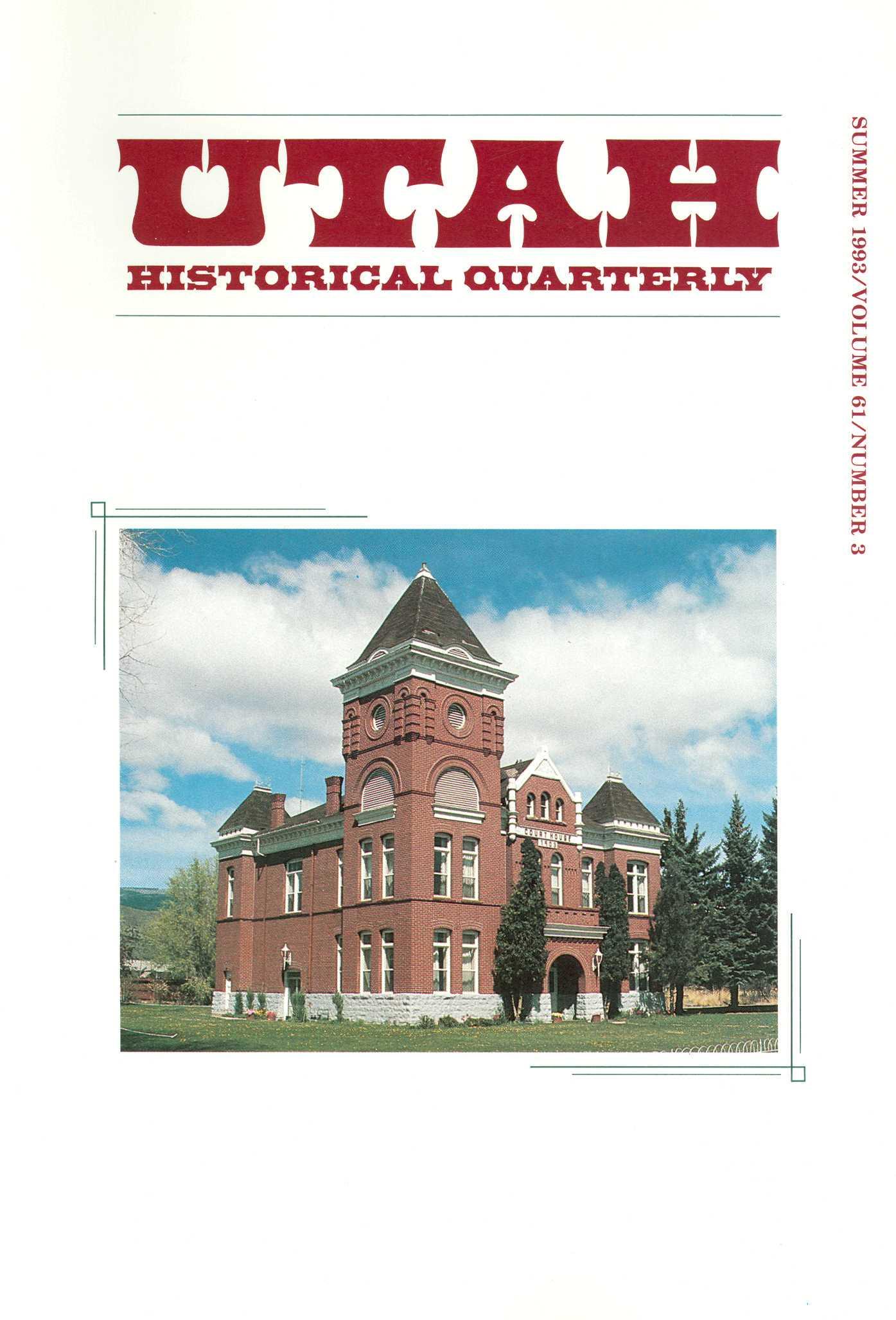
XU S A^CJfU^JJnLX^ a a K x \ < c B M~D
UTAH HISTORICAL QUARTERLY (ISSN 0042-143X)
EDITORIAL STAFF
MAX J EVANS, Editor
STANFORD J LAYTON, Managing Editor
MIRIAM B. MURPHY, Associate Editor
ADVISORYBOARD OF EDITORS
KENNETH L. CANNON II, Salt Lake City, 1995
ARLENE H. EAKLE, Woods Cross, 1993
AUDREY M GODFREY, Logan, 1994
JOEL C JANETSKI, Provo, 1994
ROBERT S MCPHERSON, Blanding, 1995
RICHARD W SADLER, Ogden, 1994
HAROLD SCHINDLER, Salt Lake City, 1993
GENE A. SESSIONS, Ogden, 1995
GREGORY C. THOMPSON, Salt I.ake City, 1993
Utah Historical Quarterly was established in 1928 to publish articles, documents, and reviews contributing to knowledge of Utah's history The Quarterly is published four times a year by the Utah State Historical Society, 300 Rio Grande, Salt Lake City, Utah 84101 Phone (801) 533-6024 for membership and publications information Members of the Society receive the Quarterly, Beehive History, and the bimonthly Newsletter upon payment of the annual dues: individual, $20.00; institution, $20.00; student and senior citizen (age sixty-five or over), $15.00; contributing, $25.00; sustaining, $35.00; patron, $50.00; business, $100.00.
Materials for publication should be submitted in duplicate accompanied by return postage and should be typed double-space, with footnotes at the end. Authors are encouraged to submit material in a computer-readable form, on 5 1/4 inch MS-DOS or PCDOS diskettes, standard ASCII text file. Additional information on requirements is available from the managing editor Articles represent the views of the author and are not necessarily those of the Utah State Historical Society
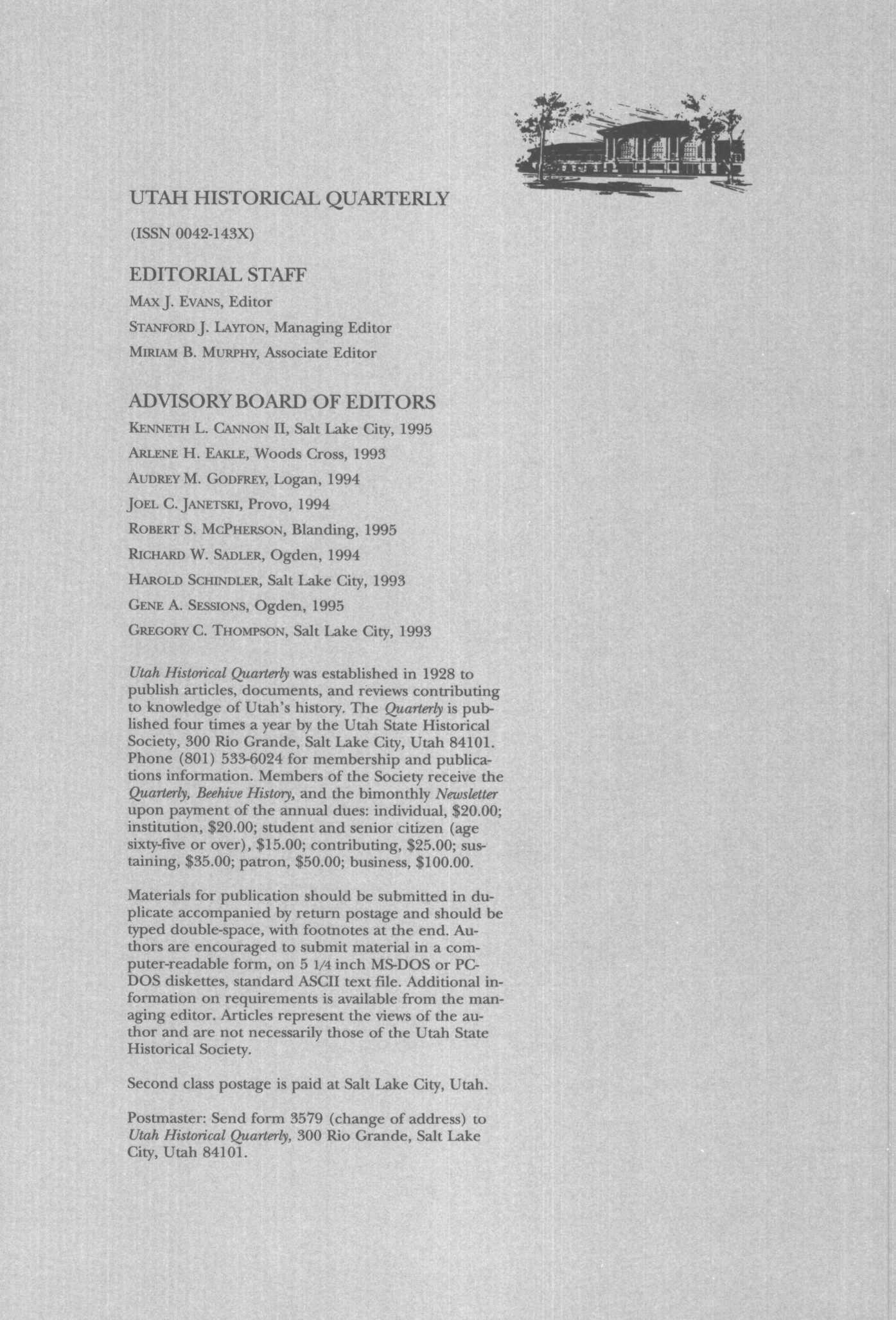
Second class postage is paid at Salt Lake City, Utah
Postmaster: Send form 3579 (change of address) to Utah Historical Quarterly, 300 Rio Grande, Salt Lake City, Utah 84101
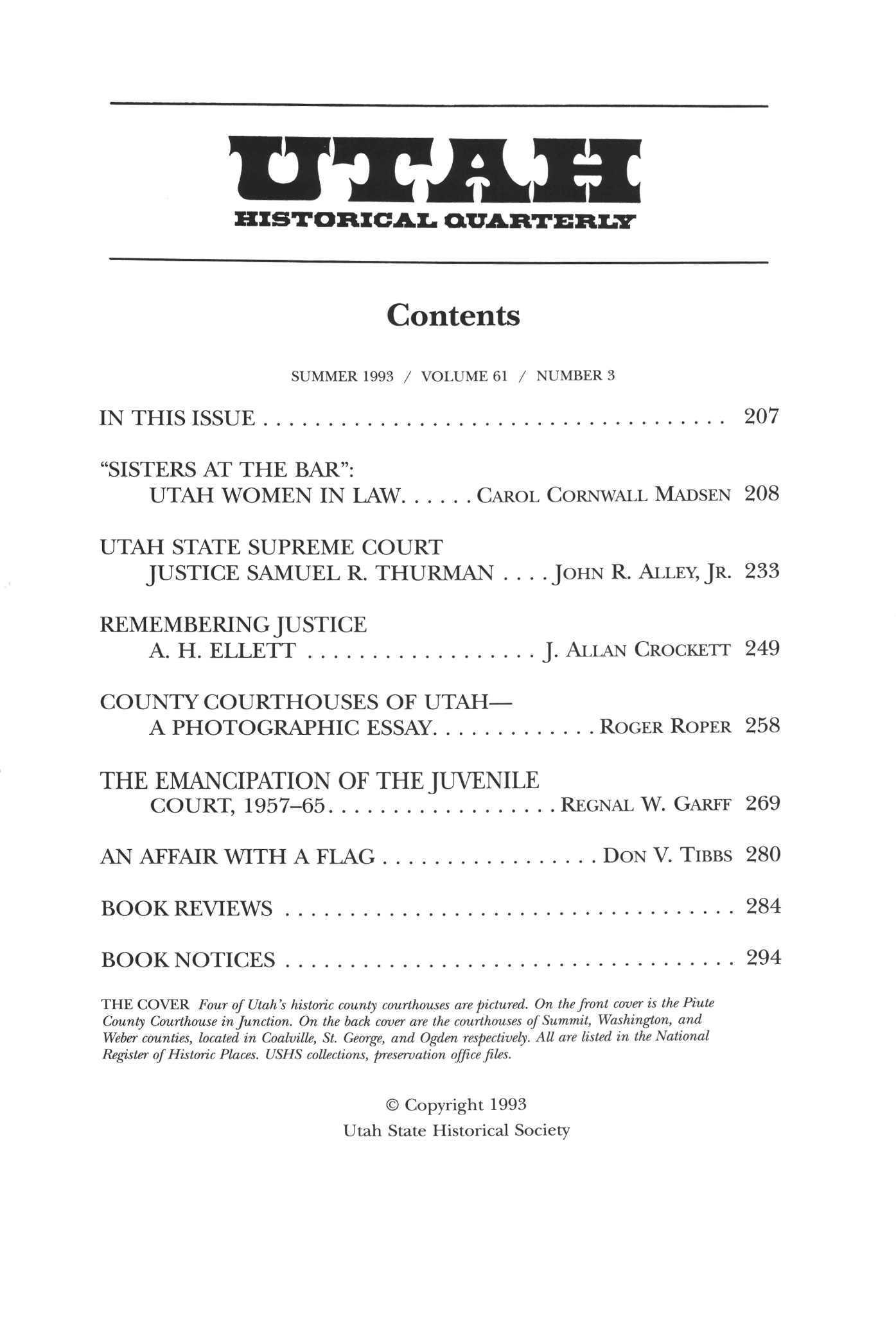
HISTORICA L QUARTERL
Contents SUMMER 1993 / VOLUME 61 / NUMBER 3 IN THIS ISSUE 207 "SISTERS AT THE BAR": UTAH WOMEN IN LAW CAROL CORNWALL MADSEN 208 UTAH STATE SUPREME COURT JUSTICE SAMUEL R. THURMAN JOH N R. ALLEY, JR 233 REMEMBERING JUSTICE A H ELLETT J ALLAN CROCKETT 249 COUNTY COURTHOUSES OF UTAH— A PHOTOGRAPHIC ESSAY ROGER ROPER 258 THE EMANCIPATION OF THE JUVENILE COURT, 1957-65 REGNAL W GARFF 269 AN AFFAIR WITH A FLAG DO N V TIBBS 280 BOOKREVIEWS 284 BOOKNOTICES 294 THE COVER Four of Utah's historic county courthouses are pictured. On thefront cover is the Piute County Courthouse injunction. On the back cover are the courthouses of Summit, Washington, and Weber counties, located in Coalville, St. George, and Ogden respectively. All are listed in the National Register of Historic Places. USHS collections, preservation office files. © Copyright 1993 Utah State Historical Society
Y
RICHARD E. WESTWOOD Rough-water Man: Elwyn Blake's Colorado River Expeditions JIM ATON 284
RONALD L. HOL T Beneath These Red Cliffs: An Ethnohistory of the Utah Paiutes JOEL C. JANETSKI 285
B CARMON HARDY Solemn Covenant: The Mormon Polygamous Passage KENNETH L. CANNON II 286
STAN LARSON, ed. Prisonerfor Polygamy: The Memoirs and Letters of Rudger Clawson at the Utah Territorial Penitentiary, 1884-87 WILLIAM C. SEIFRIT 288
ANNIE M. SMITH. Ute Tales ALAN D. REED 289
M. CATHERINE MILLER Flooding the Courtrooms: Law and Water in the Far West CRAIG FULLER 290

EDWARD A. GEARY. The Proper Edge of the Sky: The High Plateau Country of Utah MELVTN T. SMITH 291
MARIA S. ELLSWORTH, ed. Mormon Odyssey: The Story of Ida Hunt Udall, Plural Wife Jo AN WASHBURN 293
Books reviewed
In this issue
Desiring to promote the history of Utah law and courthouses, the Utah Bar Foundation approached the Utah State Historical Society last year and proposed a joint effort in the production of a special issue of Utah Historical Quarterly. Working together in the call for and refereeing of papers, the two agencies gathered a half-dozen articles that represented the diversity, complexity, and significance of the legal experience in Utah.
A detailed look at the role of women in shaping the state's legal institutions, two biographical sketches, a photo essay on National Register courthouses, an analysis of the juvenile court's evolution, and a judge's lighthearted personal reminiscence were among the topics finally selected.
The Utah Bar Foundation was incorporated December 13, 1963, as a nonprofit corporation. Every attorney licensed to practice law in the state is a member It uses income from gifts, donations, bequests, devises, membership contributions, and interest on lawyer trust accounts to further its many public-service goals. These include projects related to public education regarding the law, legal services to the public including those who might not otherwise be able to obtain professional representation, programs at institutions of higher learning, and charitable and other worthy causes.
Comstock Clayton Foundation, sponsored by Calvin A. Behle, one of the original founders of the Foundation, and his wife Hope, contributed funds to pay for some nice aesthetic touches for this publication, including the full-color cover and a special over-run of 500 cloth-bound copies
As the Utah Bar Foundation approaches its thirtieth anniversary, the Behles and other members can point with special pride to this issue as another entry in their catalog of notable achievements
 Utah Bar Foundation standing: Carman E. Kipp, Kipp & Christian; Richard C. Cahoon, Marsden, Orion & Cahoon; James B. Lee, Parsons Behle & Latimer; Stephen B. Nebeker, Ray, Quinney & Nebeker; seated: Ellen M. Maycock, Kruse, Landa & Maycock; Hon. Norman H. Jackson, Utah Court of Appeals; Jane A. Marquardt, Marquardt, Hasenyager & Custen.
Photograph by Robert L. Schmid.
Utah Bar Foundation standing: Carman E. Kipp, Kipp & Christian; Richard C. Cahoon, Marsden, Orion & Cahoon; James B. Lee, Parsons Behle & Latimer; Stephen B. Nebeker, Ray, Quinney & Nebeker; seated: Ellen M. Maycock, Kruse, Landa & Maycock; Hon. Norman H. Jackson, Utah Court of Appeals; Jane A. Marquardt, Marquardt, Hasenyager & Custen.
Photograph by Robert L. Schmid.
"Sisters at the Bar": Utah Women in Law
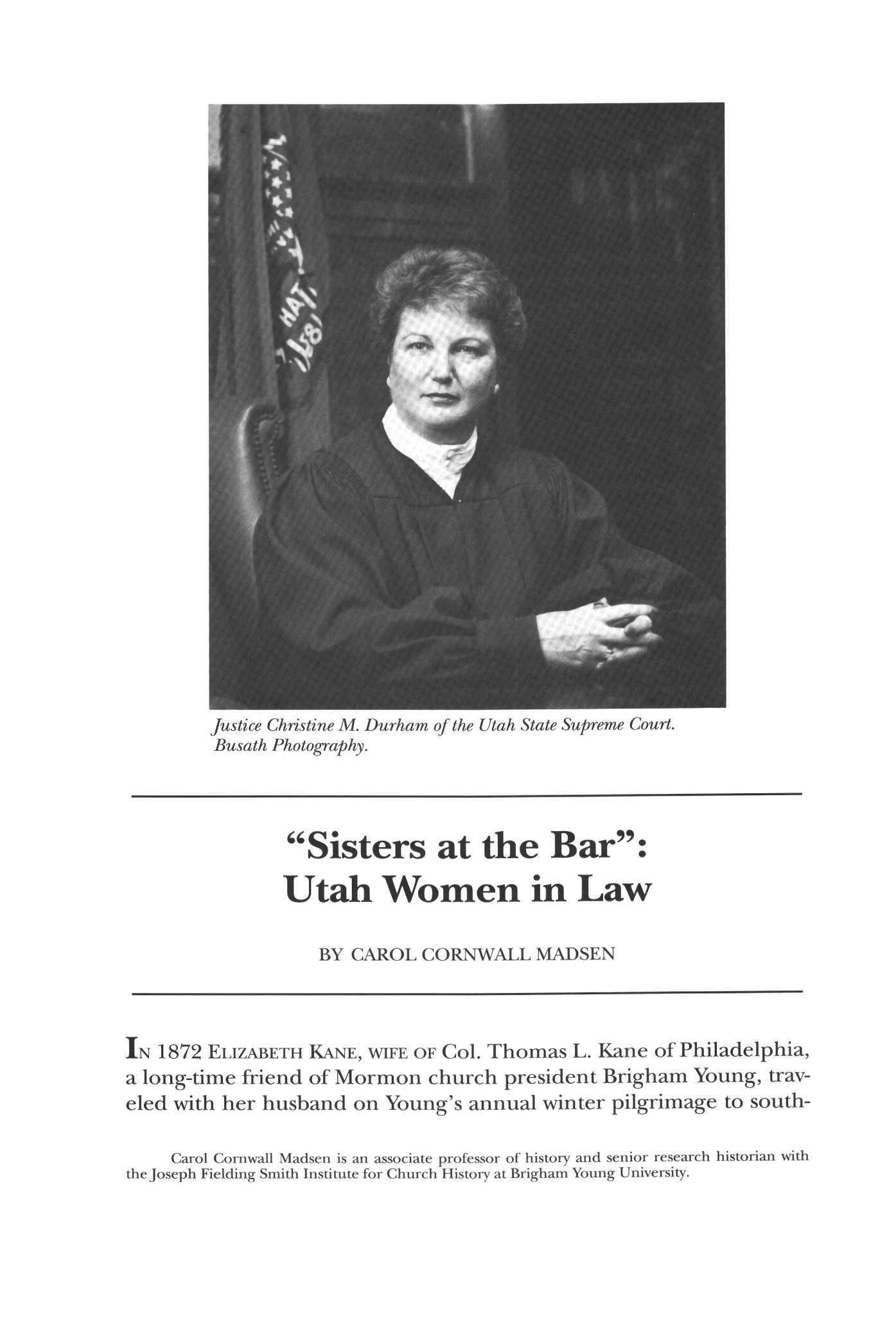 BY CAROL CORNWALL MADSEN
BY CAROL CORNWALL MADSEN
I N 1872 ELIZABETH KANE, WIFE OF Col. Thomas L. Kane of Philadelphia, a long-time friend of Mormon church president Brigham Young, traveled with her husband on Young's annual winter pilgrimage to south-
Cornwall Madsen is an associate professor of history and senior research historian with the Joseph Fielding Smith Institute for Church History at Brigham Young University
fustice Christine M. Durham of the Utah State Supreme Court. Busath Photography.
Carol
ern Utah After visiting numerous Mormon communities along the way she observed, "They close no career on a woman in Utah by which she can earn a living."1 Indeed, frontier Utah erected few legal or social barriers against women's entry into gainful employment, including the so-called learned professions of law, medicine, and higher education. Although this flexibility reflected the exigencies of a developing community, it also demonstrated the assumption that women were capable of such learning, a view that did not enjoy a consensus in nineteenth-century America. At a time when respected voices in the medical profession warned that the rigors of education would unbalance women's physiological makeup, women who chose professional training did so at a perceived risk. Ever pragmatic, Brigham Young countered these prevailing theories and encouraged women to study law, medicine, and other branches of learning to meet Utah's need for their professional contributions.2
The story of Utah women's entry into law isjust one chapter in a larger story that features women willing to push against the constraints of social custom and claim a place in the professional world, reaping disapproval, ridicule, and, frequently, social isolation in the struggle. Although many of the legal barriers to women's right to occupational choice began falling throughout the country soon after the beginning of this century, it has been only in the last two decades that the social and attitudinal impediments that have prevented women from entering the mainstream of professional life have significantly diminished
The entry of women into the work force introduced a variety of complex gender issues, many of which were unique to professional women It raised questions of propriety as well as capability even as it defined new ways for women to relate to society, forcing new interpretations of woman's sphere and those elements of cohesiveness that characterized the female culture.3 Subject to the same discriminatory
1 Elizabeth Wood Kane, Twelve Mormon Homes Visited in Succession on aJourney through Utah to Arizona (Salt Lake City: Tanner Trust Fund, University of Utah Library, 1974), p 5
2 Brigham Young, Sermon in the Old Tabernacle, July 18, 1869, reported by David W Evans, Journal of Discourses, 20 vols (Liverpool, 1871), 13:61
3 As delineated by Joan Jacob Brumberg and Nancy Tomes in "Women in the Professions: A Research Agenda for American Historians," Reviews in American History 10 (June 1982): 275-96, professional women represented a commitment to education, independence, and personal aspirations that exceeded or even contravened the economic rationale for most working women Th e authors raise questions about the tension between the methods and approaches of the professional and nonprofessional or volunteer woman Th e theory that women wielded more political power and public influence through a separate female culture than through integration into traditionally male public institutions and professions is advanced by Estelle Freedman in "Separatism as Strategy: Female Institution Building and American Feminism, 1870-1930," Feminist Studies 3 (Fall 1979): 512-29
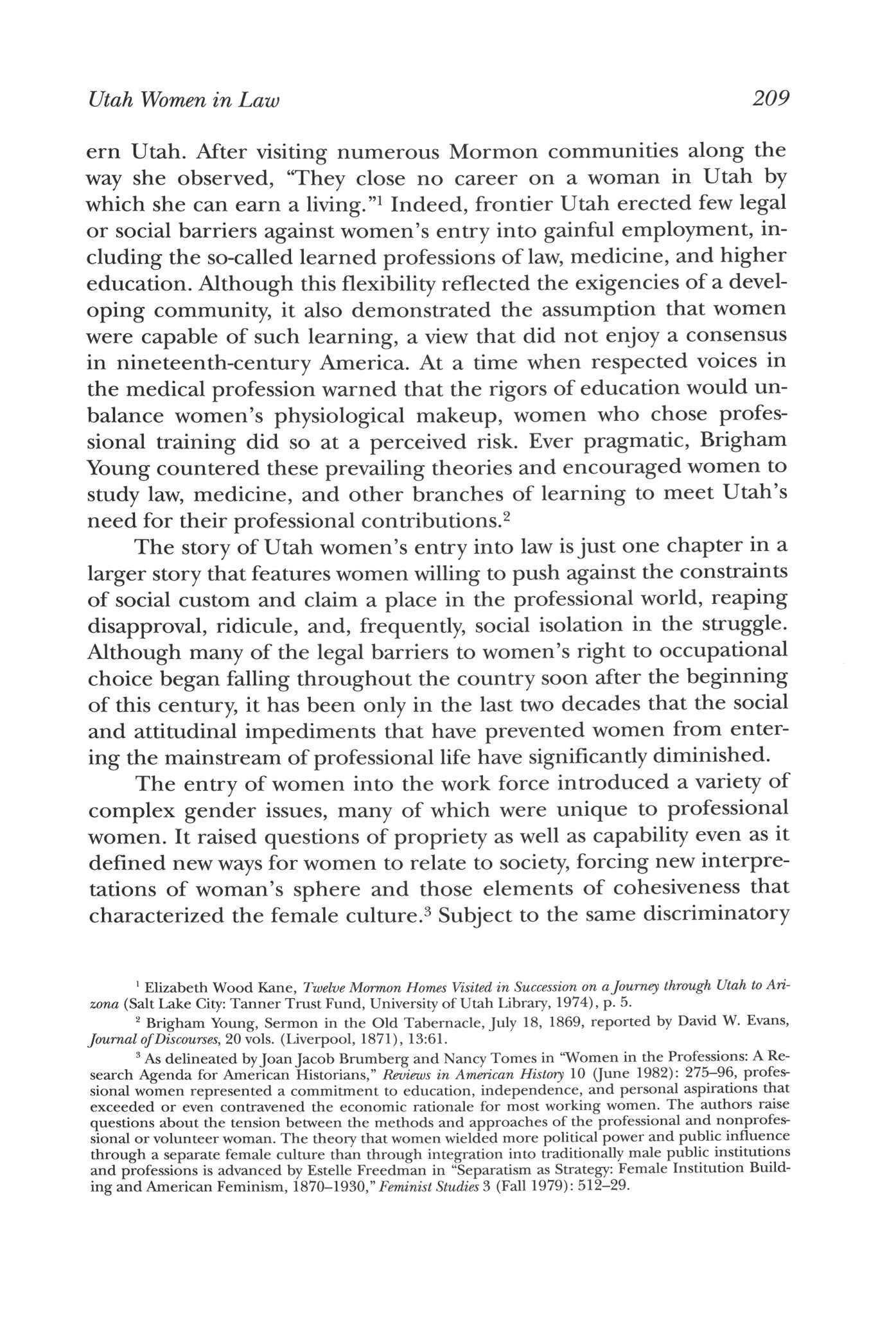
Utah Women in Law 209
practices aswomen wage earners, professional women also faced legal and educational barriers as well as persistent social disapproval unknown to their working class sisters The distinction between jobs and careers involved more than class differences. The professions pitted men and women against each other in competitive arenas dominated by male rules, male institutions, and male values. The story of women in the professions is not only an account of their struggle to claim a portion for themselves but a story of the significant impact their presence is making, particularly in the field of law.
Not until after the Civil War did women mount serious attempts to enter the professional fields Barriers to entry were different in the various professions and the progress of women in each followed different routes Utah was among the first in the nation to permit women into the learned professions, but beyond the entry point the historical development in Utah generally paralleled that of the rest of the country.
Unlike those who entered higher education and medicine, women who chose law as a profession encountered major legal restraints. Under the common law married women could not act as independent legal entities and were thus unable to make contracts, sue, write wills, and own or convey property in their own name. Married women could not, therefore, enter into contracts with their clients or sue on their behalf, a common law disability similarly extended to single women who desired to become lawyers Moreover, neither married nor single women were eligible to vote or hold office under the common law, a restriction that was interpreted in most states to include the position of attorney, who was an officer of the court.4 Some state statutes expressly prohibited women's admittance to the bar or contained masculine pronouns in delineating qualifications for lawyers (indicating the "intent" of lawmakers).
The experience of BelvaAnn Lockwood in obtaining law training and admission to practice demonstrates the obstacles that faced women of her generation Refused admission to the law school of Columbian College (later George Washington University) and Georgetown and Howard universities, she gained acceptance to the National
4 In some cases this objection was overturned. See Kilgore v. The State of Pennsylvania as quoted in D Kelly Weisberg, "Barred from the Bar: Women and Legal Education in the United States, 1870-1890, "Journal of Legal Education 28 (1977): 489 In other instances this restriction, relating only to married women, did not inhibit some judges from ruling against any woman, married or single, from admission to practice

210 Utah Historical Quarterly
University Law School in Washington, D.C., in 1871.Despite completing the course two years later, she was awarded a diploma only after appealing to U.S. President Ulysses S. Grant, ex-officio president of the law school. She was then admitted to the bar of the District of Columbia When one of her legal cases reached a federal Court of Appeals, however, her right to plead was denied because, the court ruled, "a woman is without legal capacity to take the office of attorney."5 Her application to the U.S. Supreme Court in 1876 was similarly denied The ruling could be changed only by congressional legislation. Finally, in March 1879, after three years of lobbying, Belva Lockwood became the first woman admitted to the highest court of the land. It took several more years before she was admitted to practice in her native state of New York.6
Of the three learned professions, the law seemed most incongruous with the prevailing notions of womanhood. This psychological barrier was constructed from contemporary theories of woman's dependence upon emotion and intuition rather than intellect, a characteristic clearly impairing woman's performance in the legal sphere, it was assumed. Additionally, a woman's limited physical capacity, it was argued, would naturally preclude the intense concentration and long working hours required by the profession Moreover, common wisdom affirmed that male competitiveness and aggressiveness, foreign to feminine nature, best served the practice of law.7
Most formidable, the profession represented a role conflict of immense proportions As one nineteenth-century critic argued:
How would a lawyeress be able to consult with her clients, when she was attacked by the nausea of the first few months of pregnancy? And afterward what a figure she would make in court, when, the months of interesting situation being advanced, her curved lines become crushed with an anterior round line? And if the pains should come upon her in the heat of argument! That would be fine indeed! Would she invite her
5 Quoted in Thomas Woody, A History of Women's Education in the United States, 2 vols (New York: Science Press, 1929), 2:378.
6 Edward T James, Janet Wilson James, and Paul S Boyer, eds., Notable American Women: A Biographical Dictionary, 1607-1950, 3 vols. (Cambridge: Harvard University Press, 1971), 2:413-16; see also Julia Davis, "Belva Ann Lockwood, Remover of Mountains," American Bar Association Journal 65 (June 1979): 924-28
7 Barriers to female entry into the legal profession are discussed in more detail in Ellen Spencer Mussey, "Women Attorneys," American Bar Association Journal 9 (January 1923): 62-63; Weisberg, "Barred from the Bar," pp 486-93; Kathleen E Lazarou, "'Fettered Portias': Obstacles Facing Nineteenth-century Women Lawyers," Women LawyersJournal 64 (Winter 1978): 21-30: Patricia M. Hummer, The Decade of Elusive Promise, Professional Women in the United States, 1920-1930 (Ann Arbor: UMI Research Press, 1976), pp. 43-49; Woody, History of Women's Education, 2:378-80.

Utah Women in Law 211
colleagues to serve her as midwives? And in childbirth, farewell to business! Poor clients! I assure you that I laugh to myself thinking of the ridiculous figure that a woman lawyer would make. 8
Women's maternal and domestic duties were more than female occupations to the nineteenth-century mind; they were identifying characteristics, and it was a conceptual leap of some magnitude to separate women from these functions.
Legal or social barriers emerged in all aspects of women's attempt to become lawyers: acquiring a legal education, gaining admittance to the bar, and practicing. Arabella Mansfield was one of the few women in the beginning to meet success. In 1869, having studied law privately with her husband, she became the first woman to be admitted to a state bar, Iowa, because the district courtjudge who ruled on her application was willing to construe the male pronouns relating to qualifications of lawyers as inclusive of women. 9 Ada Keply was not so fortunate After graduating in 1870 with the distinction of being the first woman graduate of a law school, the Union College of Law (now Northwestern), she was refused admittance to the Illinois Bar.10
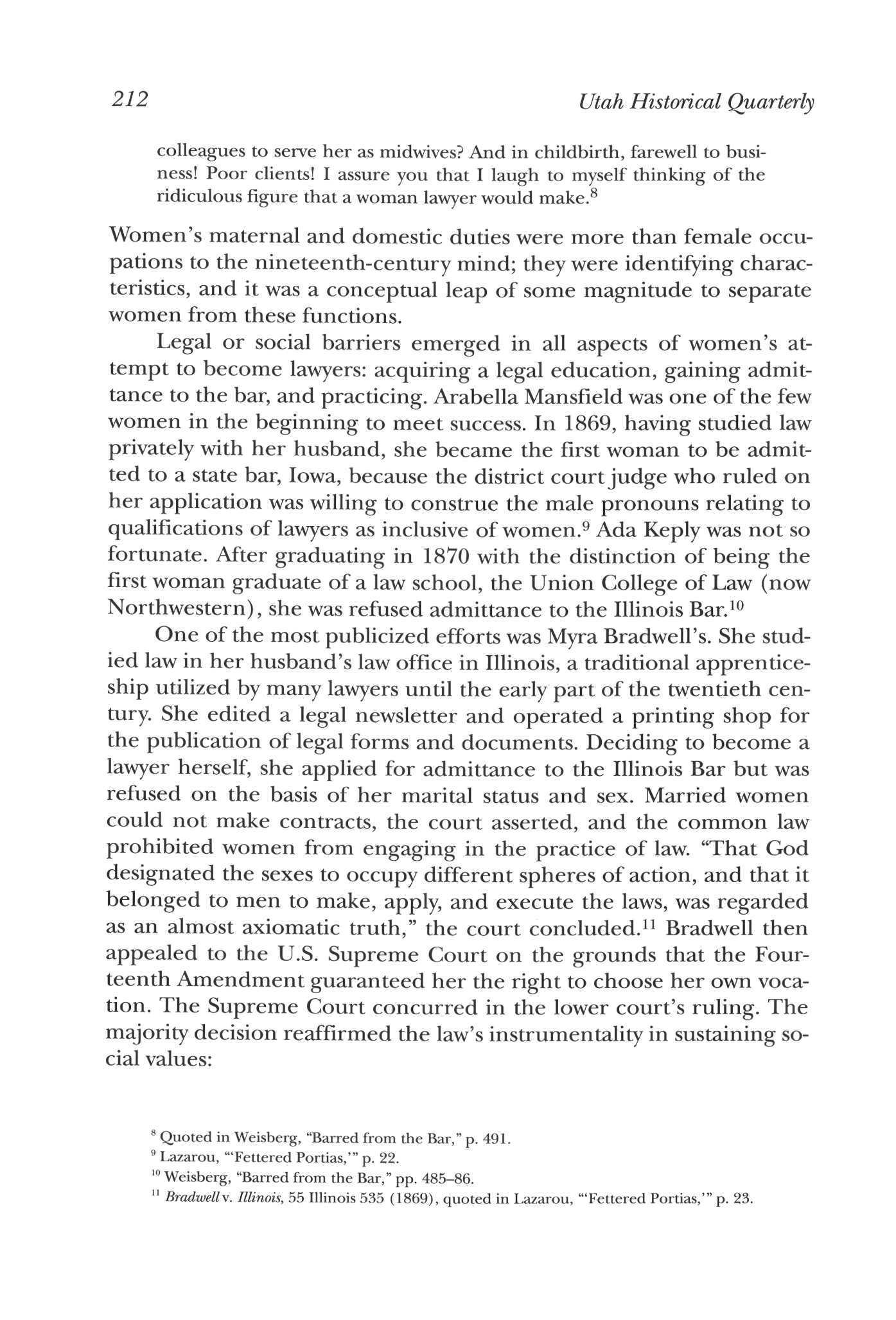
One of the most publicized efforts was Myra Bradwell's. She studied law in her husband's law office in Illinois, a traditional apprenticeship utilized by many lawyers until the early part of the twentieth century. She edited a legal newsletter and operated a printing shop for the publication of legal forms and documents Deciding to become a lawyer herself, she applied for admittance to the Illinois Bar but was refused on the basis of her marital status and sex Married women could not make contracts, the court asserted, and the common law prohibited women from engaging in the practice of law "That God designated the sexes to occupy different spheres of action, and that it belonged to men to make, apply, and execute the laws, was regarded as an almost axiomatic truth," the court concluded.11 Bradwell then appealed to the U.S. Supreme Court on the grounds that the Fourteenth Amendment guaranteed her the right to choose her own vocation. The Supreme Court concurred in the lower court's ruling. The majority decision reaffirmed the law's instrumentality in sustaining social values:
Quoted in Weisberg, "Barred from the Bar," p 491 Lazarou, "'Fettered Portias,'" p 22
0 Weisberg, "Barred from the Bar," pp. 485-86.
1 Bradwellv. Illinois, 55 Illinois 535 (1869), quoted in Lazarou, "'Fettered Portias,'" p 23
212 Utah Historical Quarterly
The claim of the plaintiff, who is a married woman, to be admitted to practice as an attorney and counselor at law, is based upon the supposed right of every person, man or woman, to engage in any lawful employment for a livelihood The claim assumes that it is one of the privileges and immunities of women as citizens [under the 14th amendment] to engage in any and every profession, occupation or employment in civil life.
It certainly cannot be affirmed, as a historical fact, that this has ever been established as one of the fundamental privileges and immunities of the sex. On the contrary, the civil law, as well as nature herself, has always recognized a wide difference in the respective spheres and destinies of man and woman Man is, or should be, woman's protector and defender. The natural and proper timidity and delicacy which belongs to the female sex evidently unfits it for many of the occupations of civil life. The constitution of the family organization, which is founded in the divine ordinance, as well as in the nature of things, indicates the domestic sphere as that which properly belongs to the domain and function of womanhood. The harmony, not to say identity, of interest and views which belong or should belong to the family institution, is repugnant to the idea of a woman adopting a distinct and independent career from that of her husband. 1 2
An attempt by Lavinia Goodell to join the bar in Wisconsin elicited the same type of sociolegal response that focused primarily on law as an undesirable vocation for women:

There are many employments in life not unfit for the female character The profession of law is surely not one of these The peculiar qualities of womanhood, its gentle graces, its quick sensibility, its tender susceptibility, its purity, its delicacy, its emotional impulses, its subordination of hard reason to sympathetic feeling, are surely not qualifications for forensic strife Nature has tempered woman as little for the juridical conflicts of the court room as for the physical conflicts of the battlefield.13
The rulings were already defensive, however. Within a decade after Goodell lost her appeal, twelve states and territories and the District of Columbia admitted women to the bar through judicial decree while eight additional states did so through revised legislation.14 They
12 Bradwellv. Illinois, 83 U.S 130 (1873)
13 In re Goodell, 39 Wis> 232 (1875)
14 States admitting women through judicial enactment were Iowa, Missouri, Michigan, Utah, Maine, Indiana, Kansas, Connecticut, Nebraska, Washington Territory, the United States Circuit and District Courts in Illinois and Texas, and the District of Columbia Those awaiting legislative action were Illinois, California, Minnesota Massachusetts, Oregon, Wisconsin Ohio, and New York See Ellen A Martin, "Admission of Women to the Bar," Chicago Law Times 1 (November 1886): 76-92, as reprinted in Lazarou, "'Fettered Portias,'" p 30
Utah Women in Law 213
had all capitulated to the unremitting efforts of women applicants to bring the law into step with a society that was slowly beginning to respond to women's changing legal status and their demands for a greater public role.
Throughout the nineteenth century the study and practice of law were nonstandardized and generally unregulated There were no uniform licensing procedures or standards, no conformity among the law schools that then existed, and only a minimum amount of reading or training with an attorney required for admittance to a state bar Admission to most bars required no legal examination and no evidence of training, only a recommendation from a practicing attorney vouching for the candidate's moral character rather than his legal competence. Until well into this century few states required attendance at a law school or a law degree for admittance to the bar.15
Nevertheless, the number of law schools grew from 31 in 1870 to 124 in 1910, along with the development of degree-conferring curriculums. Some began to open their doors to women. 16 Most women, however, received their training in the part-time law schools, 2 of which were exclusively for women: the Portia School of Law in Boston and the Washington College of Law in Washington, D.C. In 1890 there were only 10 part-time schools with 537 students, but their number grew to 64 by 1916, enrolling 10,734 students, almost as many as in the 76 full-time law schools.17
As more universities and colleges established law schools, they also developed stringent admission policies and uniform curricula. Standardized class work among the more prestigious eastern schools became de rigueur in response to a drive in 1893 by the Section on Legal Education of the American Bar Association. The Association of American Law Schools, established in 1890, also focused its attention on improvement in legal education. The part-time schools, unable to compete, lost acceptability as legal training fields. Women were a casualty of this development.
With the rise of professional law schools, independent study or apprenticing also lost favor. Would-be lawyers were forced to turn to the law schools for training. The two major regulatory associations,
15 Carnegie Foundation for the Advancement of Teaching, Seventh Annual Report (1922), p 86, as quoted in Hummer, Decade of Elusive Promise, p 47
16 Among the first were Union College (1870); Michigan (1871); Washington University, St Louis (1871); Harvard University (1872); Iowa State (1873); National University, Washington, D.C (1873) See Weisberg, "Barred from the Bar," p 494
17 In 1916 there were 76 regular day schools enrolling 11,469 students

214 Utah Historical Quarterly
the American Bar Association and the Association of American Law Schools, had succeeded by 1920 in making three years the standard period for law training leading to a degree and had insured that by 1925 at least two years of college education were requisite for entrance to law school. Some few states continued to require only study in a law office for bar candidacy. Approved law schools that still prohibited women in 1920 were Catholic University, Columbia, Harvard, University of Florida, and Washington and Lee.18 Not until 1972 were women admitted to all ABA approved law schools.19
Fewer women actually practiced law than studied it. Not until 1920 did states begin to pass statutes requiring law school training for bar admission, and not until then had all states except Delaware removed restrictions against women's admission to their bar associations.20 However, after admission to the bar, women faced additional impediments in associating with law firms and attracting clients Often less well trained than their male counterparts, they had to prove their ability "It undoubtedly requires the courage of one's convictions to enter upon a field where opposition is so strong," wrote one early woman lawyer.21 Those with male relatives in the profession fared best, assisting lawyer husbands or fathers in writing briefs or devoting themselves "chiefly to office work." Some moved into law-related fields or public law. Others went west where they faced less discrimination and the profession as a whole had more opportunity for expansion. A fifth of the women lawyers before the turn of the century never practiced at all.22

The 1878 organization of the American Bar Association was a response to similar local and state organizations. It remained an elitist group for many years, however, attracting lawyers primarily from the more prestigious eastern law schools As late as 1900, of the 113,460 lawyers practicing in the nation, only 1,540 belonged to the ABA No women were allowed tojoin until 1918
18 Bureau of Vocational Information, Training for the Professions (Washington, D.C: Government Printing Service, 1924), p 432-33
19 Donna Fossum, "Women in the Legal Profession: A Study of Social Change" (Ph.D diss., University of New York at Buffalo, 1981), p 3
20 Hummer, Decade of Elusive Promise, pp 47-48
21 Marion Weston Cottle, "The Prejudice against Women Lawyers: How Can It Be Overcome?" Case and Comment 21 (October 1914): 372, as quoted in ibid., p. 48.
22 Weisberg, "Barred from the Bar," pp 494-97
Utah Women in Law 215
Shut out from the networking and support system that membership in the ABA provided, women lawyers formed the National Association
of Women Lawyers in 1910 and the next year published the first issue of the Women LawyersJournal. Many women lawyers refused tojoin, fearful that its existence would either deter or erase the possibility of membership in the ABA. Eight years later, when the ABA opened its doors to women, many of those who joined also retained membership in the women's association. An early issue of the Journal outlines appropriate etiquette and dress for the woman lawyer at the turn of the century:
The principal drawbacks to a woman's success when pitted against man in the legal battle are to be found in the handicaps of sex. The voice, physical appearance, and attire of the average woman lawyer do not produce the impression of authority and aggressiveness which are characteristic of the average man lawyer Legal ability alone cannot make up for lack of power and authority, and the woman who would succeed in jury trials should bear in mind the fact that one of the chief ways of impressing an audience is through the speaker's voice A highpitched, nervous-sounding voice carries little conviction with it, and the woman jury lawyer should, if necessary, prepare herself for her work by a special course of training in the art of effective speaking
In regard to her personal appearance, there are several things which the woman trial lawyer will do well to observe She should never appear in court in anything but a dignified street costume, and it is advisable that she should remove her hat before addressing the judge The tendency on the part of women to feel that their sex entitles them to receive, rather than to pay, deference should never be allowed in the court room. 2 3
In Utah the experience of women in law diverged somewhat from the national pattern. The practice of law was not highly regarded by the American public generally, but it met no stronger opposition than in territorial Utah. The Mormon experience with the law had been frustrating and disappointing, engendering distrust of lawyers as well as the legal system. Though he later supported the study of law, Brigham Young did not mince words in describing his feelings toward lawyers in 1852:

To observe such conduct as many lawyers are guilty of, stirring up strife among peaceable men, is an outrage upon the feelings of every honest, law abiding man To sit among them is like sitting in the depths of hell, and their hearts are as black as the ace of spades They love sin, and roll it under their tongues as a sweet morsel, and will creep around like wolves in sheep's clothing, and fill their pockets with the
23 Women LawyersJournal (May 1911), n.p., as quoted in D X Fenten, MS. Attorney (Philadelphia: Westminster Press, 1974), pp 33-34
216 Utah Historical Quarterly
fair earnings of their neighbors, and devise every artifice in their power to reach the property of the honest, and that is what has caused these courts.24
That same year the Utah Legislative Assembly almost legislated the legal profession out of existence An act regulating attorneys provided that a man or woman (italics added) could act as attorney for himself or herself or could choose any person of good moral character to represent him or her.25 Even more unusual than this grant of legal power to non-lawyers was its application to women. The statute empowered Utah women to act as counsel not only for themselves but for others. There is little evidence that women availed themselves of this privilege although the diary of MarthaJane Knowlton Coray suggests the possibility that she might have assisted a friend in court in 1874 under the provisions of this act.26 Nevertheless, there were lawyers in Utah, and legislators did establish qualifications for practice, primarily proof of good moral character and a favorable report of an examining committee to that effect. If an applicant had been admitted to the highest court of another territory or state, proof of that sufficed for admittance to the Utah Bar. The statute contained no prohibitive language relative to women. 27
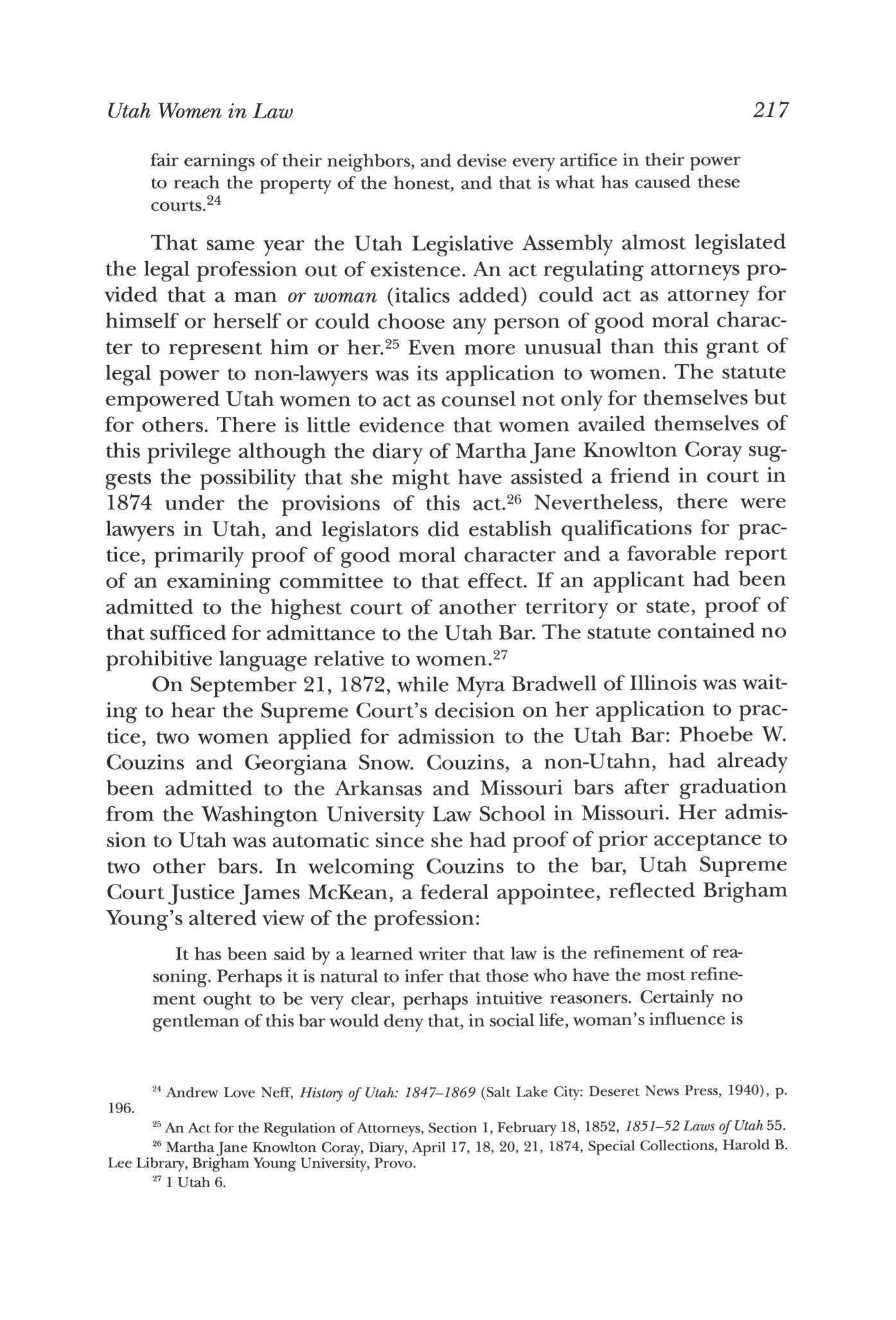
On September 21, 1872, while Myra Bradwell of Illinois was waiting to hear the Supreme Court's decision on her application to practice, two women applied for admission to the Utah Bar: Phoebe W. Couzins and Georgiana Snow Couzins, a non-Utahn, had already been admitted to the Arkansas and Missouri bars after graduation from the Washington University Law School in Missouri. Her admission to Utah was automatic since she had proof of prior acceptance to two other bars. In welcoming Couzins to the bar, Utah Supreme Court Justice James McKean, a federal appointee, reflected Brigham Young's altered view of the profession:
It has been said by a learned writer that law is the refinement of reasoning Perhaps it is natural to infer that those who have the most refinement ought to be very clear, perhaps intuitive reasoners. Certainly no gentleman of this bar would deny that, in social life, woman's influence is 196
Andrew Love Neff, History of Utah: 1847-1869 (Salt Lake City: Deseret News Press, 1940), p
25
Utah Women in Law 217
An Act for the Regulation of Attorneys, Section 1, February 18, 1852, 1851-52 Laws of Utah 55
26 Martha Jane Knowlton Coray, Diary, April 17, 18, 20, 21, 1874, Special Collections, Harold B Lee Library, Brigham Young University, Provo
27 1 Utah 6
refining and elevating. May we not hope that the honorable profession of the law may be made even more honorable by the admission of women to the bar It strikes us as a novelty, gentlemen, but everything in the line of progress is, at some time or other, a novelty I very cheerfully admit Miss Couzins to this bar and, gentlemen, I present to you our sister at the bar?8
The implication is obvious that far from being debased by entering a profession traditionally masculine, women would refine and elevate the profession to their own standards. Snow, a local woman, had studied law by reading in her father's law office and serving as his clerk for three years. Zerubbabel Snow had served as an associatejustice of the Utah Supreme Court and as a Salt Lake City attorney. Though Georgiana was well known in Utah legal circles, she went before the committee of examiners as the law required Some feared that had the court admitted her without such an examination, "some young, incompetent gentlemen might apply here and plead that as precedent in his case and so place the court in the embarrassing position of appearing to have one rule for one sex and another rule for the other sex."29 The court again enthusiastically welcomed a woman to the bar:
It may be pertinent for the court to remark that Miss Snow will find in Utah an ample field for the exercise of her professional talent [T]he fact that she has long resided here, and that she is the daughter of a lawyer, will be of great service to her, giving her much advantage over strangers who come here, and especially in listening to the complaints of her own sex. 30
Judge McKean called on prevailing gender stereotypes to demonstrate women's unique contribution to the profession The notions that female qualities would enhance the profession or that they would be useful in providing legal service to other women were not unique to Utah, but neither were they fundamental to the gradual acceptance of women in the practice. Georgiana Snow, however, used her legal training in other pursuits. She accepted appointments as a notary public and territorial librarian; and after her marriage and move to Wyoming she entered politics, serving a term as an alternate delegate to the 1892 presidential convention.31
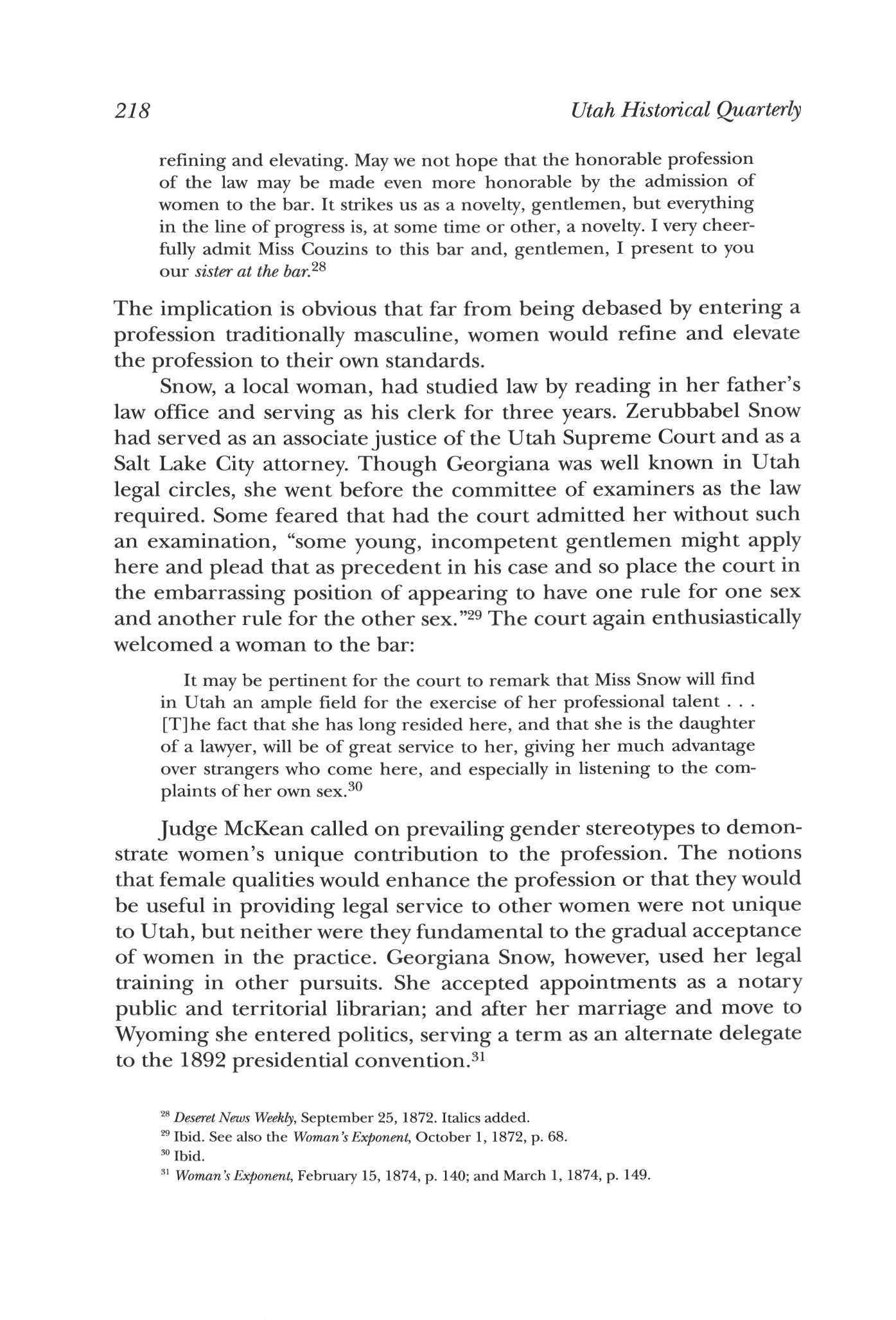
218 Utah Historical Quarterly
28 DeseretNews Weekly, September 25, 1872 Italics added 29 Ibid See also the Woman's Exponent, October 1, 1872, p 68 30 Ibid 31 Woman's Exponent, February 15, 1874, p. 140; and March 1, 1874, p. 149.
The admission of these two women to the Utah Bar created considerable notoriety for Utah, then undergoing a national antipolygamy campaign that characterized Utah women as subjugated and repressed. The Missouri Republican, among other newspapers, in commenting on the court's reception of these women, noted that Utah's "social system seems to have been the lock and key by which women have at last entered into the wider, nobler sphere for which they have prayed and worked." Other newspapers commented on the anomaly of a society that condoned both polygamy and female vocational freedom.32

The record shows no other female applicants to the Utah Bar until 1892 when Josephine Kellogg, a Provo, Utah, woman, was admitted A newspaper article that same year indicates that an unnamed woman and a "Miss Lee," possibly the daughter of Salt Lake City attorney Orlando Lee, graduated from eastern law schools about this same time and had found employment in the law offices of their fathers while awaiting admission to the bar Two other Utah women were noted as studying in eastern colleges.33
Margaret Beall Connell, admitted to the bar in 1908, is the only woman designated as an attorney in The History of the Bench and Bar in Utah, published in 1913, though two others are mentioned as studying law.A native of Ohio, Connell took an extension course at the University of Chicago and later attended the University of Berlin in Germany She read for the law over a period of years, completing her legal education at the University of Utah and becoming one of its first women graduates. She worked in the federal court in Utah as a deputy clerk and later moved to Los Angeles where she set up her
32 Woman's Exponent, October 15, 1872, p 73 The decade of the 1870s also marked a surge of female interest in medicine, with more than a dozen Utah women studying for their medical degrees in eastern colleges Women were also represented on the faculties and Boards of Trustees of the University of Utah, Brigham Young Academy in Provo, and Brigham Young College and the Agricultural College in Logan.
33 Woman's Exponent, June 1, 1892, p 172
Utah Women in Law 219
Margaret Beall Connell was admitted to the bar in 1908. From The History of the Bench and Bar in Utah
own practice.34 Agnes Swan (Bailey) is listed in the 1911 Salt Lake City Directory as having passed the bar that year and set up practice in the Deseret News Building, although her name is not on the Supreme Court Register of admittees.
Between 1902, when the register begins, and 1940, 19 women were admitted to the Utah Bar. Evidently not all practiced law. The 1900 Utah Census reports only 1 woman was in active practice (and 433 male lawyers), 2 women in 1920 (444 men), 5 women in 1930 (598 men), and 8 women in 1940 (613 men). 3 5 Before World War II the lawwas not a popular profession for Utah women.
Utah did not offer formal legal education until 1907 when the University of Utah Law School was organized.36 Granting only a twoyear certificate at first, from 1911 until 1967 it awarded a bachelor of law degree. Students could begin law school during their senior year of college, receiving a B.A. after their first year of law school and an LL.B. after two additional years. Since 1967 graduation from the U. in law confers ajuris doctor degree.
Very little data is presently available about female law students during its earliest years, but one of the most prominent women graduates of the U. Law School before World War II was Reva Beck Bosone who received her degree in 1930. She was the only female graduate that year, although another woman had entered law school with her. The study of law became a springboard for Bosone to both a judicial and a legislative career. Her mother had once told her that if she wanted to do good, "go where the laws are made." This counsel evidently initiated a lifetime desire to be a legislator, and she determined that the profession of law was the best training for that career Upon graduation she worked with her lawyer brother and later set up practice with her husband in Helper, Utah. Two years after graduation she was elected to the Utah State Legislature and four years after that she was appointed a cityjudge, serving until 1948. She was elected twice
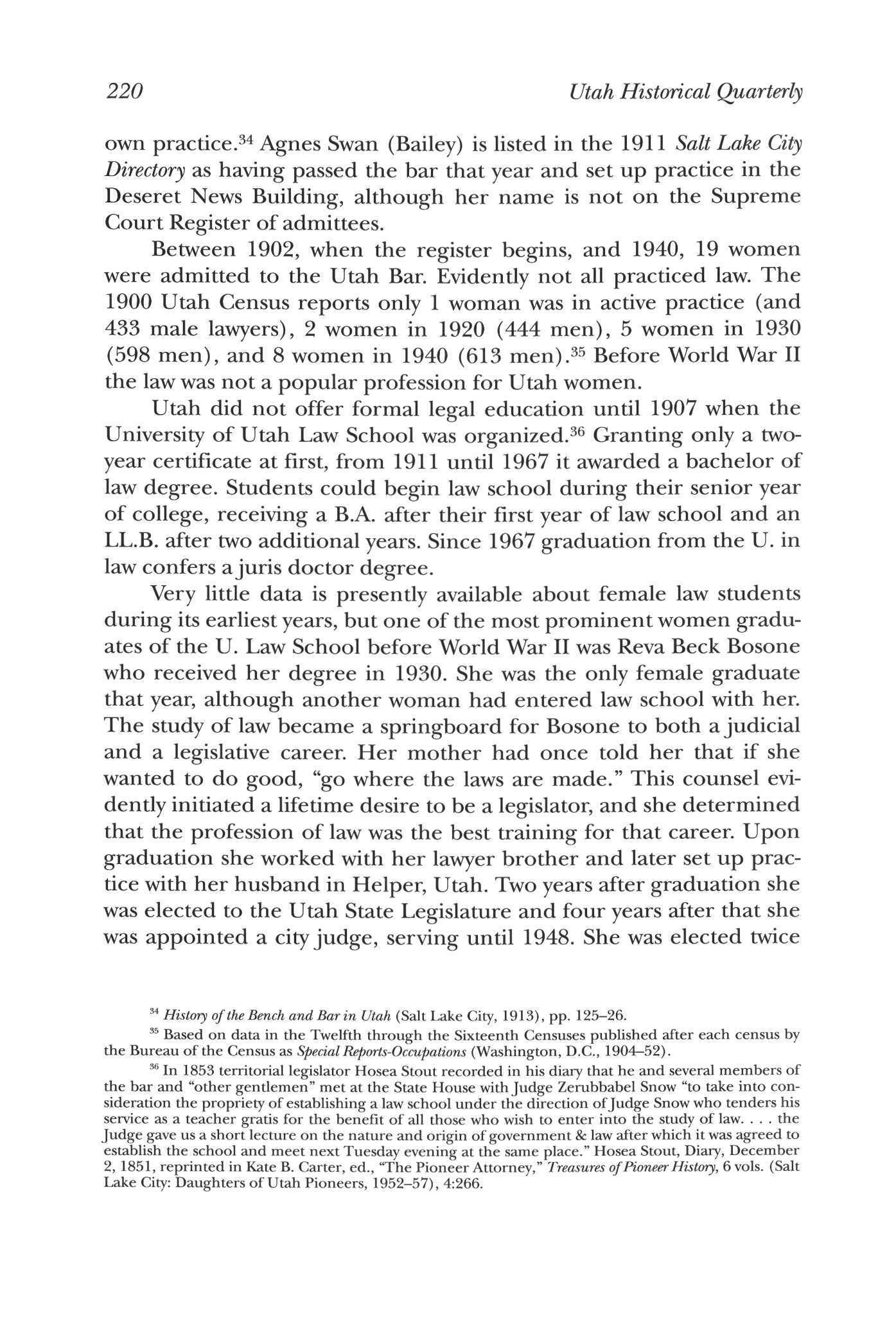
34 History of the Bench and Bar in Utah (Salt Lake City, 1913), pp. 125-26.
35 Based on data in the Twelfth through the Sixteenth Censuses published after each census by the Bureau of the Census as Special Reports-Occupations (Washington, D.C , 1904-52)
36 In 1853 territorial legislator Hosea Stout recorded in his diary that he and several members of the bar and "other gentlemen" met at the State House with Judge Zerubbabel Snow "to take into consideration the propriety of establishing a law school under the direction of Judge Snow who tenders his service as a teacher gratis for the benefit of all those who wish to enter into the study of law the Judge gave us a short lecture on the nature and origin of government & law after which it was agreed to establish the school and meet next Tuesday evening at the same place." Hosea Stout, Diary, December 2, 1851, reprinted in Kate B Carter, ed., "The Pioneer Attorney," Treasures of Pioneer History, 6 vols (Salt Lake City: Daughters of Utah Pioneers, 1952-57), 4:266
220 Utah Historical Quarterly
to the U.S. Congress, the only woman from Utah in that legislative body until the election of 1992.37
In 1930, when Bosone graduated, women constituted only 2.1 percent of the profession nationally, and only 5 of Utah's 603 practicing lawyers were women Nationwide, throughout the 1920s and 1930s women were clustered in a limited range of legal work such as briefing, probating, abstracting, examining titles, and preparing income tax returns. They were seldom found in corporate or international law, and only a few were litigators or involved in criminal defense.38

Most women graduates between the wars, both in Utah and elsewhere, were independently motivated to study law, viewing it less as a route to public service or social betterment than as a means to fulfill personal aspirations. Utahn Dorothy S. Merrill is representative. Like Bosone, she had parental support to study law but did not choose public ends. A brilliant, ambitious woman, she attended the University of Utah and then its law school, graduating in 1931 at the age of twenty-two She took additional legal training at the University of Chicago, receiving aJ.D. degree with a specialty in wills and trusts. In 1932 she married Harrison Brothers who had just completed his legal studies at Stanford University. She set up her practice independently from her husband, who embarked on a career in finance. Although she later moved into the field of stocks and bonds, she retained her law practice and a career independent of her husband. In the absence of a local women's law association, Merrill joined the Utah Business and Professional Women's Club. A singular honor was appointment by her male peers to membership on the Utah State Code Commission empowered to revise the state's legal code.39
38
Utah Women in Law 221
Reva Beck Bosone. USHS collections.
37 Beverly B Clopton, Her Honor, theJudge: The Story of Reva Beck Bosone (Ames: Iowa State University Press, 1980), pp 57-60 Utah's second female representative, elected in 1992, is Karen Shepherd
U.S. Bureau of Vocational Information, Training for the Professions (Washington, D.C , GPO, 1924), p 431
39 Interview with Margaret Merrill Nelson Brothers, a sister, on October 15, 1986, in Salt Lake City.
The presence of women in law school proved less problematic for them than the profession. Specialization and megafirms on the scale known today were not characteristic of the practice at mid-twentieth century, and few women were invited to join the existing firms throughout the nation. Utah was no exception. Thus, many women sought employment in public law and law-related fields. One Utah woman graduate of the 1950s, determined to set up a practice, became a sole practitioner in the office where she had been a legal secretary for several years Sharing office space with four other attorneys, she carved a place for herself in the area of motor carrier rights. Keeping abreast of the practice required twelve-hour work days Having made her way on her own in a male profession she is not particularly sympathetic to the demands made by women lawyers today, nor does she subscribe to the distinction made between men and women lawyers. She is a lawyer, not a "woman" lawyer, she insists, conducting her practice on the same terms that have defined the practice for generations.40 She was not unusual in adapting her personal life and career to the demands of a male-defined profession. Unlike professional women of the 1980s, professional and business women a few decades ago sought assimilation rather than accommodation.
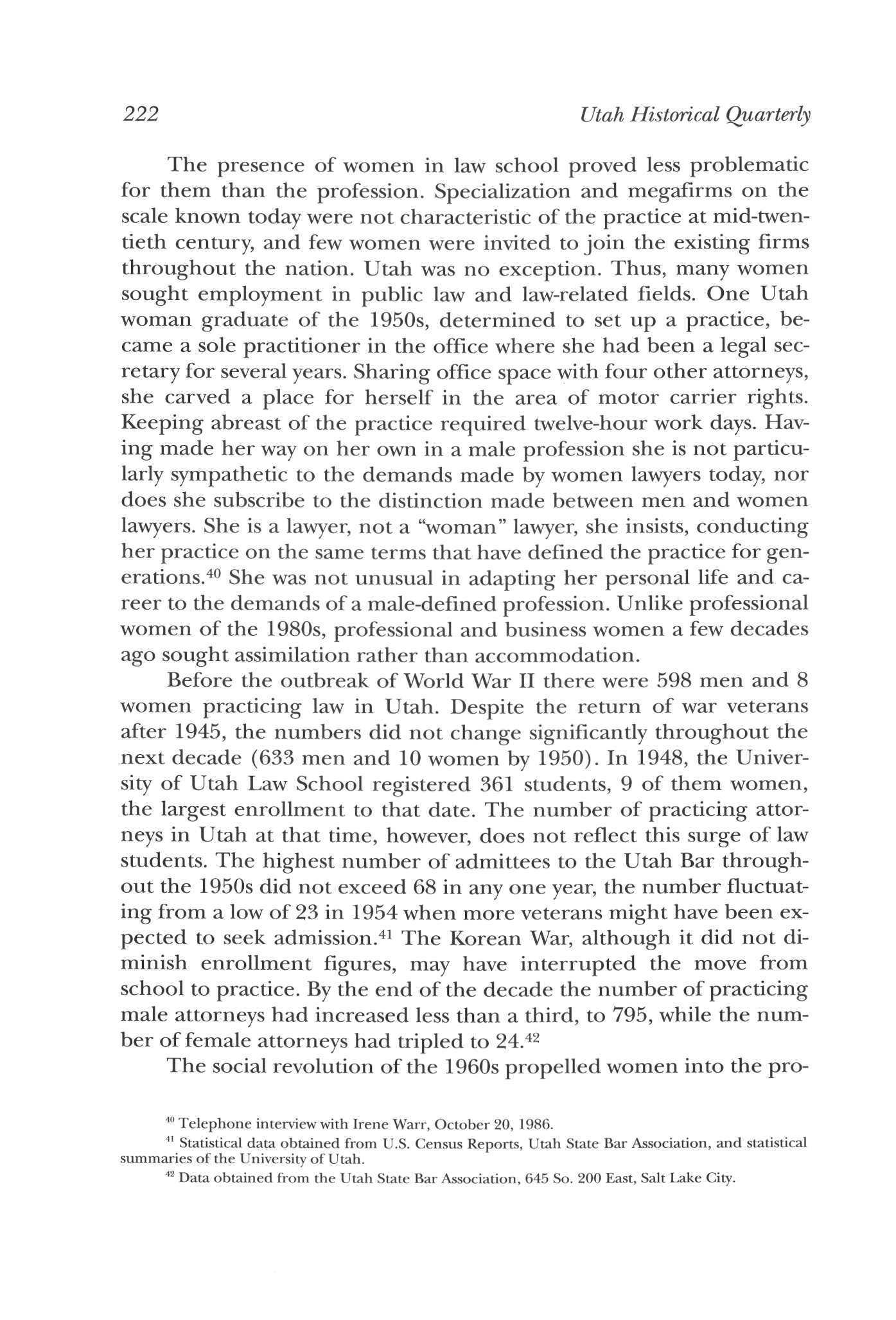
Before the outbreak of World War II there were 598 men and 8 women practicing law in Utah. Despite the return of war veterans after 1945, the numbers did not change significantly throughout the next decade (633 men and 10 women by 1950). In 1948, the University of Utah Law School registered 361 students, 9 of them women, the largest enrollment to that date. The number of practicing attorneys in Utah at that time, however, does not reflect this surge of law students. The highest number of admittees to the Utah Bar throughout the 1950s did not exceed 68 in any one year, the number fluctuating from a low of 23 in 1954 when more veterans might have been expected to seek admission.41 The Korean War, although it did not diminish enrollment figures, may have interrupted the move from school to practice. By the end of the decade the number of practicing male attorneys had increased less than a third, to 795,while the number of female attorneys had tripled to 24.42
The social revolution of the 1960s propelled women into the pro-
222 Utah Historical Quarterly
40 Telephone interview with Irene Warr, October 20, 1986 41 Statistical data obtained from U.S Census Reports, Utah State Bar Association, and statistical summaries of the University of Utah 42 Data obtained from the Utah State Bar Association, 645 So. 200 East, Salt Lake City.
fession at an accelerated rate The civil rights movement had initiated a similar effort for women's rights, and the field of law not only offered a direct route toward legal and political power for women but, as a traditionally male bastion, posed a conspicuous challenge for women to test their entry into that field.
In 1970 27 women applied for entrance to the University of Utah College of Law; 6 were accepted. They joined 8 other women to account for just under 4 percent of law students. The next year 13 were accepted out of 60 applicants, and in 1983, a peak year to that date, 49 out of 194 applicants were accepted. In the 1992-93 school year women constituted nearly 42 percent of the total law school enrollment and 54 percent of the entering class.43 At the Brigham Young University College of Law the percentages of women students are slightly less. From 1973,when the school was founded, to 1985 the law school enrolled a total of 1,685 men and 270 women, the women totaling 13 percent of its students Women's representation before 1989 reached a high of 22 percent but dropped dramatically to little more than 15 percent in 1989. Women accounted for 32 percent of the total enrollment for the 1992-93 school year, however, with 30 percent of the entering class being women. 44
In 1990 women made up 12.5 percent of Utah's lawyers (18 percent nationally). Most of them, 79 percent, along with 76.6 of the male lawyers, practiced in Salt Lake County. Ten women were the most in any one firm that year, totaling 8.5 percent of its attorneys.45 By 1992 women accounted for 14.8 percent of the state's attorneys. With more women law students the percentage will undoubtedly rise. Moreover, the fact that "women are disproportionately represented in the top of law school classes," according to one report, would compel law firms to hire more women if they desire the top performing students.46
Despite the increased number of women in the profession, residual psychological and professional barriers range from the subtle to
43 Admissions Office figures for 1990 show that 169 women and 217 men were enrolled in the U College of Law.
44 Admissions Office, J. Reuben Clark School of Law, Brigham Young University, 1986.
45 Utah State Bar Association figures plus additional information obtained from listings in the 1990 Salt Lake City Directory.
46 Judge Michael Zimmerman as quoted in the newsletter of the Women Lawyers of Utah, July 1986, p 3 Women have also proven their capability with the LSAT In 1966 6.5 percent of the students who took the test in Utah were women with a mean score 17 points below men's In 1970, just four years later, 13.3 percent were women, with a mean score 7 points higher than men's (Admissions Office, College of Law, University of Utah.)

Utah Women in Law 223
the obvious.Although less overt in most law schools today, discrimination still exists, emerging in individual, highly competitive situations such as appointments to Law Review or job interviews with law firms.47 More persistent, according toJustice Christine M. Durham of the Utah State Supreme Court, is the "gender stereotyping in the substantive fabric of the law itself, including law school textbooks and the doctrines and case law they contain."48
Both Utah law schools sponsor women law student associations, organized as support groups in the 1970s when women were a small minority of the student body. At BYU the Women's Law Forum (originally the Associated Women Law Students) has broadened its functions and now sponsors speakers and forums and studies issues relating to women, such as child care, flexible work schedules, and recruiting opportunities for dual-career couples It also assists BYU traveling recruiters and provides a mentor program for freshmen women law students. The school has provided funds for as many as fifteen women students to attend the annual conferences of the Western Association of Women Law Students The Forum actively recruits males interested in women's issues, seeking to integrate the group into areas of mutual concern. In recent years many female law students feel less compulsion than earlier graduates to prove themselves by attaining positions in large law firms, preferring to use their training in smaller firms or in other work that offers more versatility and flexibility Many seek advanced degrees, hoping to teach law rather than practice.49
The Women's Law Caucus at the University of Utah rationalized its existence originally as a consciousness-raising entity and more recently as a vehicle to identify and define issues relating to women in the profession. Like the BYU association it has a "buddy" system, especially for older women students at entry. It also sponsors a legislative action committee, usually comprised of ten seniors and several subcommittees, that identifies and researches a legal issue, drafts a statute, finds a sponsor, and then lobbies for the bill's passage. Its success has prompted other community groups to seek it out for assistance with legal projects of their own The experience has proven to have resume value while developing marketable political skills.50
47 Interview with Mitzi R. Collins, president, Associated Women Law Students of Brigham Young University, October 16, 1986, and Sandra Dredge, president, Women's Law Forum, BYU, March 18, 1990
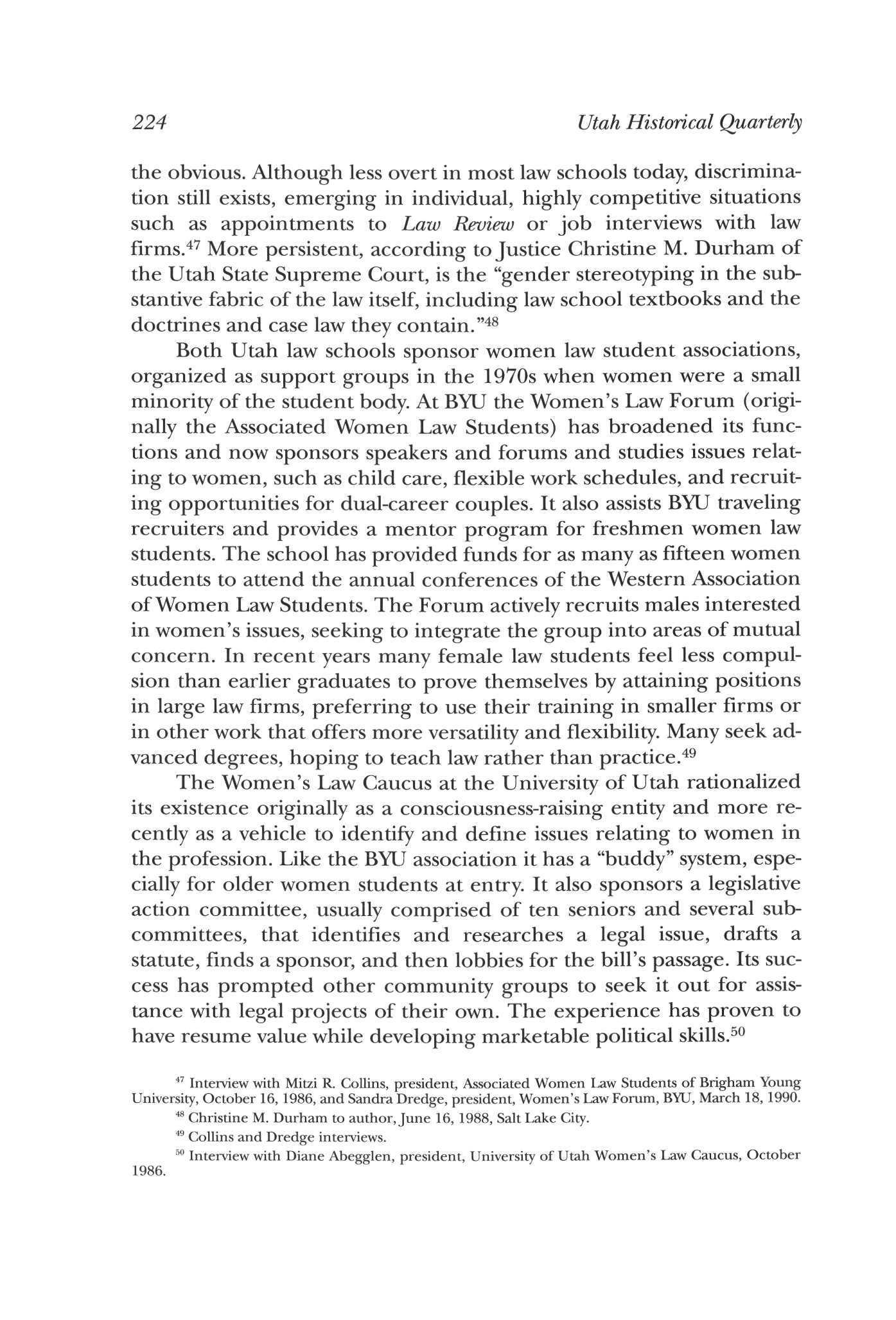
48 Christine M Durham to author, June 16, 1988, Salt Lake City
49 Collins and Dredge interviews
50 Interview with Diane Abegglen, president, University of Utah Women's Law Caucus, October 1986
224 Utah Historical Quarterly
The first wave of women graduates in the early 1970s challenged the system by demanding access to the same professional ladder that had always been available to men. That is, rather than making their own way as sole practitioners, practicing with relatives, or using their law training on the fringes of the profession, they sought positions in established law firms, the most viable route to success in the profession One woman's experience indicates how formidable the opposition to women was two decades ago. Since law firms generally hired only male students as law clerks, she supported herself as a teaching assistant until she graduated from the University of Utah College of Law in 1972, specializing in estate planning and tax law After graduation she applied at one of the largest Salt Lake City law firms but was advised there were no openings; however, a week later the firm posted a notice of an opening in her field. Despite pressure from the University of Utah president, a former member of the law school faculty, she was not granted an interview Before she was finally accepted by another Salt Lake City firm (after six interviews and a change of firm policy), she had applied to 200 law firms throughout Utah, Colorado, Arizona, and California without success. In the meantime she had been given a full-time teaching position at the U College of Law, which she gave up tojoin the firm. After nearly three years with the Salt Lake City firm she decided to return to teaching.51 Her entry, along with a few other women, into the ranks of major law firms marked the beginning of a minor revolution. She and her colleagues were at the cutting edge of an ever increasing surge of women into the profession who would not remain on the periphery.
In some respects women law graduates in the late 1960s and early 1970s were more similar to earlier graduates than to those who followed them They often subjugated their personal and family concerns to the requisites of the profession and subscribed to the prevailing standard of legal success: acceptance and eventual partnership in a large, prestigious firm. Proving themselves capable meant adopting the rigorous schedule of accumulating "billable hours" that had become pro forma in the profession and avoiding the female ghettos of family and domestic law. It also meant cultivating the confidence of male attorneys and clients, many of whom initially refused to deal with a woman lawyer. Few sought the support of other female attorneys

Utah Women in Law 225
51 Interview with Constance Lundberg, professor of law, J Reuben Clark School of Law, BYU, October 16, 1986
except for occasional social meetings All had made their own private accommodations to their careers and indicated no need for institutional support. Those who did seek it usually left Utah to practice where such support systems were more accessible.52
A later graduate encountered other problems of adjustment when beginning practice. One of the first twowomen to associate with a large Salt Lake City firm, she found that "acceptance by attorneys in other firms aswell as by clients who were used to dealing with men depended on the continual reassurance to them of her capabilities by senior members of her firm." Some of her former male student colleagues who had been supportive in school became "patronizing in the practice."53 Within a few years, however, much of the initial awkwardness and reservations of both clients and attorneys disappeared as she and other women lawyers became familiar figures in the clerk's office filing papers, in the courtroom trying cases, and in the office counseling clients.
Despite the reluctance of some women in the last century to form their own association when denied admission to the American Bar Association, others have sought the support of professional networking that such associations provide. Originally shut out from the informal social encounters in which male attorneys conduct business, find referrals, and generally make professional connections, women have utilized their own law associations to share information and experiences as well as build solidarity. While the Utah State and County Bar Associations have always extended membership to women, the need for an organization to address specific women's issues in the profession impelled a few women attorneys to organize Women Lawyers of Utah, Inc., in the late 1970s. Like their counterparts nearly a century earlier, they met resistance from those women who were reluctant to be designated specifically as "women lawyers," desiring assimilation into the profession without gender distinction. "For women who had served their professional apprenticeship," one attorney noted, "such an organization meant a step backwards," conjuring up arguments of the "distinctiveness" of women that early entrants into the profession had disclaimed. For many women lawyers, proving their ability at law translated into accepting the structure, procedures, and values of the profession as itwas then constituted.

226 Utah Historical Quarterly
52 ibid 53
1986
Interview with Pat Leith of Van Cott, Bagley, and Cornwall, February 12,
Women Lawyers of Utah, however, provided a collegial support network for women feeling professionally isolated. The organization remained informal until 1978 when Christine Durham and Eleanor Lewis were appointed judges and attended a charter meeting of the National Association of Women Judges where, according to Justice Durham, "we viewed first hand the stimulation, support, and initiative such an association could provide." Despite misgivings from some quarters, the two judges infused life into the Utah organization and within a comparatively short time it proved its value to women in the legal community. Within a decade a third of the women lawyers in Salt Lake County had become active members.54
From a hesitant and ambivalent beginning, Durham said, the association coalesced around several specific goals: "to provide support and professional networking to its members, to heighten awareness of women's legal issues and continuing discrimination, and to offer institutional backing for women to gain entry into the power structure of the profession through membership on bar committees and judicial nominating commissions."55 The election of Anne M Stirba in 1984 as the first woman to serve on the Utah State Bar Commission may well have been a test case for the influence of the WLU in support of her candidacy. Though not necessarily an advocate for women's issues, she participated as a member of the commission in a town meeting that turned into a "sensitivity training session" in which Appeals Court Judge Judith Billings and Utah Supreme Court Justice Christine Durham along with then president of WLU, Jane Conard, confronted the male members of the Bar Commission with issues and problems directly related to women lawyers. Out of this meeting, Stirba recalled, came discussion concerning "sexist language in the

Utah Women in Law 227
Bar Commissioner Anne M. Stirba. From Utah Bar Letter, October 1986.
54 Catherine Barnes, "Women Lawyers of Utah, Inc.: An Organizational Analysis," May 19, 1986, typescript copy in possession of author.
55 Interview with Justice Christine Durham, October 1986
courtroom, use of the men-only Alta Club for Commission meetings, fair representation of women on bar committees and in judicial appointments, and flexible and alternative work options in law firms." The meeting created a stir in the legal community, particularly among women attorneys, drawing 175 when only 50 were expected, Stirba noted.56 The meeting alerted male lawyers andjudges of the intent of their female counterparts to claim a representative share of the profession, to revise the structure of the profession, and to challenge the male-oriented perspective on the law.
Since then the association has made substantial progress, including the election of two women to the nine-member Bar Commission and of another,Judge Pamela Greenwood, as its first woman president. It has achieved passage of a bar policy prohibiting conducting Bar Commission business in private clubs not admitting women (a specific reference to the Alta Club); creation of a bar committee on women and minorities to develop appropriate bar-sponsored programs; inclusion of information on gender bias in training materials forjudicial selection commissions; the appointment of two women out of every four persons appointed tojudicial nominating commissions; and, of particular significance, the commitment of the Judicial Council to the creation and support of a task force to study gender bias in the courts, including a review of discriminatory practices toward female lawyers, litigants, witnesses,jurors, and defendants.57 Through the efforts of this organization women lawyers have been recognized as a collective presence in the profession. Representative of the numerous women making distinguished contributions to the profession are those women who currently sit on Utah's appellate courts,Justice Christine Durham of the Utah Supreme Court andJudges Pamela Greenwood and Judith Billings on the Utah Court of Appeals. A major shift in the attitude of women lawyers has been resistance to the profession's traditional work expectations. Since the majority of women entering law are of child-bearing age, flexible work hours, maternity leave, and optional work schedules are issues traditional law firms are obliged to address. Some women have even suggested sabbaticals and extended leave time to prevent "burnout."
56 Interview with Anne Stirba, administrative judge for the Public Service Commission, October 17, 1986; Karen Shepherd, "Scratching the Conscience," editorial, Network, December 1986.
D7 Durham interview and interview with Terrie Mcintosh, president, Women Lawyers of Utah, October 1986. See also WLU newsletters, May, July, September 1986; and Barnes, "An Organizational Analysis." The task force on gender discrimination, under the direction of Ailene Clyde, issued its comprehensive report in 1990.
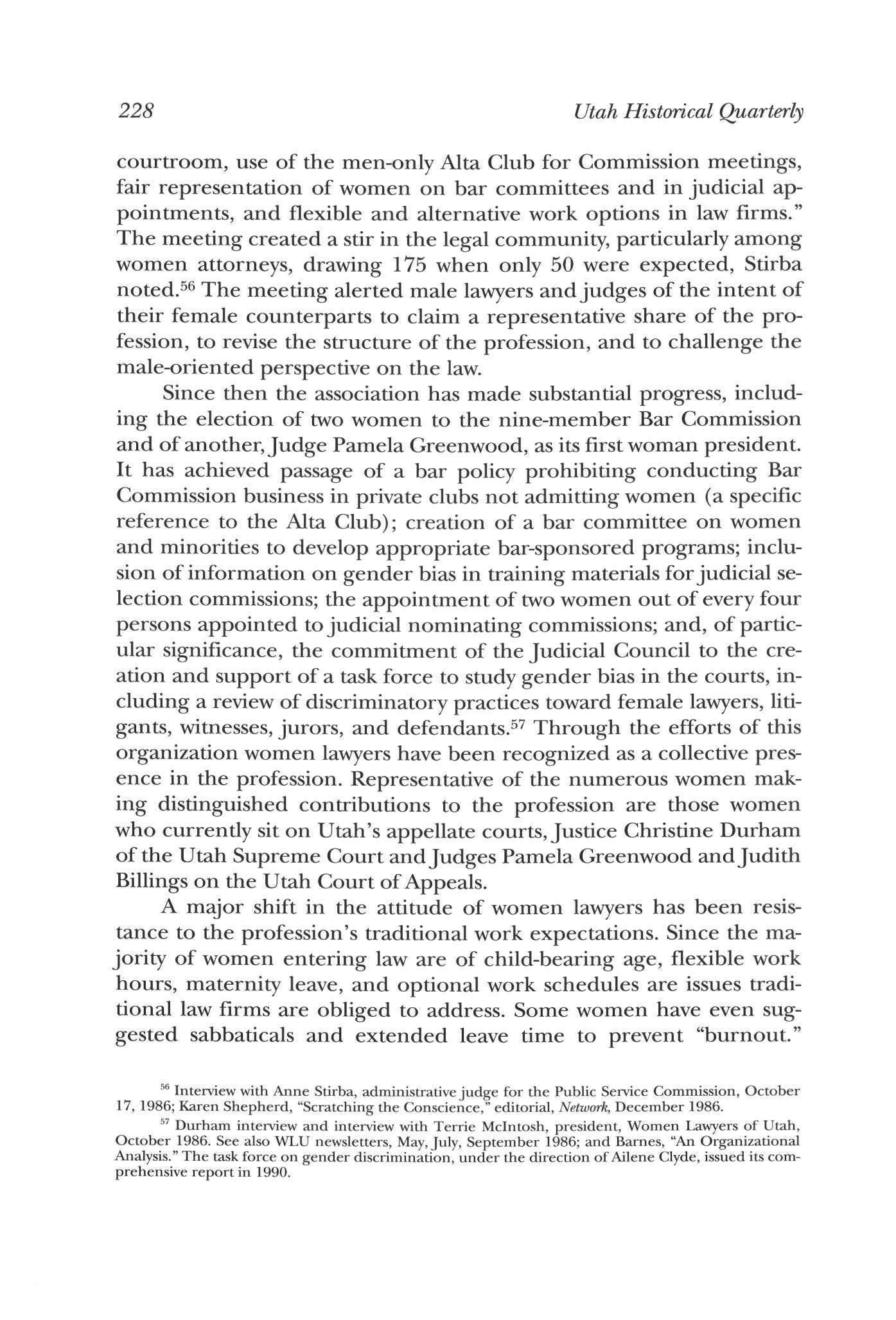
228 Utah Historical Quarterly
High achieving women law students are desirable recruits and have learned to negotiate advantageously.58 In demand, these women do not feel the necessity to adapt themselves to the existing structure but hope to adapt the profession to the needs of a more diverse constituency Rejecting the "jealous mistress" stance of the profession, they are seeking recognition of "life beyond the law office" where tabulating 2,000 billable hours each year requires 60- to 80-hour work weeks.59 Recruiting interviews frequently include discussion of the firm's policy toward women, and many firms, in order to hire top students, have adopted policies allowing flexible work time. Most women, however, still negotiate arrangements on an ad hoc basis.
Most large law firms across the country now hire women, but the path to partnership has been uneven. 60 Because of the later entry of women into the field men have outpaced them in securing partnerships in large established firms. Role conflict also deters some women from reaching the highest echelons of the practice. Family obligations frequently preclude a woman from clocking extra hours in the office,
58 A nationwide ABA study shows that more women (25%) than men (18%) finished at the top of their law classes. See Bill Winters, "Survey," American Bar Association Journal 69 (October 1983): 1385. In Utah the figures were not as high At BYU 6.54% of the senior women law students and 10.92% of the men were elected to the Order of the Coif (originally the J Reuben Clark Honor Society) between 1976 and 1987; at the U 10.08% of the senior women law students and 9.14% of the men were elected to the Order of the Coif between 1981 and 1987
59 Laurel Sorenson, "Life Beyond the Law Office," ABA Journal 70 (July 1984): 68-71
60 By 1980 there were 600 women in 36 of the largest Wall Street firms, and 29 percent of the lawyers in 50 of the nation's largest firms were women Women are represented in the nation's 100 largest firms. (Admissions Office, College of Law, University of Utah, and Beverly Blair Cook, 'Th e Path to the Bench: Ambitions and Attitudes of Women in the Law," Trial, August 1983, p 55.)

Utah Women in Law 229
Judges Judith Mitchell Billings, left, and Pamela R. T. Greenwood, right From Utah Bar Letter, December 1986.
traveling, or assuming other professional responsibilities that usually count toward advancement, a familial commitment not yet expressed as frequently by men. 61 Moreover, for both men and women the competition for legal positions in all areas of the law has intensified as new lawyers have virtually glutted the field. In the 1970s there were 2 lawyers for every 1,000 people nationally, an adequate supply. By 1990 the ratio had shifted to 3.5 lawyers per 1,000. In Utah the statewide ratio in 1990 was lower than the national average, only 2.2 per 1,000, but in Salt Lake County, where most of Utah's attorneys are clustered, there were approximately 4.1 lawyers per 1,000, making competition all the keener.62
For some women the problems of role conflict and the "negative work environment" they sometimes encounter, including less pay, less opportunity for advancement, and less control than their male counterparts enjoy, have caused dissatisfaction and led some of them out of private practice or into other areas of the profession.63 Some women initially opt for public or government service in order to avoid the tensions and pressures of private practice.64 The comparative inability to generate clients and business as easily as men is one reason given for the high percentage of women in salaried positions, reaching 70 percent, according to an ABA survey in the mid-1980s. Only 40 percent of male lawyers were salaried at that time.65 As their incursion into the profession becomes ever more pronounced, women's impact on the procedure and substance of the law becomes even more compelling. Although some would argue that both men and women are trained to view issues only as "lawyers," others do not discount the influence of different social perspectives.
bl Some of these issues are discussed in relationship to Utah professional women, including Judith Billings, in "Was 1992 Really the Year of the Woman?" Salt Lake City, January/February 1993, pp 58-66, 105.

62 Population figures as of January 1991 obtained from the Office of Budget and Planning, Utah State Capitol, Salt Lake City
63 From a survey sponsored by the ABA's Young Lawyers Division, cited by staff director, Ronald Hirsch, at the National Conference of Women's Bar Associations, ABA Midyear Meeting, Baltimore, Maryland, 1986
64 Anne Stirba, first woman membe r of the Utah State Bar Commission, and administrative judg e for the Public Service Commission, is one who deliberately chose to work in public service in order to become more immediately involved in a wider variety of issues She has felt a strong sense of personal responsibility for her work and great flexibility in determining issues and procedures Interview, October 17, 1986
65 Donna Fossum, "A Reflection on Portia," American Bar Association Journal 69 (October 1983): 1391 Another ABA Journal 71 (December 1985): 34-35, article, "Leaving the Law," noted additional causes for dissatisfaction, such as burnout, the adversarial nature of the work, and continuing discrimination Both articles cited the inability to attract clients as a major problem for women Those litigators who do stay report that they relish their work as much as men
230 Utah Historical Quarterly
Both the substance and the practice of the law reflect the presence of women whose perspective on life and morality, law andjustice are not necessarily similar to men's. As a system of regulating standards and relationships the law is ideally gender neutral, but in reality it both reflects and sustains social values and relationships that have, in many areas, been unfavorable to women. The values, insights, and perspectives that an individual interpreter, whether advocate orjudge, brings to bear in the interpretation of law inexorably reflect that individual's judgment and experience. Some have viewed a growing emphasis on conciliation and concern for the personal consequences of resolutions representative of women's approach to arbitration and ruling.66 Studies indicate that women have shown and often prefer to use their skill as facilitators, negotiators, and mediators, which particularly suits a trend toward mediation rather than litigation.67
Moreover, women tend to bring a pattern of personal and social relationships that some psychologists have identified as distinct from that of men. "Women as a group," law professor Kenneth Karst has observed, referring to Carol Gilligan's psychological studies of women, "tend to define themselves and others as members of networks of relationships." This perception of themselves predisposes women to view the consequences of argument, arbitration, and ruling in less easily defined contours than men. As women enter into more policy making decisions, particularly the judiciary, this point of view, Karst believes, will be "progressively infused" into public life.68
This broader female perspective undergirds an approach to law employed by many lawyers and judges today. Time has shown that an earlier feminist platform of equality under the law often translated into inequity for women whose social circumstances often disadvantaged
66 Kenneth L Karst, "Woman's Constitution," Duke Law Journal, June 1984, p 507 The move toward "Alternative Dispute Resolution," which stresses negotiation over litigation, is reflective of this approach
67 Lundberg interview See also an interview with Sue Walton, business manager of Western Arbitration Association, in the Salt Lake Tribune, October 19, 1986, which examines the Alternative Dispute Resolution Utah now has a facility where ADR programs can be implemented and mediation and other related training is available See Hans Q Chamberlain, "Alternative Dispute Resolution (ADR)," Utah BarJournal 1 (November 1988): 6-7
68 Karst, "Woman's Constitution," pp 461-62, has applied the psychological theories of Carol Gilligan in In a Different Voice: Psychological Theory and Women's Development (Cambridge: Harvard University Press, 1982) to women's influence on the development and interpretation of law Gilligan, according to Karst, finds that men and women tend to have distinctive views of interpersonal relationships and the meaning of morality Men tend to view human interactions as contractual and hierarchical, while women see the same interactions as part of a continuous nonpositional connection of relationships Karst concludes, "It takes no sophistication to recognize that American law is predominantly a system of the ladder, by the ladder, and for the ladder."
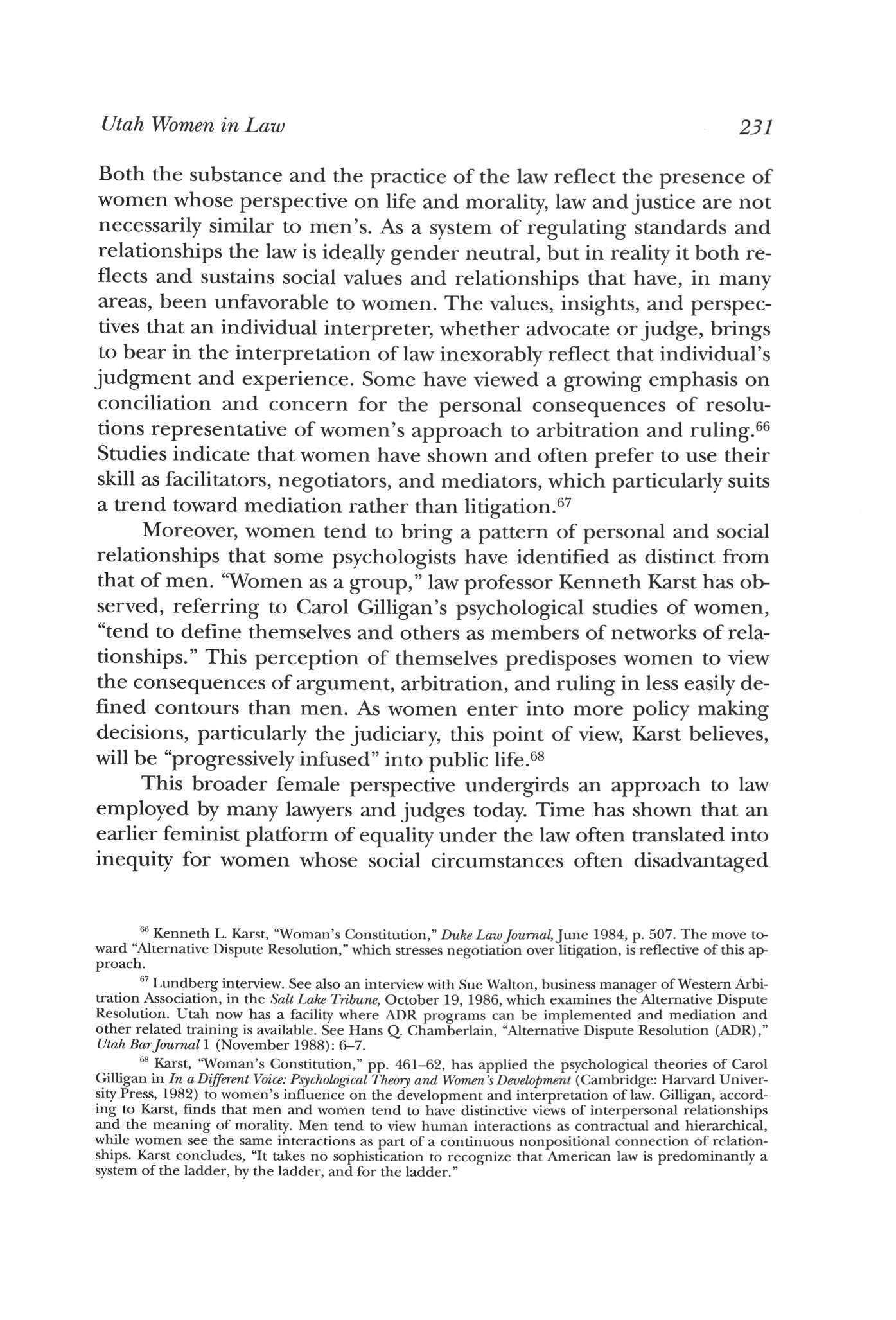
Utah Women in Law 231
them in areas unprotected by the legal system.69 Recognizing that the law as traditionally constructed and administered is limited in its ability to change the institutions and assumptions that formulated it originally,Justice Christine Durham has identified an emerging "feminist jurisprudence" that has provided "an intellectual framework" for implementing the changes that make the law more responsive to all of its constituents. The impact of this legal perspective is already apparent, according to Durham, not only in the classroom, in practice, and in the courts, but "in research and thinking about what happens to women in the world shaped by law, law language, and legal institutions."70
From Myra Bradwell to Sandra Day O'Connor, from Georgiana Snow to Christine Durham, the history of women's attempt to enter a profession in which women have always had a vested interest but no representation shows a steady and determined effort by committed women to broaden their vocational options. A pioneer in removing the barriers to vocational freedom in the nineteenth century, Utah today follows rather than leads the national trend in the degree to which women participate in the legal profession. However, a steadily growing number of Utah women in the field, the quality of their work in the law, and the impact of their perceptions on the law have already begun to reshape the legal profession in Utah
69 Christine Durham, "Of Pedestals and Cages: The Law as Instrument," address delivered to the Conference on Gender and the Family, Brigham Young University, February 7, 1991, p 12
70 Ibid., p 14 One study of female state supreme court justices shows that women justices tend to address a wide variety of gender-related issues as a single feminist issue, including family relationships, property settlement, sex discrimination and harassment, and even medical malpractice The study also shows that they invariably take a "prowoman" position in their decisions, aiming at correcting what they perceive to be a "gender-related societal imbalance," even when their associates oppose an expansion of women's rights See David W Allen and Diane E Wall, "The Behavior of Women State Supreme Court Justices: Are They Tokens or Outsiders? "Justice SystemJournal 12 (February 1987): 232-45 Justice Durham of Utah was included in the study and fits the findings. The study also indicates that women justices seldom take a "centrist" position They are either on the extreme right or the extreme left of criminal justice and economic disputes They are not, in other words, absorbed into the spectrum of positions taken by their male colleagues on each issue
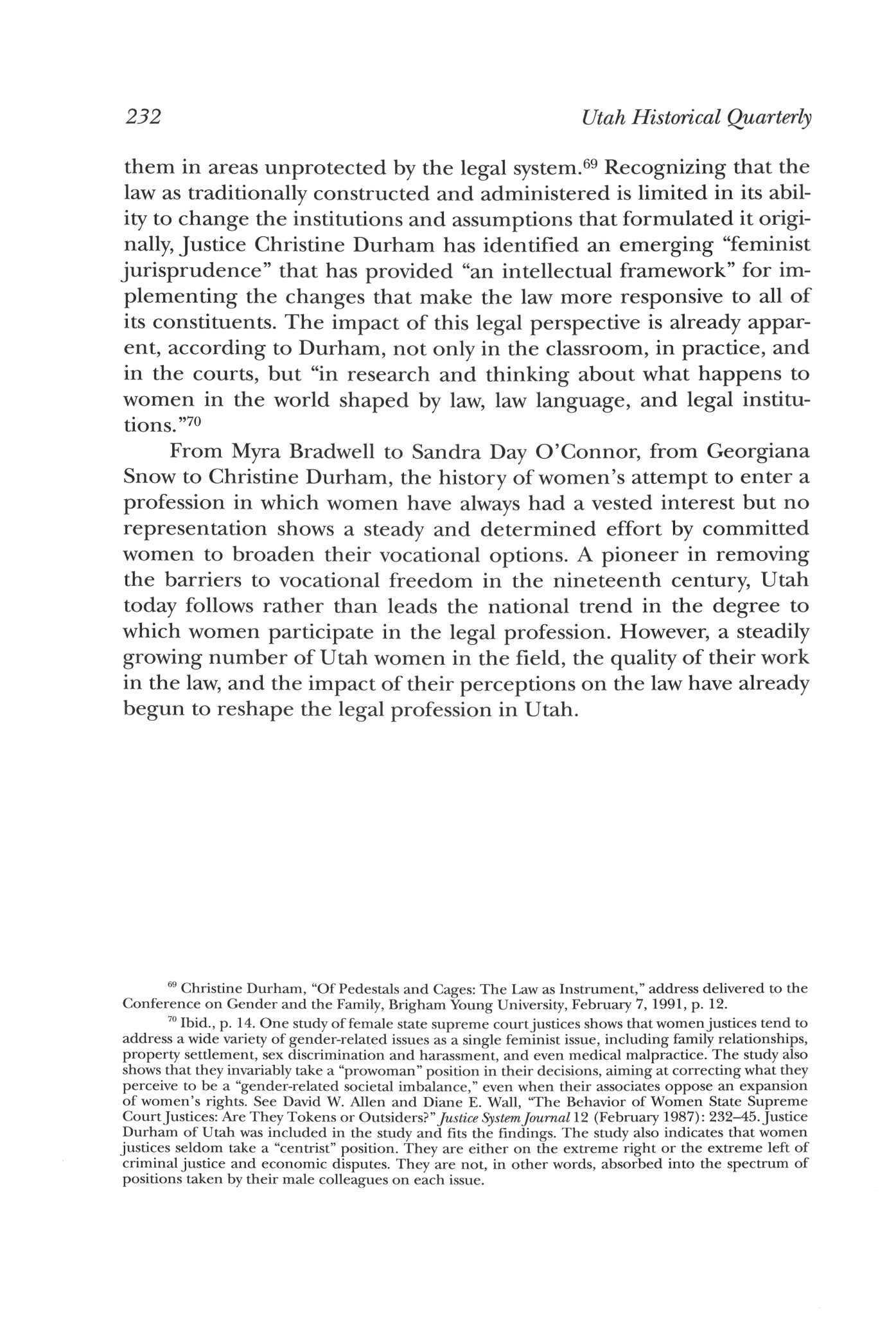
232 Utah Historical Quarterly
Utah State Supreme Court Justice Samuel R. Thurman
BY JOH N R. ALLEY, JR.
SAMUEL R THURMAN'S 1917 APPOINTMENT TO THE Utah State Supreme Court by Gov. Simon Bamberger was a fitting climax to an active career in Utah politics during its most turbulent years. His appointment, the first of a Mormon, by the state's first non-Mormon governor, to a court that had inherited its initialjustices from its territorial predecessor—a primary instrument of a federal campaign against the Mormon church—represented the growing reconciliation between
 Samuel R. Thurman. USHS collections.
Dr Alley is editor of Utah State University Press
Samuel R. Thurman. USHS collections.
Dr Alley is editor of Utah State University Press
religious factions since Utah's admission to statehood He had spent much of his life trying to achieve that end. Moreover, in an era before the supreme court became nonpartisan, he was one of the first Democrats to serve on it. This too was appropriate since he had served his party long and well and had sought at an early date to convince his fellow citizens that the introduction of the national party system into Utah politics was one of the best ways to diminish the divisiveness of the prevalent politics by religion Nevertheless, both before and after his tenure on the court he worked hard to make all Utahjudicial elections nonpartisan.
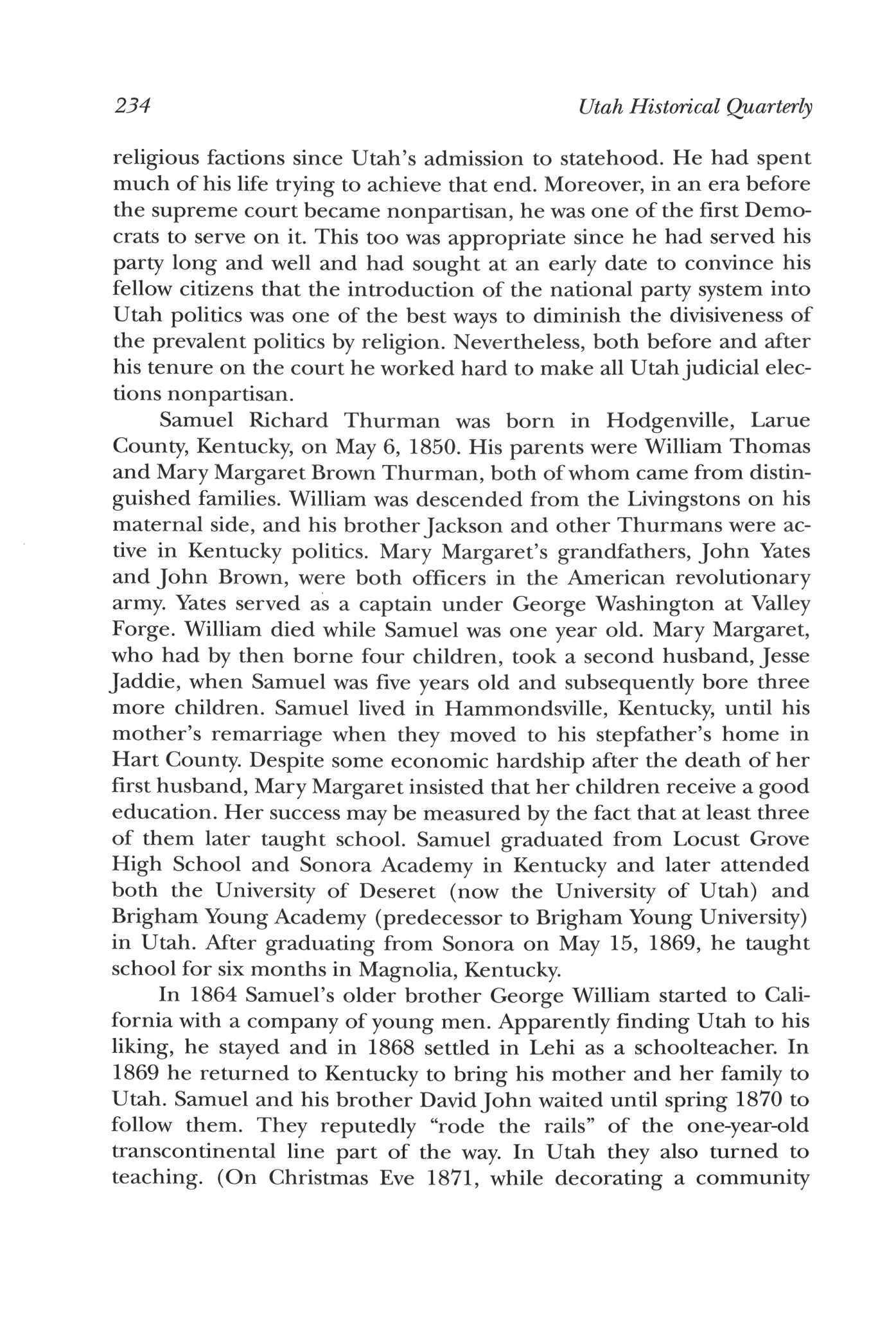
Samuel Richard Thurman was born in Hodgenville, Larue County, Kentucky, on May 6, 1850. His parents were William Thomas and Mary Margaret Brown Thurman, both of whom came from distinguished families. William was descended from the Livingstons on his maternal side, and his brother Jackson and other Thurmans were active in Kentucky politics. Mary Margaret's grandfathers, John Yates and John Brown, were both officers in the American revolutionary army Yates served as a captain under George Washington at Valley Forge. William died while Samuel was one year old. Mary Margaret, who had by then borne four children, took a second husband, Jesse Jaddie, when Samuel was five years old and subsequently bore three more children. Samuel lived in Hammondsville, Kentucky, until his mother's remarriage when they moved to his stepfather's home in Hart County. Despite some economic hardship after the death of her first husband, Mary Margaret insisted that her children receive a good education. Her success may be measured by the fact that at least three of them later taught school. Samuel graduated from Locust Grove High School and Sonora Academy in Kentucky and later attended both the University of Deseret (now the University of Utah) and Brigham Young Academy (predecessor to Brigham Young University) in Utah. After graduating from Sonora on May 15, 1869, he taught school for six months in Magnolia, Kentucky
In 1864 Samuel's older brother George William started to California with a company of young men Apparently finding Utah to his liking, he stayed and in 1868 settled in Lehi as a schoolteacher. In 1869 he returned to Kentucky to bring his mother and her family to Utah. Samuel and his brother DavidJohn waited until spring 1870 to follow them. They reputedly "rode the rails" of the one-year-old transcontinental line part of the way. In Utah they also turned to teaching. (On Christmas Eve 1871, while decorating a community
234 Utah Historical Quarterly
Christmas tree, George was shot and killed by a rowdy student whom he had previously chastised.) During the next eight years Samuel taught school and used his free time to study law In February 1871 he joined the Church ofJesus Christ of Latter-day Saints.
Samuel married Isabella Karren of Lehi on May 4, 1872. They would have eight children: Richard Bertram, born November 7, 1873; May Belle, May 18, 1876; Mary Margaret, November 21, 1878; Lydia Catherine, May 2, 1882; William Thomas, April 21, 1885; Samuel David,July 25, 1887; Victor Emanuel, May 6, 1890; and Allen Grover, February 6, 1893.1
Meanwhile, Samuel's study of the law also bore fruit when in 1875 at the age of twenty-four he was appointed city attorney for Lehi. He did not remember his introduction to trial law as auspicious (although he was city attorney he would not be admitted to the bar until 1878 or 1879). He "conceived the brilliant idea" of trying his first two cases together. In the trade of a calf one man was accused of swindling another, who in turn was accused of assaulting the alleged swindler Although the jury was instructed that it was up to them to decide whether the second party, who admitted the assault, was sufficiently provoked by the swindle, they not only found the first party not guilty of the swindle, thereby removing the possible provocation, but also, having considered the assault first, claimed there was enough reasonable doubt about whether the second party had been provoked to find him not guilty as well. Samuel drolly attributed the verdicts to "the efficiency and flexibility of the doctrine of reasonable doubt."2
Thurman also served as auditor and alderman of Lehi. In 1877, while holding the latter position, he became mayor when his predecessor resigned. This temporary role lasted only until 1879, but he was elected mayor in his own right in 1881. In November 1882, three months before the next city election, he resigned in order to move to Provo and "devote hereafter his whole time to the practice of the
1 Information regarding Samuel Thurman's children is from Family Group Records for Samuel Richard Thurman, Genealogical Library of the Church of Jesus Christ of Latter-day Saints, Salt Lake City Short biographies of Thurman can be found in J Cecil Alter, Utah, the Storied Domain: A Documentary History of Utah's Eventful Career (Chicago: American Historical Society, 1932), 2:52-54; Frank Esshom, Pioneers and Prominent Men of Utah (reprint ed., Salt Lake City: Western Epics, 1966), p 1213; Portrait, Genealogical, and Biographical Record of the State of Utah (Chicago: National Historical Record, 1902), pp. 411-12; Press Club of Salt Lake, Men of Affairs in the State of Utah (Salt Lake City, 1914), p. 174; Ralph B Simmons, Utah's Distinguished Personalities (Salt Lake City, 1933), 1:206; Noble Warrum, Utah Since Statehood: Historical and Biographical (Chicago: S.J Clarke Publishing Company, 1919), 2:96-100
2 Samuel R Thurman, "Reminiscences of a Barrister," History of the Bench and Bar of Utah (Salt Lake City, 1913), pp 73-74
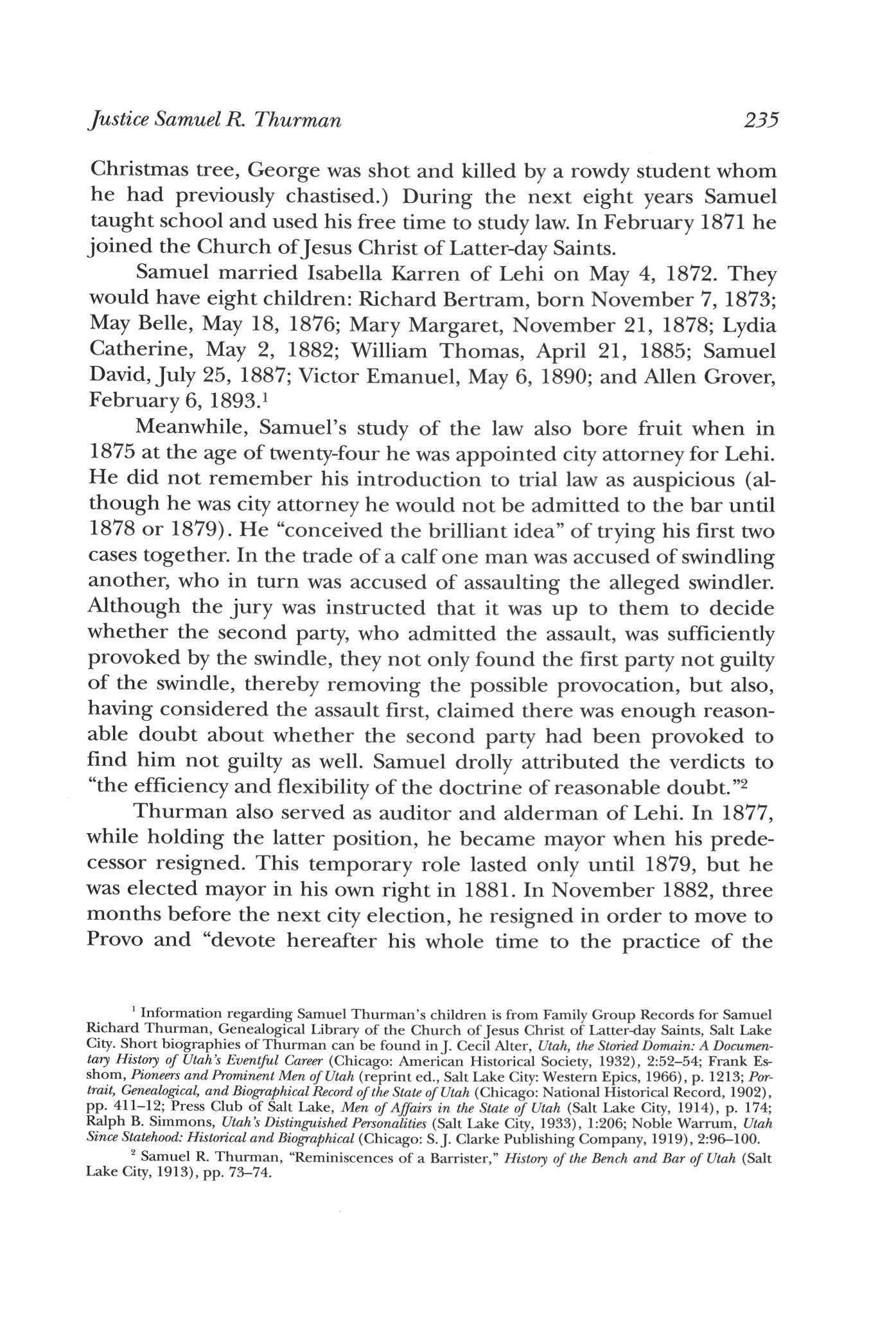
Justice Samuel R. Thurman 235
law."3 In fact, however, his public service career was blossoming He had already served in the 1882 territorial legislature, having been elected in 1881, and would continue to do so until 1890. Soon after his arrival in Provo he was appointed city attorney, a position he held until 1890. He would also function as city attorney of American Fork, Pleasant Grove, Springville, Spanish Fork, and Payson And in 1883 he was elected county attorney for Utah County, where he served until 1890 concurrently with his other offices and while devoting at least some time to private practice. Bythe time he undertook these multiple duties Samuel had had some formal legal education to supplement his private reading. Following his first admission to practice law, in the FirstJudicial District Court of Utah in March 1879 (some sources say 1878 to the bar of the Utah Territorial Supreme Court), Samuel in September 1879 went to Ann Arbor to attend the University of Michigan Law School. It had gained national fame because of its faculty—especially Dean Thomas Mclntyre Cooley, who was considered by many to be the preeminent American expert on constitutional law—and because of its policy of admitting any student over the age of eighteen who could present "satisfactory evidence of good moral character."4
Although several sources state that Samuel graduated from Michigan in 1880, his grandson said that he was compelled by family sickness to return to Utah five weeks before completing his law classes.5 The lack of a degree was not much of a hindrance in that time and place. George Sutherland, for example, who was Thurman's
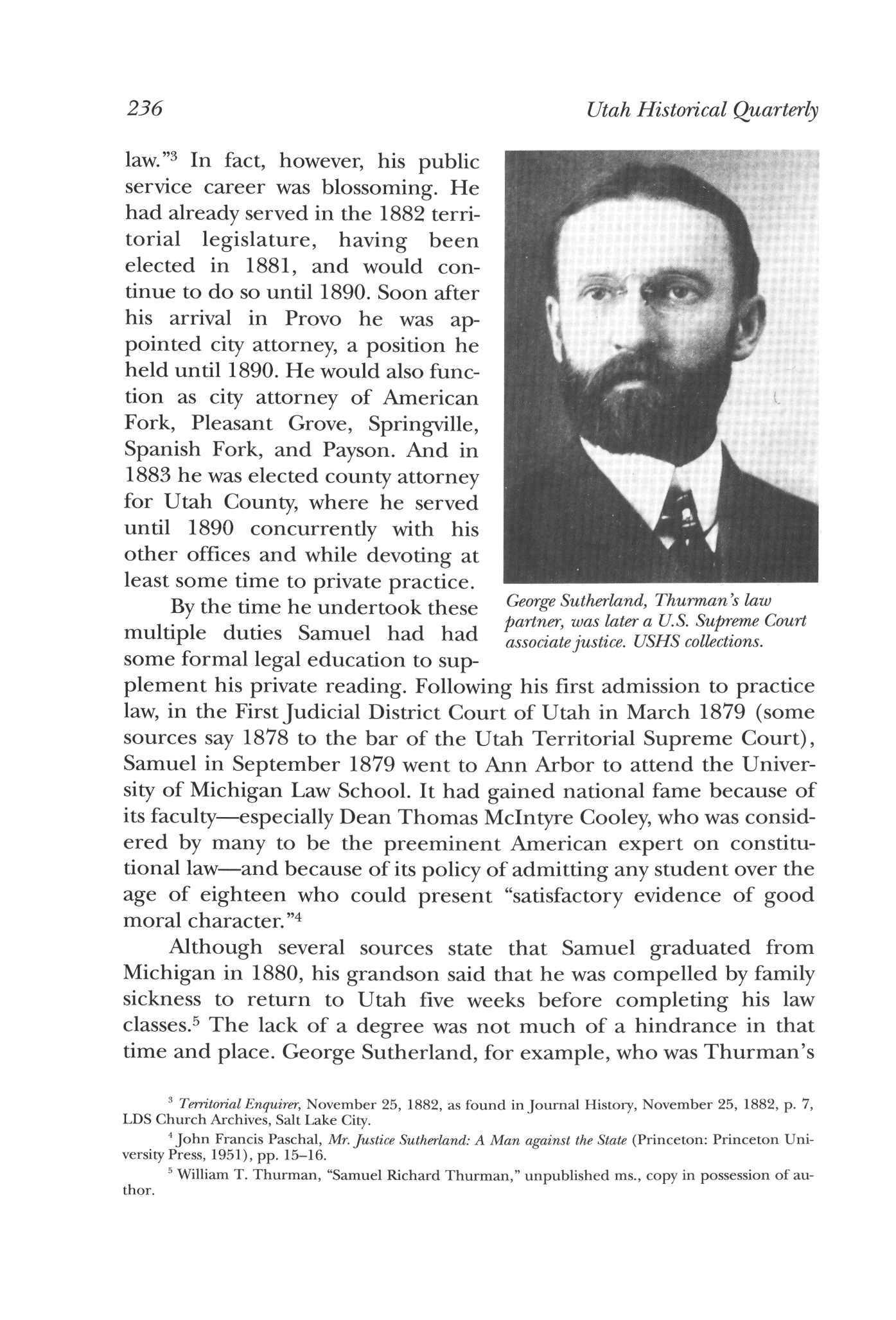
236 Utah Historical Quarterly
George Sutherland, Thurman's law partner, was later a U.S. Supreme Court associatejustice. USHS collections.
3 Territorial Enquirer, November 25, 1882, as found in Journal History, November 25, 1882, p 7, LDS Church Archives, Salt Lake City.
4 Joh n Francis Paschal, Mr. Justice Sutherland: A Man against the State (Princeton: Princeton University Press, 1951), pp 15-16
5 William T Thurman, "Samuel Richard Thurman," unpublished ms., copy in possession of author.
partner and later an associatejustice of the U.S. Supreme Court, also attended Michigan but did not take a degree
Thurman's fellow teacher in Lehi, David Evans, had also read law with him there, and when Evans returned in 1884 from his own studies at Ann Arbor they formed the firm of Thurman and Evans Samuel, who was widely known for his wit, later recalled their first case in district court:
It was a case for the replevin of a heifer We had won it in the justices' court and the defendant appealed. In the district court we made our case so plain that we not only achieved a victory but the grand jury, then in session, indicted the defendant for grand larceny. He was an old neighbor of ours, a good citizen and we did not believe him guilty Being flushed with victory and feeling magnanimous, we offered to defend him. He accepted our services. We tried the case and the jury found him not guilty On the following Sunday our bishop, who was bitterly prejudiced against lawyers, announced to the people in the Sunday meeting that Dave and I had blossomed out as full-fledged lawyers, had won our first case and then, lawyer-like, we had turned right around and took the other side of the same case and had won that also From then on Dave and I had all the business we could attend to.6
Evans was later appointed assistant U.S. district attorney, and in 1886 Samuel became a partner with George Sutherland in the firm of Thurman and Sutherland Sutherland subsequently represented Utah in the U.S. Senate and served as president of the American Bar Association before his 1922-38 term on the U.S. Supreme Court. Soon the firm, with the addition of William H. King, who would also be a U.S. senator, became Thurman, Sutherland, and King; however, King was appointed to the Utah Territorial Supreme Court in 1890.
The firm of Thurman and Sutherland continued until 1893.Although a successful and friendly partnership, the two men were in some ways an odd couple in that era of sectarian conflict Thurman, a Mormon and a leading member of the church's People's party, was increasingly an advocate of the Democratic party; and Sutherland, a non-Mormon, was an equally active Liberal cum Republican. (One interesting sidelight on the two men is that many years later Thurman supported Franklin Roosevelt's attempt to pack the U.S. Supreme Court, of which Sutherland was then one of the more conservative members.) But political appearances in the 1880s could be deceiving. Thurman aswell as King and Evans were among a growing number of

Samuel R. Thurman 237
Justice
6 Thurman, "Reminiscences of a Barrister," pp 74-75
young Mormons, second-generation Mormons, or children of Mormons who associated comfortably with non-Mormons and who in the 1880s responded to increasing attacks on polygamy and the Mormon church by seeking some form of accommodation with the rest of the nation. Sutherland, on the other hand, though a gentile and a prominent member of the anti-Mormon Liberal party, was generally friendly to Mormons and a defense attorney in many polygamy cases. Following Thurman's election to the territorial legislature in 1881 he played a role in the conflicts created by the passage of the federal Edmunds Act in March 1882. That act strengthened the existing laws against polygamy, defined living in a polygamous marriage as unlawful cohabitation, disfranchised polygamists, excluded them and those who believed in plural marriage fromjuries, and established the Utah Commission to supervise the electoral process in the territory. Samuel had been elected on the People's party ticket, and at the party's October 1882 convention he was appointed chairman of a committee to draft a "Declaration of Principles"—a platform that responded to the Edmunds Act, the stated positions of the Liberal party, and the acts of non-Mormon officials by appealing to the supremacy of constitutional law and "the sacred privilege of local self-government."7
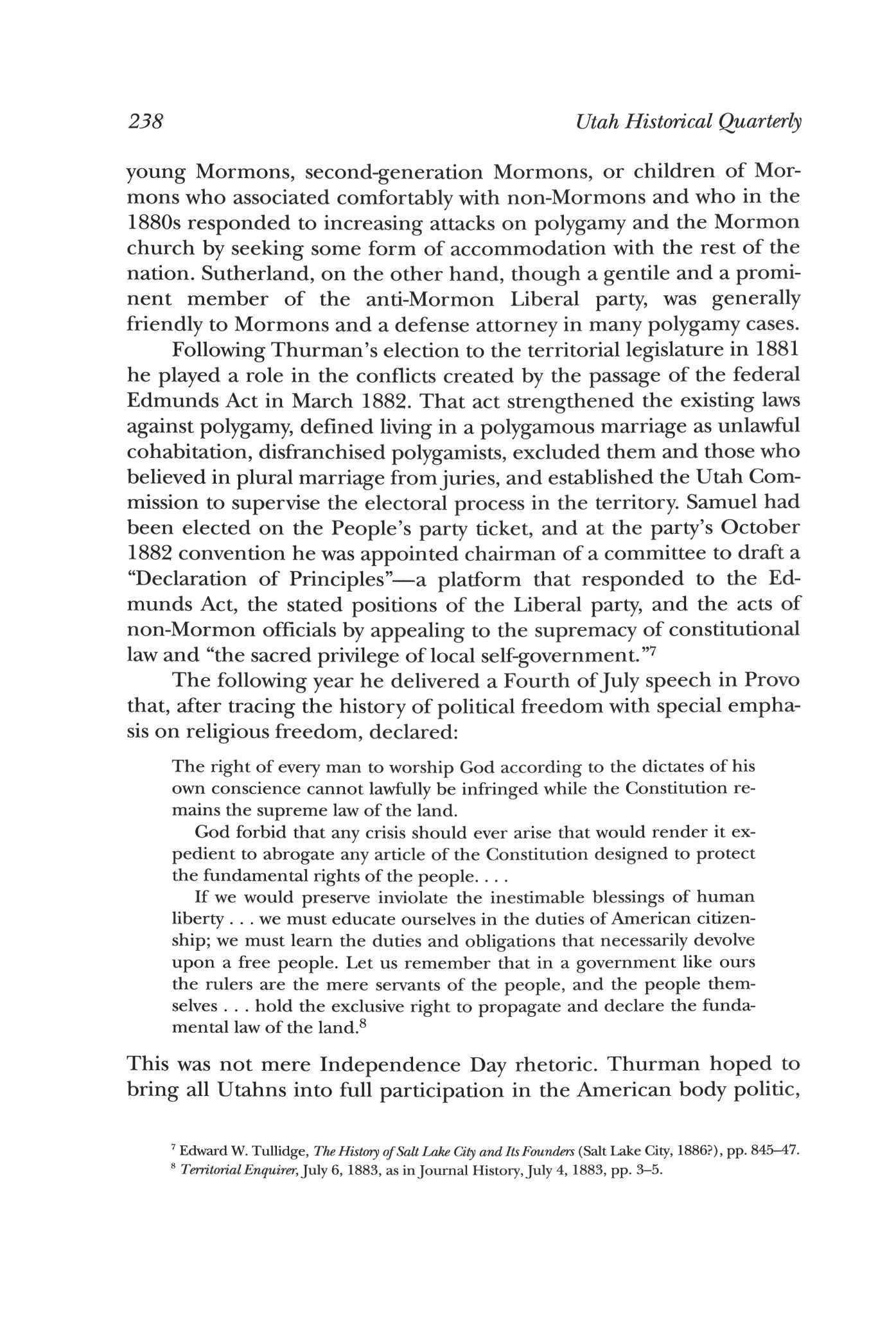
The following year he delivered a Fourth ofJuly speech in Provo that, after tracing the history of political freedom with special emphasis on religious freedom, declared:
The right of every man to worship God according to the dictates of his own conscience cannot lawfully be infringed while the Constitution remains the supreme law of the land
God forbid that any crisis should ever arise that would render it expedient to abrogate any article of the Constitution designed to protect the fundamental rights of the people
If we would preserve inviolate the inestimable blessings of human liberty ... we must educate ourselves in the duties of American citizenship; we must learn the duties and obligations that necessarily devolve upon a free people Let us remember that in a government like ours the rulers are the mere servants of the people, and the people themselves hold the exclusive right to propagate and declare the fundamental law of the land.8
This was not mere Independence Day rhetoric. Thurman hoped to bring all Utahns into full participation in the American body politic,
8
238 Utah Historical Quarterly
7 Edward W Tullidge, The History of Salt Lake City and Its Founders (Salt Lake City, 1886?), pp 845-47
Territorial Enquirer, July 6, 1883, as in Journal History, July 4, 1883, pp. 3-5.
but he and many others were, especially after the so-called "raid" or "crusade" against polygamists picked up steam in the mid-1880s, torn between adhering to the freedom of conscience they felt the Constitution guaranteed and shouldering obligations as American citizens, which included obedience to laws propagated by the people of the United States.
Samuel's prominence grew during his tenure in the territorial legislature from 1882 to 1890. He became a leader of that body and was described in 1886 as small in stature, compact in form, and his dark, square face impassive, his demeanor always cool, collected, and calm, his voice decisive, impressive, and distinct, a natural debater, he usually carries conviction with his argument and makes his meaning plain and explicit to his colleagues. Although courteous to all with whom he may differ in opinion on measures before the House, he is quick to perceive and ready to question the utility of any bill or measure under consideration.9
His accomplishments while serving on the judiciary committee included twice serving onjoint legislative committees that revised and compiled the territory's laws He expended much effort trying to find reasonable answers to the struggles between Mormons and anti-Mormons. When federal judges raised the ire of the Mormon community by resorting to open venire after jury lists were exhausted due to disqualification of Mormons, he introduced a bill that would have provided a supplementary list of jurors from which to draw when the original jury pool would not suffice.10 When the territorial government reached a near standstill because of differences between the governor and legislature over who had the power to appoint territorial officials, Thurman, despite the People's party's opposite stand, conceded the governor's right, for which he was attacked by both sides for "double-dealing" and "posing as a Liberal."11
In 1884, in the wake of Grover Cleveland's election, a sizable group ofyoung Mormons and gentiles began working toward replacing Liberal party versus People's party politics in Utah by building a Democratic party in the state. By 1888 Thurman was one of the principal
9 Journal History, January 19, 1886, p 9
10 The 1874 Poland Act had provided a system of jury selection by the clerk of the district court and each county's probate judge The former was considered to represent non-Mormons while the latter represented Mormons. Although there was Mormon opposition to this provision in the Poland Act, it was considered much better than open venire whereby U.S. marshals who were pursuing polygamists could pull jurors who were expected to be anti-Mormon off the streets
11 Salt Lake Herald, March 12, 1886, as in Journal History, March 11, 1886, p 11
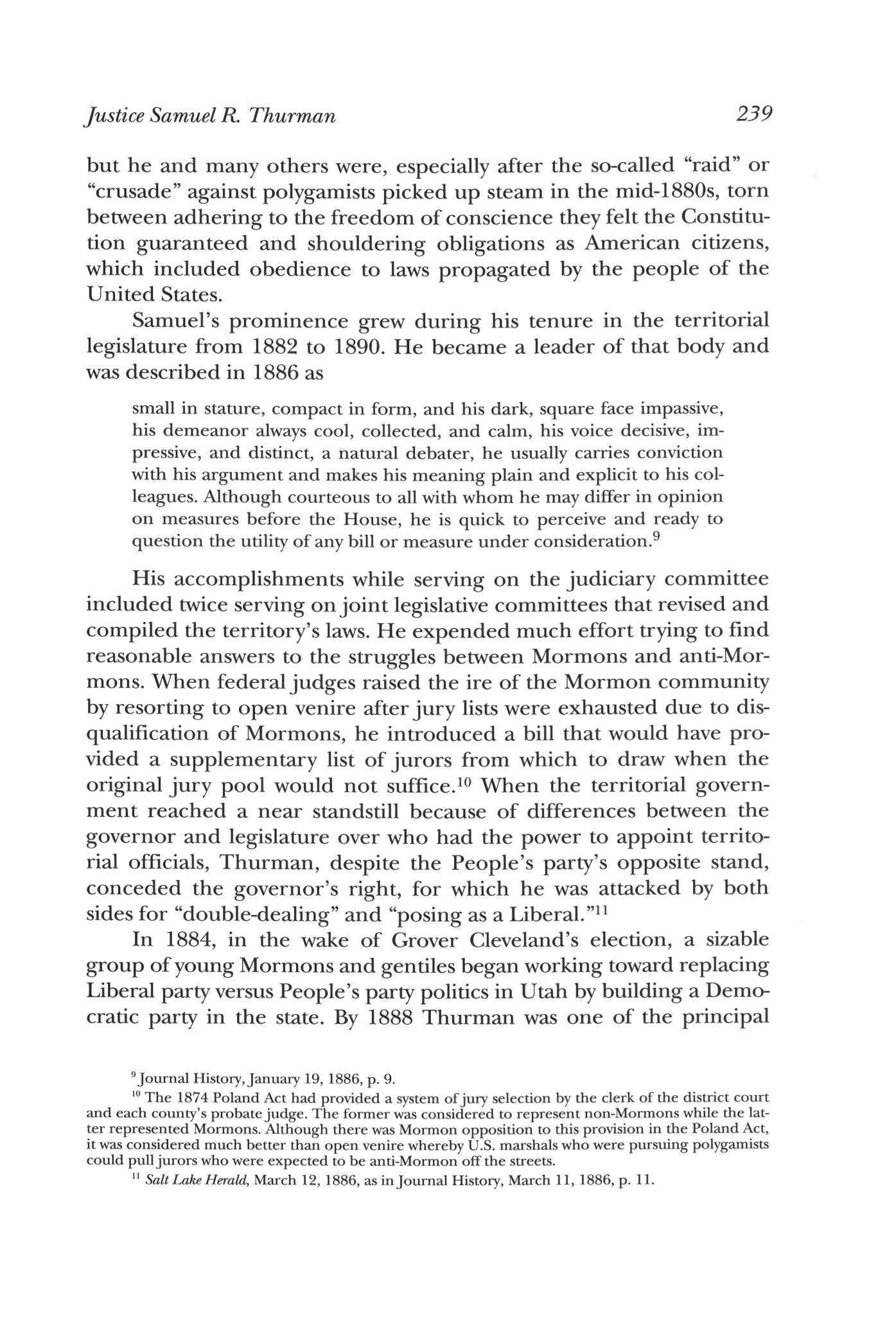
Justice Samuel R. Thurman 239
leaders in the effort, which by then had been abandoned by most of the non-Mormons and was known as the Sagebrush Democracy. Samuel, nominated as the party's candidate for delegate to Congress, became the first person to run for Congress from Utah on a national party ticket. What little hope the Democrats had was demolished when they lost the support of the Salt Lake Herald. Thurman received only 561 votes in the election which People's party candidate John T. Caine won handily. Grover Cleveland also was defeated in 1888, and the vice-presidential candidate who went down with him happened to be Allen G. Thurman, Samuel's distant cousin. Although it is not clear that the short-lived party officially took such a stand, the Sagebrush Democracy was viewed as an advocate of obedience to national laws, including those against polygamy, and of secular government for Utah, free of church control
In March 1887 Congress had passed the even harsher antipolygamy Edmunds-Tucker Act, which had helped motivate the Sagebrush movement. Later in 1887 Samuel served as a delegate to a constitutional convention, the sixth attempt at achieving statehood for Utah. The members of that convention, though predominantly Mormon, were known as nonpolygamist Mormons, and in an attempt to appease Congress and prove their loyalty as United States citizens, they included an article in the proposed constitution prohibiting polygamy Samuel was a member of the committee that visited the Utah Commission to urge an election on the constitution.
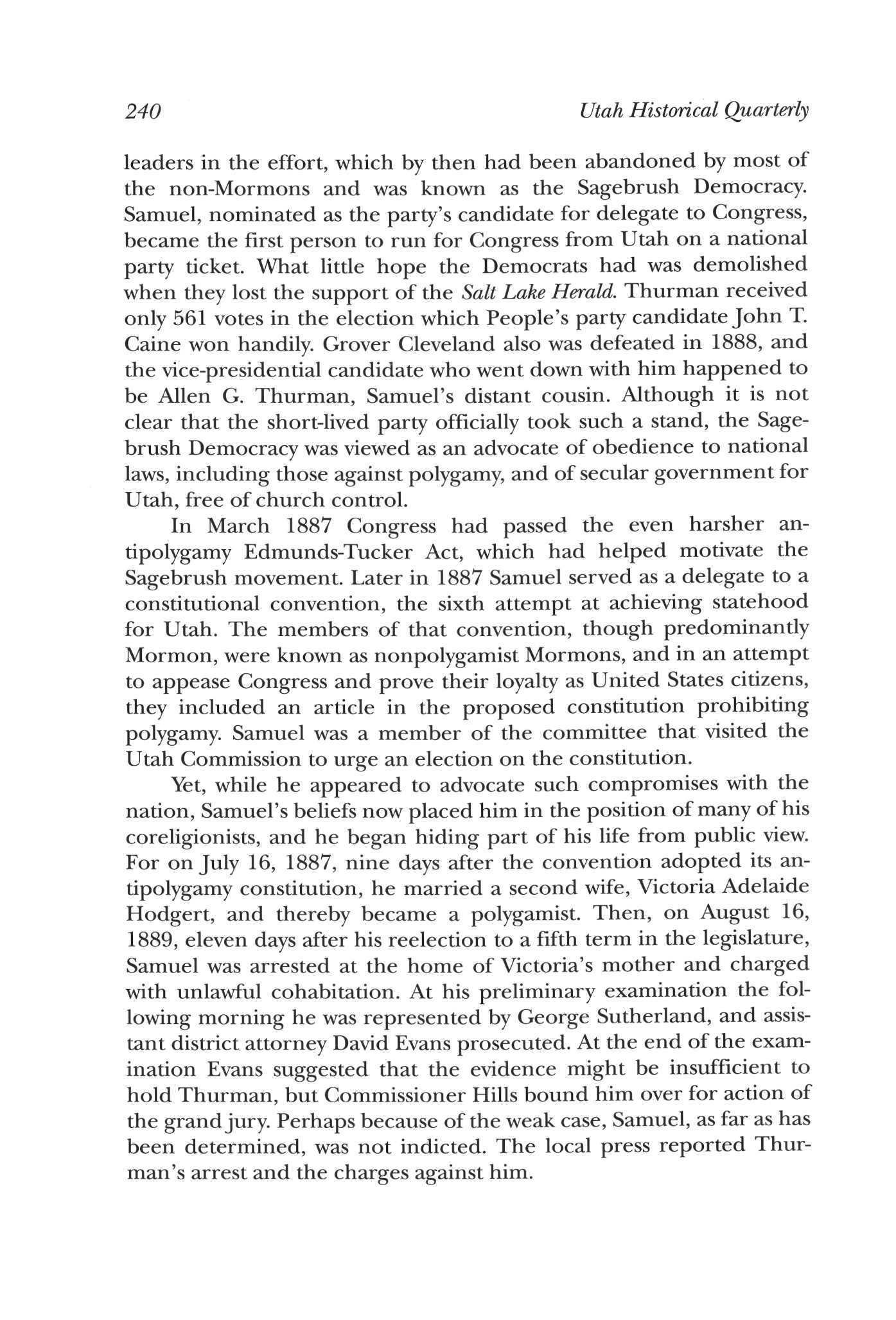
Yet, while he appeared to advocate such compromises with the nation, Samuel's beliefs now placed him in the position of many of his coreligionists, and he began hiding part of his life from public view.
For on July 16, 1887, nine days after the convention adopted its antipolygamy constitution, he married a second wife, Victoria Adelaide Hodgert, and thereby became a polygamist. Then, on August 16, 1889, eleven days after his reelection to a fifth term in the legislature, Samuel was arrested at the home of Victoria's mother and charged with unlawful cohabitation. At his preliminary examination the following morning he was represented by George Sutherland, and assistant district attorney David Evans prosecuted At the end of the examination Evans suggested that the evidence might be insufficient to hold Thurman, but Commissioner Hills bound him over for action of the grandjury. Perhaps because of the weak case, Samuel, as far as has been determined, was not indicted The local press reported Thurman's arrest and the charges against him.
240 Utah Historical Quarterly
By the next year events were moving rapidly toward settlement of Utah's crisis. In September 1890 Wilford Woodruff issued his famous Manifesto promising submission to the laws against plural marriage. Presidential pardons from Benjamin Harrison and Grover Cleveland would come in 1893 and 1894. In 1891 the People's party voted itself out of existence, and two years later the Liberal party followed. The seed Samuel and others had planted in the mid-1880s now took hold as the national Democratic and Republican parties took center stage in Utah politics.
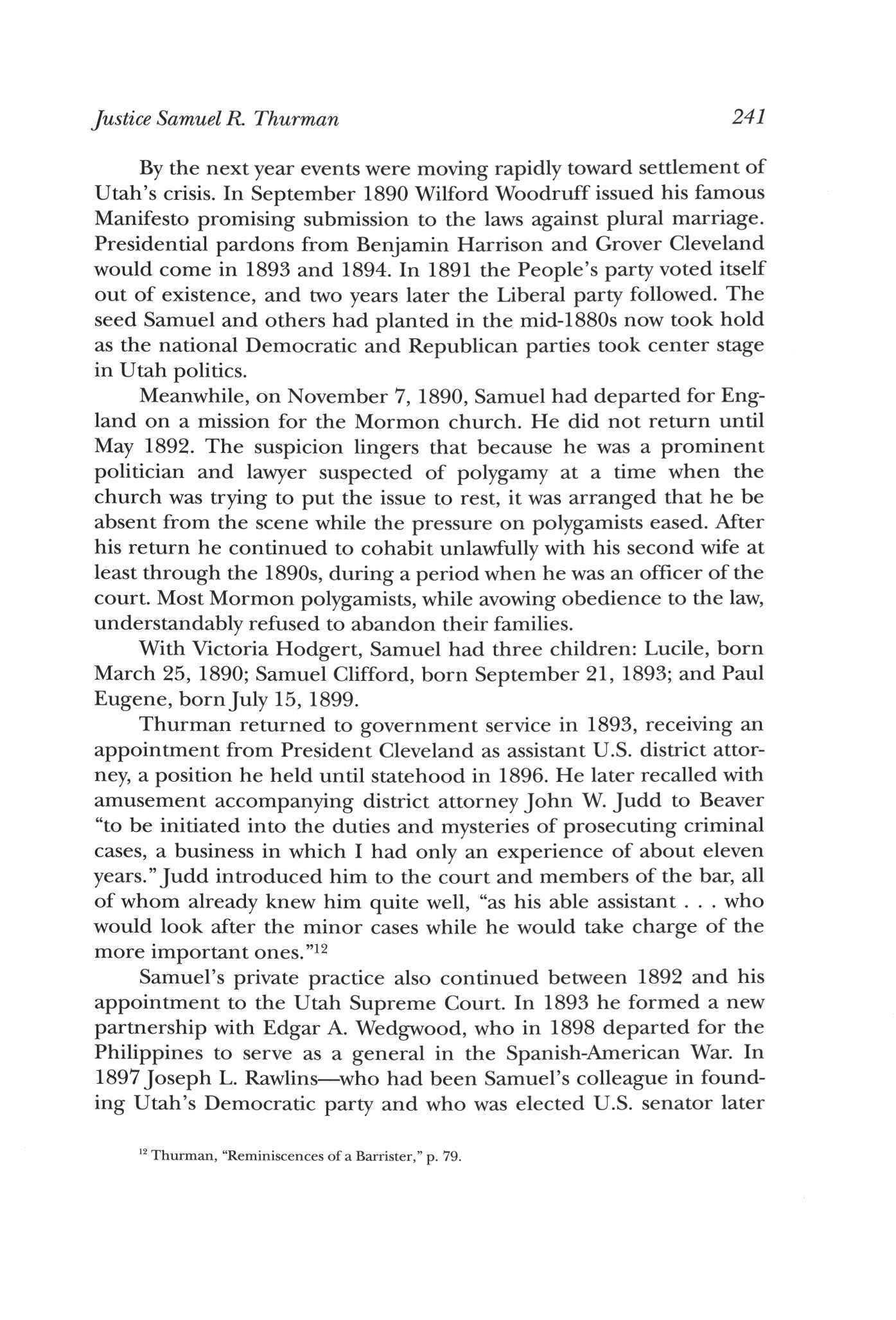
Meanwhile, on November 7, 1890, Samuel had departed for England on a mission for the Mormon church. He did not return until May 1892. The suspicion lingers that because he was a prominent politician and lawyer suspected of polygamy at a time when the church was trying to put the issue to rest, it was arranged that he be absent from the scene while the pressure on polygamists eased. After his return he continued to cohabit unlawfully with his second wife at least through the 1890s, during a period when he was an officer of the court. Most Mormon polygamists, while avowing obedience to the law, understandably refused to abandon their families
With Victoria Hodgert, Samuel had three children: Lucile, born March 25, 1890; Samuel Clifford, born September 21, 1893; and Paul Eugene, bornJuly 15, 1899.
Thurman returned to government service in 1893, receiving an appointment from President Cleveland as assistant U.S. district attorney, a position he held until statehood in 1896. He later recalled with amusement accompanying district attorney John W.Judd to Beaver "to be initiated into the duties and mysteries of prosecuting criminal cases, a business in which I had only an experience of about eleven years."Judd introduced him to the court and members of the bar, all of whom already knew him quite well, "as his able assistant who would look after the minor cases while he would take charge of the more important ones."12
Samuel's private practice also continued between 1892 and his appointment to the Utah Supreme Court. In 1893 he formed a new partnership with Edgar A. Wedgwood, who in 1898 departed for the Philippines to serve as a general in the Spanish-American War. In 1897Joseph L. Rawlins—who had been Samuel's colleague in founding Utah's Democratic party and who was elected U.S. senator later
Justice Samuel R. Thurman 241
12 Thurman, "Reminiscences of a Barrister," p 79
the same year—and J. H. Hurd joined them in the firm of Rawlins, Thurman, Hurd, and Wedgwood. For the first time one of Samuel's firms, previously based in Provo, opened an additional office in Salt Lake City At some point in this period he was also briefly associated withJacob Evans and W E Rydalch In 1902 when General Wedgwood returned from the Philippines the firm of Thurman and Wedgwood was reestablished, and in 1906 they moved to Salt Lake City where Alonzo B. Irvinejoined them in the firm of Thurman, Wedgwood, and Irvine and where Samuel continued to reside. He and his partners were soon especially well known for their expertise in water and irrigation law. Between 1893 and 1912 he was also chief assistant in the legal department of the Denver and Rio Grande Railway.

In 1894 Congress passed the Enabling Act allowing Utah to organize for statehood, and in November Samuel was among 107 delegates elected to the constitutional convention held in March, April, and May 1895 in Salt Lake City. Although Republicans constituted the majority at the convention, Samuel was one of the most active and influential delegates. In terms of number of speeches, his contribution was exceeded only by Republican leader Charles Varian and Democratic colleague David Evans. Thurman served on the Judiciary, the Elections and Right of Suffrage, and the Corporations Other than Municipal committees as well as on a special committee to draft an address to accompany the constitution in its presentation to the people of Utah.
Throughout the proceedings he often interrupted debate with a humorous comment or, more important, with a comment aimed at keeping the convention focused and on course or at urging the members to be economical, diligent, and efficient and to avoid extraneous, redundant, and superfluous discussions and actions, especially on matters better left to the state legislature He worked for separation of school andjudicial elections from the general election with the object
242 Utah Historical Quarterly
Joseph L. Rawlins, Thurman's law partner, also worked with him to found the Democratic party in Utah. USHS collections.
of making them nonpartisan
Regarding judges, he stated that "the object should be to get the best man and unite on him, because he has got to be a man that will be at all times fair,just, and impartial in his decisions."13 His position on school, but notjudicial, elections entered the constitution. He also tried but failed to put stronger restrictions on eminent domain by requiring just compensation before taking property for public or private use, arguing that "the right of property is a sacred right. . .the man who ownsjust one little ewe lamb has just as much right to that as the man has to his cattle that graze on a thousand hills."14 He was more successful in his efforts to ensure that government credit could not be used to aid private enterprises. On other issues that brought much debate and upon which hejoined the victorious side, he favored apportionment that would allot representation by counties and prevent absolute dominance by Salt Lake City, opposed consolidation of the state university and agricultural college at a fixed location, and opposed prohibition.

Probably his most important contribution involved suffrage for women, the issue that occupied the most total time during debate. Both parties had included planks in their platforms advocating suffrage, and Samuel had written the plank for the Democrats. But when the issue came before the convention, anti-Mormons in particular, who claimed Mormon women would merely vote as their husbands did, put up a strong resistance, with support from a handful of Mormons, notably B. H. Roberts. Samuel led the Democrats' effort to steer the article through the convention and, while others spoke at greater length in favor of it, made a particularly effective reply to fellow Democrat Roberts's appeal to expediency (Roberts claimed the article threatened Congress's acceptance of Utah statehood):
God forbid, Mr Chairman, that I should ever be found in a constitutional convention discussing the most important question perhaps that will come before us, and place my entire argument upon the grounds of mere expediencies only, and leave the question of right and justice out of the discussion.15
Women were granted suffrage by the constitution, and many years later Utah's first congresswoman, Reva Beck Bosone, declared, "The
13 Official Report of the Proceedings and Debates of the Convention Assembled at Salt Lake City on the Fourth Day of March, 1895, to Adopt a Constitution for the State of Utah, 2 vols. (Salt Lake City, 1898), 2:1489.
14 Ibid., 1:336-37
15 Ibid., 1:434
Justice Samuel R. Thurman 243
women of Utah should bow low to . . . that great supporter of women's rights, Samuel R. Thurman."16
In 1912 Samuel's labors for the Democratic party resulted in his election as state chairman, a position he held until 1916 When he became chairman the party's fortunes were at a low point due to the effectiveness of Republican Sen. Reed Smoot's political organization, Mormon church presidentJoseph F.Smith's personal endorsement of William Howard Taft for president, and a drain on Democratic votes by the Progressive party. But during Samuel's tenure the Progressive party merged with the Democrats in Utah, and a revival began that culminated in 1916 when Democrats Simon Bamberger, William H. King, and James H. Mays won the offices of governor, senator, and congressman, respectively
The Utah Constitution provided that after 1905 the Utah State Legislature could increase the number of Utah State Supreme Court justices from three to five. On March 10, 1917, Governor Bamberger signed a bill doing just that and immediately ("within approximately thirty seconds," according to the Salt Lake Tribune) named Samuel R. Thurman and Valentine Gideon of Ogden, both Democrats, to fill the new positions, their terms to run until the next election in 1918. On May 8, 1917, they took the oath of office before Chief Justice Joseph E Frick A little over a month later Justice Thurman wrote his first opinion on the court in Coray, Admr. v. Perry Irrigation Co., decided on June 26, 1917.17 Over three hundred opinions would follow, for in September 1918—in response to a letter from forty members of the Utah Bar urging him to do so—Thurman announced that he was a candidate for reelection, and in November he was elected to a tenyear term.

It is impossible to give a fair sampling here of the range of his opinions, but in two early examples he to some extent showed hisjudicial colors by, in the first, expressing his progressive, loose construction view of the constitutionality of legislation and, in the second, strictly defining limits to the powers of the supreme court. In Scranton Leasing Co. v. Industrial Comm. of Utah, decided in January 1918, his opinion upholding the constitutionality of Utah's Workmen's Compensation Act stated that
17 50 Utah 70
244 Utah Historical Quarterly
lfi Beverly B Clopton, Her Honor, TheJudge: The Story of Reva Beck Bosone (Ames: Iowa State University Press, 1980)
Many things in the way of legislation are now done and tolerated which two or three generations ago would not only have been vigorously assailed, as in contravention of the state and federal Constitutions, by the ablest exponents of constitutional law in the country, but would have been judicially condemned and declared void for the same reason. . . . New and different laws have been rendered necessary in order to keep pace with . . . marvelous progress. ... It must be admitted that a large percentage of what is now known as progressive legislation finds justification for its existence in the beneficial effects resulting therefrom, and the apprehensions of danger expressed in many instances have proven to be without foundation.18
In Re Swan's Estate, decided in February of the same year, he held to a strict definition of the constitutional provision limiting the supreme court to consideration of questions of law rather than questions of fact:
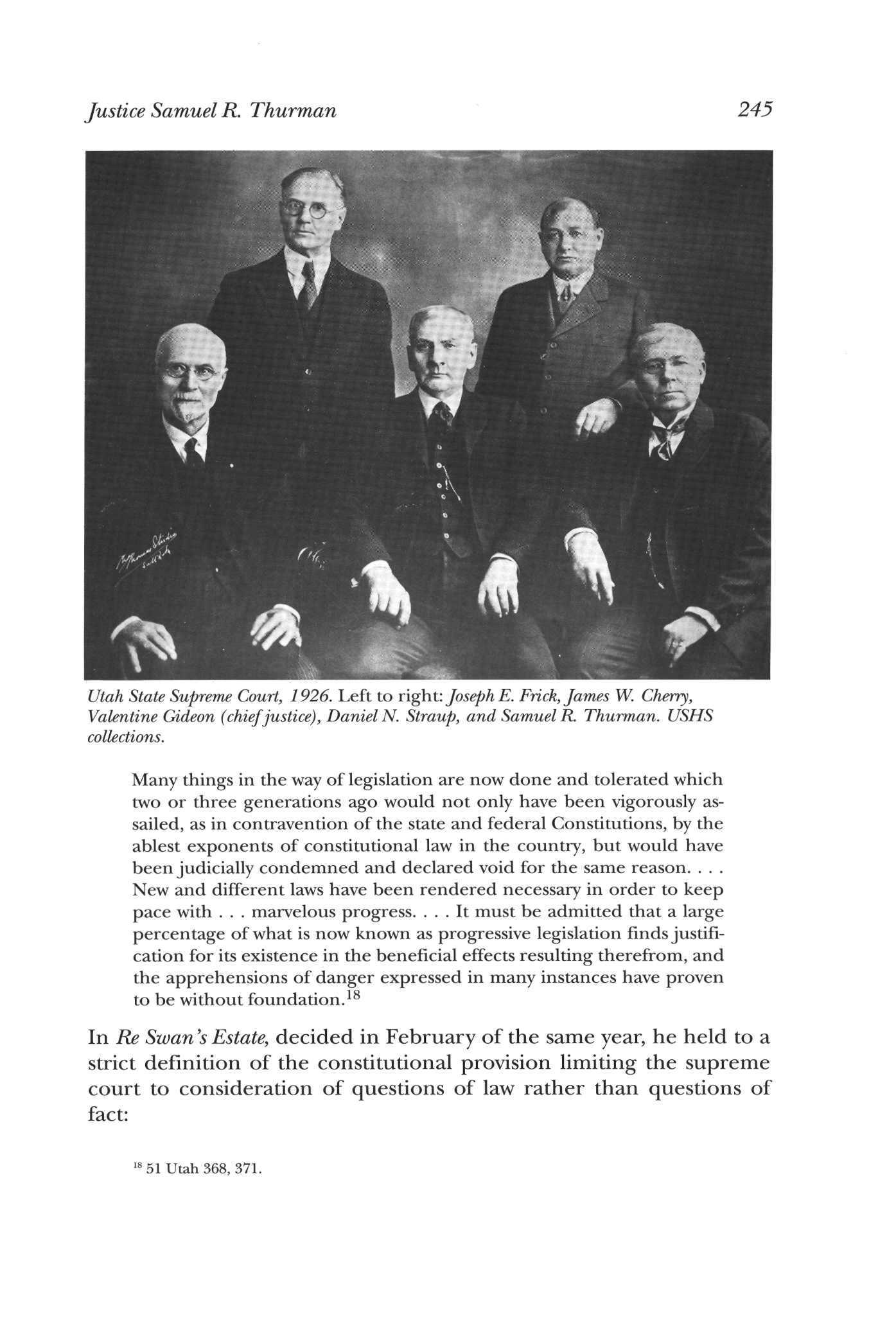
Justice Samuel R. Thurman 245
Utah State Supreme Court, 1926. Left to right: Joseph E. Frick, James W. Cherry, Valentine Gideon (chiefjustice), Daniel N. Straup, and Samuel R. Thurman. USHS collections.
18 51 Utah 368, 371
We hold tenaciously to the opinion that in law cases, in considering the sufficiency of the evidence to sustain the findings of the trial court, we are limited to the consideration merely as to whether or not there is substantial evidence to sustain the findings. If there is,we have no more power, in a case of that kind, to reverse the judgment of the trial court than the trial court would have to ignore or disregard a decision of this court in a matter within itsjurisdiction Whatever may be our inclination .. . to enter upon a more exhaustive examination .. . as to the weight of the evidence, the credibility of the witnesses and the facts, we are restrained from doing so by the fundamental law of the state.19
During his tenure Justice Thurman consistently showed deference and respect for trial courts, which he never referred to as lower courts He was also known for his professional treatment of attorneys appearing before him.
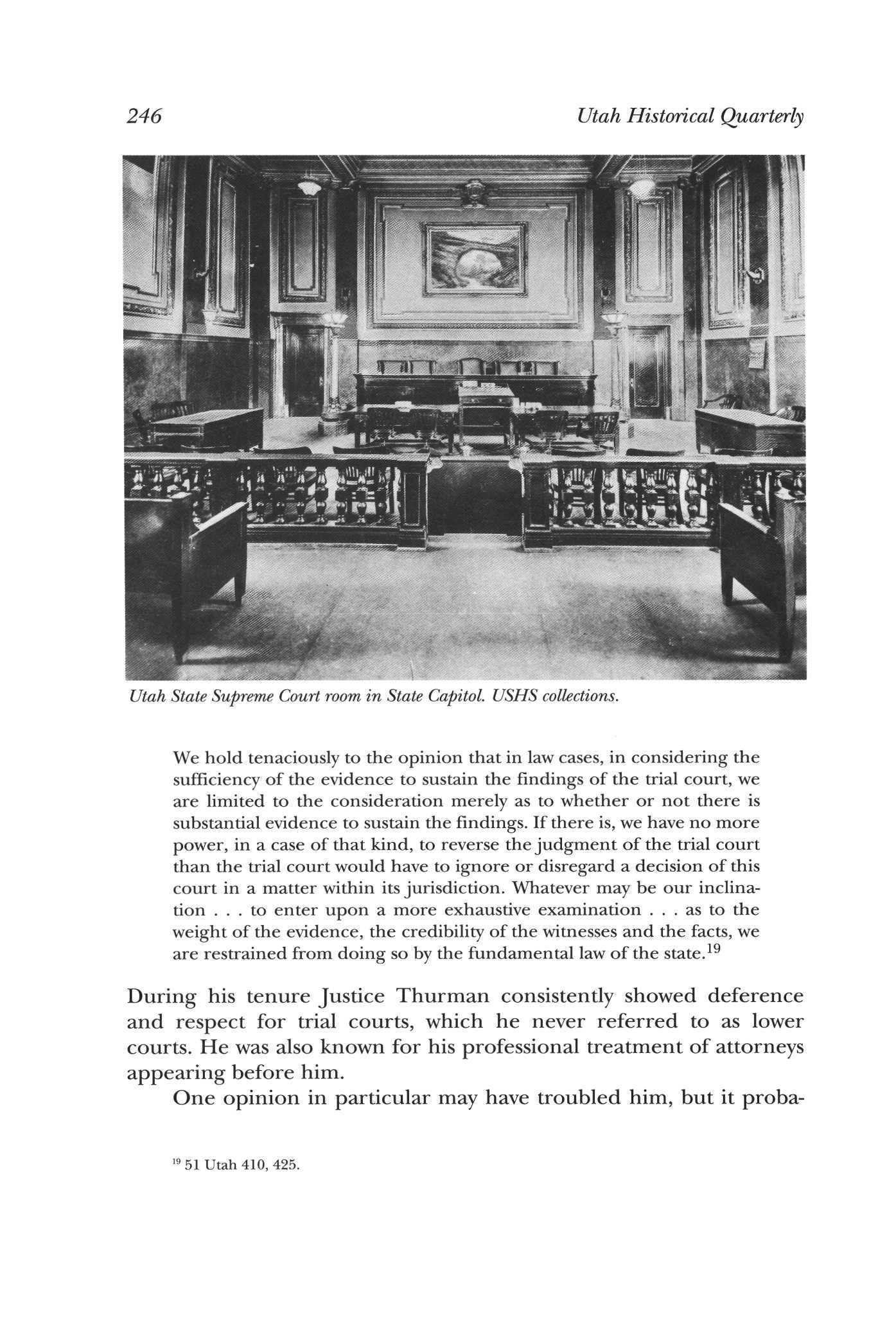
One opinion in particular may have troubled him, but it proba-
51 Utah 410, 425.
246 Utah Historical Quarterly
Utah State Supreme Court room in State Capitol. USHS collections.
blywas also a sincere expression of the conscious inconsistencies with which he and many other Utahns had lived. In March 1926, in State v. Hendrickson, the supreme court affirmed the judgment of the trial court convicting Victor Hendrickson of polygamy. Although this was a case where the appellant's defense was that he honestly believed his first wife had obtained a divorce, Justice Thurman, referring to the demands made by the state's Enabling Act and the pledges made in its constitution to prohibit polygamy, wrote that "good faith and honest intention were not admissible in defense."20 In various circumstances, the conflict between the law regarding polygamy on one hand and faith and honest intentions on the other had troubled Samuel for much of his life.
When his term, during which he had served as chiefjustice from 1927 to 1928, ended, Justice Thurman stood for reelection, but 1928 was a Republican year and he lost to William Folland On his last day in office he recalled his efforts in the state constitutional convention to secure nonpartisan elections for the judiciary and once again urged adoption of such a plan.
Gov. George Dern quickly made use of Thurman's skillby appointing him in 1929 to the State Tax Revision Commission. He returned to the practice of law in partnership with Delbert M Draper and, a few years later, with Irvine, Skeen, and Thurman—the Thurman in this case being his son Samuel D. whose son, also Samuel, would become dean of the University of Utah LawSchool. Sons Richard B.and Allen G. were also distinguished attorneys, Allen serving as a districtjudge Justice Thurman also continued to take an active interest in Democratic politics. He declared that itwas his hobby. He was an avid supporter of Franklin D. Roosevelt and encouraged young Democrats to enter politics Reva Beck Bosone recalled that when she visited him in the summer of 1936 he grasped her hand and said, "Reva, I think you should run for a cityjudgeship this fall and then go on up to the Supreme Court," thus launching her pioneering political career as a judge and congresswoman. 21
Thurman died onJuly 12, 1941,at his home in Salt Lake City. He was ninety-one years old. Among the many tributes, those of colleagues Valentine Gideon and Delbert M. Draper seemed particularly appropriate. Gideon wrote,
67 Utah 15, 24
Clopton, Her Honor, TheJudge, p 90

Justice Samuel R. Thurman 24 7
In the preliminary efforts to see that our Utah was admitted as a state in the Union, he was in the front ranks working to that end He contributed his full share to the establishment of the state government. He has left in the records of this Court his high regard of justice and his knowledge of the law. He was fearless in his application of the law as he saw and understood it, using judgment in its application to particular facts.

Draper stated,
It is easy to describe the spirit of Samuel R Thurman It began in good humor, it grew in tolerance, and ended in love and charity. No man ever looked upon life with more kindly humor No man was ever more ready to find a tolerant reason for the frailties of his fellowmen. No one ever came to the end of a long career with more solicitude for the welfare of his family and friends, his community, and the world.22
248 Utah Historical Quarterly
22 100 Utah xxi-xxiii
Justice A. H. Ellett. USHS collections.
Remembering Justice A. H. Ellett
 BY J ALLAN CROCKETT
BY J ALLAN CROCKETT
UPO N HIS RETIREMENT FROM THE UTAH SUPREME COURT inJanuary 1979, Justice A. H. (Albert Hayden) Ellett chose to entitle his autobiography
FortyJour Years as a RedneckJudge. That isnot by any means a fully accurate characterization, even if it be seen as one aspect of this excep-
Justice Crockett retired from the Utah State Supreme Court in 1981 after thirty years service His reminiscence of Justice Ellett was originally printed in the Pacific Reporter, a case reference work used by lawyers Unless noted otherwise, it is based on his personal recollections
tionally complex person, but it is typical of thejustice's always present and sometimes puckish sense of humor that he accepted that disparaging epithet as applicable to himself.
He was born February 4, 1898, near Huntsville, Alabama, to Martha Catherine Green and Isaac William Ellett While he was still a small boy his parents moved from Alabama to Texas. As to his origins, thejudge stated:

I was born in Alabama of parents who were impoverished by the Civil War and its after effects I had been raised on an isolated farm in Texas . . . .[M]y father went to school for three months and my mother never was a student in any school . . . [but] both parents were well read and unusually intelligent people. 1
His narrative of his childhood in rural east Texas is sprinkled with unusual experiences and pranks indicating a bright mind, a vivacious spirit, and a burning ambition Throughout his book he tells of many bizarre happenings with such engaging candor, whether they reflect on him favorably or otherwise, as to bring to mind the declaration of Rousseau in his Confessions: "I hold that I have been as good and as bad as any man."
It is hoped that this memoir will not only include the basic facts about his life and career but also reflect something of the color and qualities of his personality and of his purpose in life. This objective will be aided by quite freely incorporating some of his own expressions.
He had no hesitancy in emphasizing the meagerness in material things in connection with his family's industriously eking out their living from the soil. This fact and his sense of humor are illustrated, if a bit exaggerated, by one of his half-truth yarns: "I can't really say that I was raised in a log cabin—but my folks moved into one as soon as they could afford it."
At the age of seventeen he became a teacher—he qualified by examination—and taught two years in a multiple-grade grammar school; later, by the same process, he became a teacher in high school where he taught a variety of subjects for another two years in Texas. In 1916 he followed members of his family in joining the LDS church and later moved to Utah where he taught school in the small town of Lake Shore in Utah County for two years.
There he met Florence Rowe whom he married in 1924. They became the parents of four children: Kenneth, Walter, Jeanne, and Ann
250 Utah Historical Quarterly
1 A H Ellett, Fortyjour Years as a Redneckjudge (Salt Lake City: Author, 1983), p 1
who died in childhood Florence died in January 1975, and a year later Ellett married Miriam Parker who became and remained his loyal and caring companion until he passed away November 30, 1986.
Consistent with his desire for learning and his ambition for advancement, while teaching school he studied accounting; in 1923 he went to work as an accountant for the United States Smelting and Refining Company where he worked for seven years. During that time he took correspondence courses in law. He passed the bar examination and was admitted to practice in 1930. In 1933 he was appointed deputy Salt Lake County attorney and continued in that office until he was elected Salt Lake Cityjudge in 1934.
Neither was he shy in telling about the unusual way in which he obtained his education and training. He seemed either to have a sense of self-consciousness about being a correspondence-school lawyer or to have an inverted pride in that fact. About that he noted:
You know me inside and out; so write anything you want, but heed Clarence Darrow's request of his wife: "When I pass on, getJudge Watson to talk at my service; he knows all about me, and has sense enough not to tell it." If you include the fact that I am a correspondence school lawyer, I am not of the regular run. I took courses from LaSalle Law School, and the American Law School, and I graduated and received my LL.B. from Blackstone Institute.
He saw the dangers of lack of learning but was even more concerned with the illusion of learning, that is, assuming that one knows enough, which leads to stagnation. Due to his brightness of mind, his never-ending curiosity in all fields of inquiry, he continued for years to take correspondence and extension courses in such widely diversified areas as physics, geology, astronomy, and Spanish He reported:
"In addition to my law studies I have engaged in other educational pursuits I have acquired about five hundred hours of college credit, much of which was taken by extension and correspondence, so I am not ashamed of my education or training."
Though his education was acquired in a somewhat spotty and unusual way, it can be said with assurance that even if he did not concern himself much with academic credentials it is likely that none other of our judges has had a wider or more thorough knowledge across the whole spectrum of learning. This all fits into the pattern of his life of extraordinary achievements, beginning with his becoming a certified schoolteacher at age seventeen without ever having graduated from high school. He became a member of the bar without having graduated

A.
251
Justice
H. Ellett
from college and ajudge, a Utah Supreme Courtjustice and chiefjustice, and an instructor in the National College of State Trial Judges without ever having graduated from a resident law school.
As a cityjudge he industriously devoted his superior abilities to keeping his own and the otherjudges' calendars up to date. A significant characteristic was his almost fierce determination to maintain his independence as ajudge, free of control or interference by anyone. One of the consequences of this was his refusal to go along with an ongoing program of prearranged fines and forfeitures in vice cases. Conflicts over this led him to make some shrewd discoveries and suggestions, which in turn led to an investigation and exposure of corruption in the city police department, resulting in several convictions, including the then chief of police and mayor of Salt Lake City.
In 1940Judge Ellett was elected to the district court. During his long tenure of twenty-sixyears there (1941 through 1966) he continued with resolute determination to improve the processes ofjustice. He was one of the pioneers in the use of pretrials and in the obligatory acceptance of indisputable facts or imposing penalties for refusing to do so. It can fairly be said that he did more to eliminate nonessentials and to facilitate and expedite procedures than any otherjudge in our history.
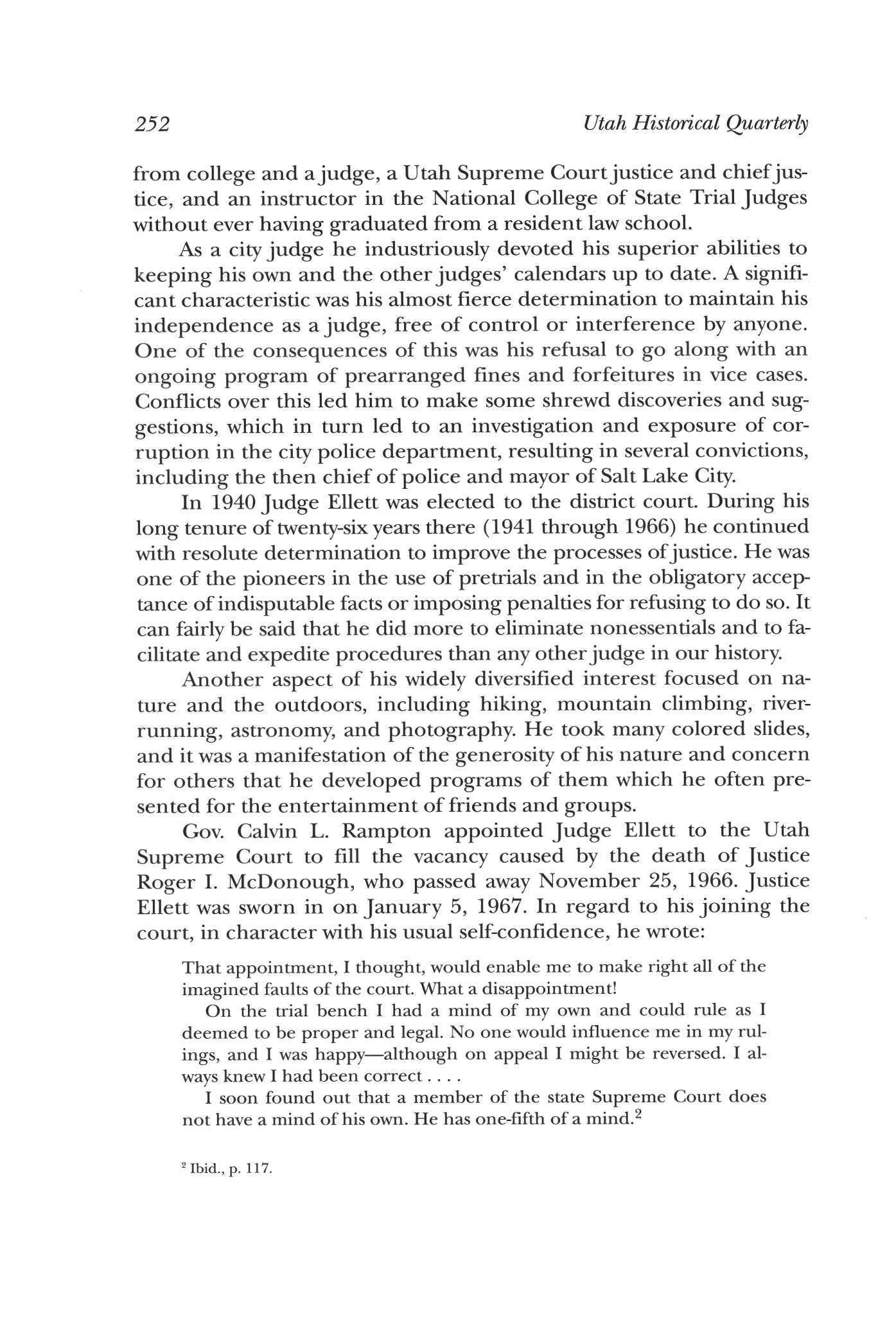
Another aspect of his widely diversified interest focused on nature and the outdoors, including hiking, mountain climbing, riverrunning, astronomy, and photography. He took many colored slides, and itwas a manifestation of the generosity of his nature and concern for others that he developed programs of them which he often presented for the entertainment of friends and groups.
Gov. Calvin L. Rampton appointed Judge Ellett to the Utah Supreme Court to fill the vacancy caused by the death of Justice Roger I. McDonough, who passed away November 25, 1966. Justice Ellett was sworn in on January 5, 1967. In regard to hisjoining the court, in character with his usual self-confidence, he wrote:
That appointment, I thought, would enable me to make right all of the imagined faults of the court. What a disappointment!
On the trial bench I had a mind of my own and could rule as I deemed to be proper and legal. No one would influence me in my rulings, and I was happy—although on appeal I might be reversed. I always knew I had been correct...
I soon found out that a member of the state Supreme Court does not have a mind of his own He has one-fifth of a mind.2
252 Utah Historical Quarterly
Ibid., p 117
2
Justice Ellett served the remaining two years of Justice McDonough's term and then was elected to a full term of ten years. As his opinions in the books will show, he continued in his capable and industrious way to render a very creditable service until he retired in January 1979.
To a far higher degree than most people he had a never failing insight into the humorous angles of most everything so that with him it was always so close to the surface that it was an important part of his personality, and he took such pleasure in using it to brighten the lives of others that no writing about him would adequately reflect this unique quality without some examples of his stories.
At Sunday service at the prison, following the LDS practice of audience participation, a prisoner was asked to offer the invocation. After appropriately addressing Deity his prayer was in part thus: We thank Thee that so many of us are able to be here this morning—under such safe and secure circumstances We trust that others who ought to be here will be here next time; and that at the conclusion of this service, we may be permitted to return to our homes in safety.
He enjoyed buttering up others, particularly the fair sex. He said, "It is not to be wondered at that the Creator fashioned man first and then woman. For, everyone knows that every great artist and craftsman first fashions a rough model, then creates his masterpiece. Anyway, He probably didn't want any advice on the project."
A. H. Ellett had the rare quality of seeing humor when he was himself the butt of the joke. He reported a discussion he had with a state senator regarding the comparative inadequacy ofjudges' salaries, wherein he told the senator, "Why, I have men on probation who are making more than I am," to which the senator responded, "Well, Judge, maybe you better resign and go on probation."
In addition to his capable and effective services as a state judge and his worthwhile accomplishments therein, there is another outstanding aspect of his career: his determined and unrelenting attack upon the federal government and its courts. He stated: "My tenure on the Supreme Court gave me an opportunity to bring to the attention of the nation the encroachment of the federal judiciary into matters which belong solely to the states."
In view of the fact that he saw this as such an important part of hisjudicial career, and because it represents an insight into his conditioning and his thinking, it is appropriate to state a summary of his views on that subject His starting point was his emphasis on the fact

Justice A. H Ellett 253
that the founding fathers regarded each of their own colonies as a sovereign state and that they were willing tojoin in a union of a central government only if their own separate sovereignty was also preserved as a safeguard against a too strong and domineering government such as that from which they hadjust freed themselves For that reason, the Tenth Amendment to the United States Constitution expressly provided that all powers not delegated to the federal government are reserved to the states, or to the people, and the Ninth Amendment provided that the powers which are granted should not be construed to include others not so granted.
His thesis proceeded: Notwithstanding the precautions just referred to, there has been a constant and seemingly endless process of the federal government, more especially the federal courts, arrogating to themselves more and more of the powers not only not granted but expressly forbidden them This has been accomplished largely through unjustified reliance on the Fourteenth Amendment, adopted in 1868 after the Civil War to provide all persons with equal protection of the laws and to prevent anyone from being deprived of life, liberty, or property without due process of law
He placed emphasis on his opinion that that amendment was never lawfully adopted, because its inclusion in the Constitution was accomplished by duress and coercion of certain southern states and by excluding others from their right to vote upon the amendment; and he urged that in any event it should not be regarded as conferring any new or different authority upon the federals because comparable "due process of law" language was used in the original Fifth Amendment. Without going into further detail, if the facts as stated are accepted, he set forth in his opinion in Dyett v Turner5 what impressed him as a very plausible argument in support of his contention Perhaps it should be noted here that however plausible that argument may be, no other justice of the court concurred in that opinion Justice Ellett undoubtedly had no realistic expectation that the Fourteenth Amendment would be declared invalid. Yet about his Dyett case he said: "I feel so certain that the law set out in that opinion is correct that I have never receded . . . [but] have consistently reaffirmed that position."
It was his view that the federals have used their unrestrained power to arrogate to themselves an unjustified concentration of

254 Utah Historical Quarterly
3 20 Utah 2d 403, 439 P.2d 266
power, thus leading toward the disruption of the balance of power intended by the framers of the Constitution, which he said is a clear vindication of the fears of too great a centralization of power as uniformly expressed by them, particularly by Jefferson, Madison, and Hamilton, and this is why the Constitution's framers carefully crafted our government with a balance of power between three coequal branches, so that each could act as a check upon the other; and also of the greatest importance, that was their reason for providing a further check against uncontrollable power by reserving to the states all powers not expressly granted to the federal government. Moreover, and also of grave significance, he reflected that this was done in full awareness that history plainly teaches that unrestrained power not only leads to the oppression of those subject to it, but of equal apprehension it almost always feeds upon itself and leads to its own destruction.
He averred that by their insatiable desire for power, resulting in the judicial legislation referred to above, the federals unjustifiably and unwisely intruded into and asserted control over numerous things in which they had no right to be concerned: operation of schools, busing of students, running of prisons and hospitals, and an unending list of matters not within the scope of their authority. It was his thought that federal intrusion, remote from local problems and governments, has resulted in evermore numerous, complex, and oppressive laws so that the protections the founding fathers intended for us are being "interpreted," i.e., extrapolated or distorted, in such a one-sided manner in favor of the antisocial and criminally inclined that they are assured ever greater protections from prosecution, and scoundrels are given license to prey on the honest and law-abiding citizenry without being brought tojustice Closely related to the above, it wasJustice Ellett's firm and often-stated conviction that these evils are contributed to and intensified by the frictions between two judicial systems, state and federal, with their frequent overlapping and duplications, conflicts, sometimes endless delays, and the thwarting of justice. He was especially annoyed by the practice of the federal courts issuing writs of habeas corpus, by which on practically any pretext of an issue under the federal Constitution, they assumed the prerogative of reviewing the proceedings and decisions of the state courts, all of which interferes with and delays effective law enforcement and contributes to public disrespect of the law and for the courts.
The keenness of his disagreement with some of the rulings of the

Justice A. H Ellett 255
United States Supreme Court was evidenced in his caustic attack set out in the case of Salt Lake City v. Piepenburg4 relating to pornography. He let "certain justices" of that high court have a colorful barrage of criticism. He pointed out that their definition that subject matter should not be held obscene unless "when taken as a whole, [it] lacks serious literary, artistic, political, or scientific value" leaves room for inclusion of the subject matter of that case which he characterizes as "shameful . . . ."In unrestrained enthusiasm for his point he proceeded with denunciatory invectives which can be spared repetition here He epitomized his attack by this declamation: "God save the country; the Supreme Court of the United States is not going to do it."
It should be clearly understood that he was an individualist who forthrightly expressed and firmly stood on his convictions. Indeed, the sometimes-quoted aphorism can aptly be applied to him: "He was not stubborn, just determined like a mule." He was neither discouraged nor dissuaded by advice that his efforts were but quixotic tilting at windmills. He had an abiding conviction that what he regarded as truth and righteousness are powerful weapons and that if he kept hammering away with them in the most strident invective he could muster, others would join him and they would have some effect and, in any event, it is better to try in a noble cause, even though you fail, than to succeed in an ignoble one.
He also wrote that from his experience and observation, he thought that the appellate courts spend much too large a portion of their time and efforts in writing opinions dealing with issues that have already been decided and written about, which amounts to little more than moving dead bones from one place to another, but a very small portion of them actually make any new and significant contributions to the law. If they would reverse that time use and spend more time just deciding cases and less time writing useless opinions, they could, without sacrificing thoroughness or efficiency, greatly minimize delays in the processes ofjustice.
Whether or not one agrees with Justice Ellett, it can neither be denied nor ignored that he clearly and forcefully called attention to some important problems which many thoughtful people, including lawyers and judges, think are real hazards to a continuance of the good order and well being of our country and which need to be dealt with in a serious way.
4 Utah, 571 P.2dl299.
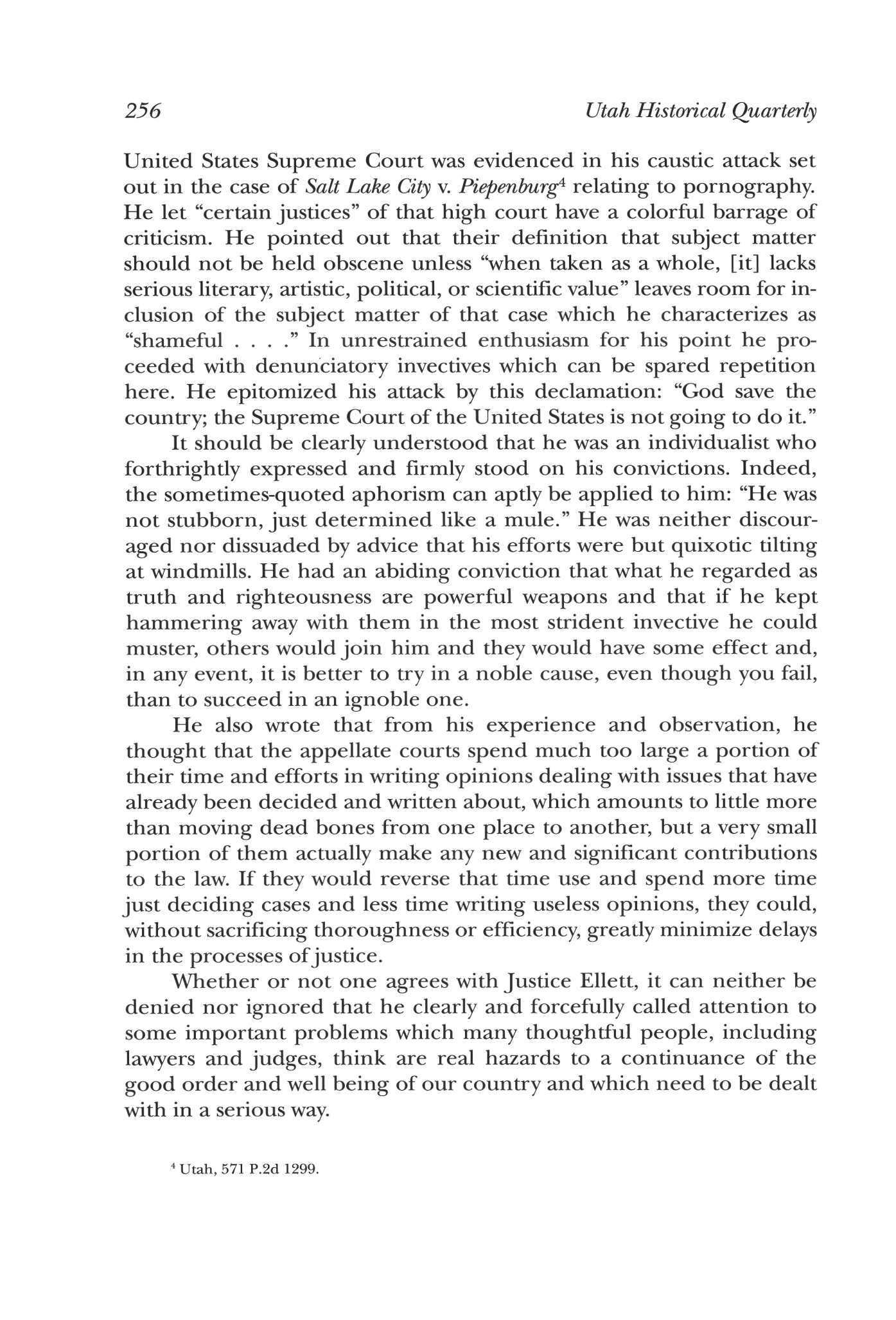
256 Utah Historical Quarterly
It is not to be doubted that at some times and about some matters he seemed to be a bit feisty or even disposed to opposition or antagonism. This was undoubtedly because he was a restless inner-directed soul, sensitive to the basic anxieties of the whence, why, and whither of life. He was not content to accept things as they are but was constantly endeavoring to change them to what he thought they ought to be. His actions are reminiscent of the saying, "Life is never dull except to dull people." His life was never dull.
Those who knew him will agree that he was an intelligent, well informed, especially capable, and truly dedicated judge whose main purpose in life was in harmony with the thought expressed by Chief Justice Earl Warren to the Conference of ChiefJustices: "One who devotes his life and efforts to the cause of justice under law renders a service not only of great benefit to his fellow men, but also to himself in satisfaction and fulfillment."
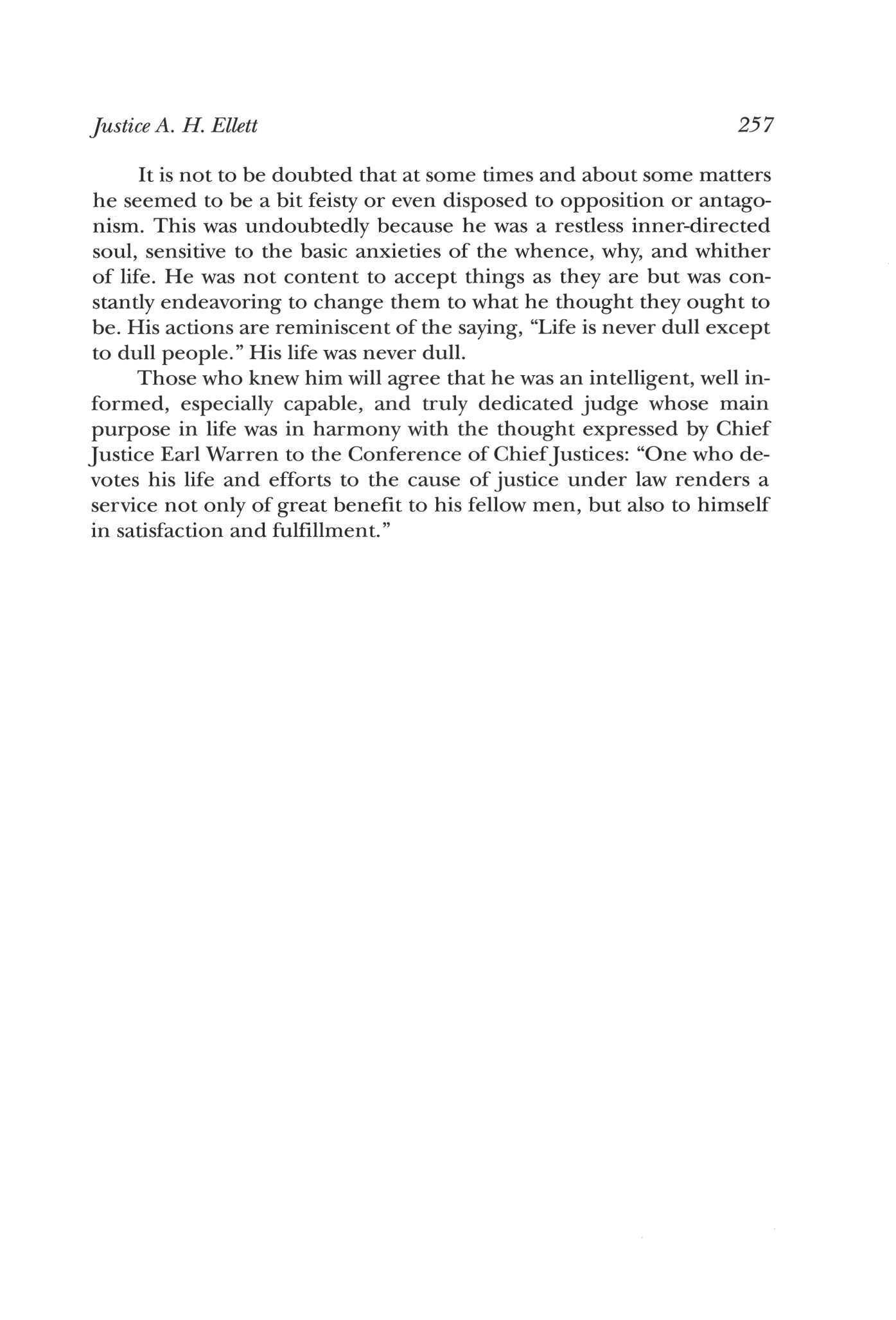
Justice A. H Ellett 257
Many early courthouses have been replaced or remodeled over the years. The 1890 Davis County Courthouse, designed by Kaysville architect William Allen, was altered beyond recogniton during a 1931-32 expansion and remodeling. Photographs accompanying this article arefrom USHS collections unless credited otherwise.

County Courthouses of UtahA Photographic Essay
BY ROGER ROPER
Mr. Roper is coordinator of the historic preservation program of the Utah Division of State History Most of the information for this article was drawn from National Register forms on file in the preservation office
COUNTY COURTHOUSES ARE AMONG THE ROYALTY OF Utah architecture
Only the State Capitol, major religious buildings, a few collegiate structures, and a handful of other buildings rival or overshadow them in scale, visibility, and architectural distinction. In smaller communities, Beaver, Farmington, and Junction, for example, they dominate the civic landscape. Their presence confirms a city's status as county seat, a chosen elite among its neighboring cities
The general trend of courthouse architecture has been from simple to more complex. Many of the first courthouses were boxlike rectangular buildings with restrained classical detailing on the exterior and a single room on the interior. They often served multiple purposes in a community, housing civic, social, and even religious functions. Later, as counties became more populous and the role of government more pervasive, courthouses became larger and more complex. They contained offices designed specifically for the county officials—recorder, assessor, clerk, treasurer, and so forth—and a separate courtroom. Offices were usually located on the main floor, the courtroom andjudges chambers on the second floor, and thejail and sheriff's offices in the basement. Basement jails were apparently not always adequate, so separate jails were subsequently built behind many courthouses.
Although there were no written guidelines for courthouse construction, there was apparently a basic understanding of what constituted an appropriate design and setting, especially in the nineteenth century when most of Utah's first courthouses were built. They were always centrally located within the city, usually near the principal intersection, and often adjacent to the church and other principal buildings. Courthouses in Coalville, Price, and Provo, for example, were located across the street from LDS tabernacles, while the one in Heber City shared the same block with the Wasatch Stake Tabernacle.
The setting of courthouses also reinforced their important and central role in their communities. They were usually set farther back from the street than adjacent buildings, often in the middle of a large, well-landscaped lot. In larger counties, such as Salt Lake, Utah, and Weber, they occupied an entire city block This drew attention to the building and created an atmosphere of distinction and respect for the activities of county government carried on within
In terms of styling, courthouses generally conformed to the architectural conventions of the period in which they were built. The earliest examples in Utah were usually either Federal or Greek Revival stylebuildings.These styleswere common for most other Utah buildings

County Courthouses 259
during the 1847-70s period as well Americans embraced these "classical" styles into the late nineteenth century, especially for civic architecture, as symbols of ancient republics and of the New World democracy they had formed
In the late 1800s new architectural styles emerged that communities deemed sufficiently dignified and appropriate for courthouses. These included Victorian designs with towers and elaborate detailing, as found in Beaver and Piute counties, and the round arches and sandstone textures of the Richardsonian Romanesque style exhibited on the Summit County Courthouse and the Salt Lake City and County Building, Utah's foremost example of the style
Twentieth-century courthouses tended to be larger than those built in the 1800s, reflecting again the growth of population and government A number constructed in the 1910-30s replaced earlier buildings that were too small or outmoded for modern county operations The newer structures also had a more horizontal emphasis, as opposed to the vertical appearance of the Victorian-era buildings. (This shift toward the horizontal is also visible in schools of the period.) A horizontal layout reduced the number of floors—and stairs— by providing more office space on each floor.
Architectural styles for twentieth-century courthouses were derived from both historical and modern sources. The Neoclassical Revival style of the early 1900s (good examples include those in Utah and Box Elder counties) was a more elaborate expression of the simple classicism of Utah's first courthouses, while the Art Deco (Weber County) and PWA Moderne styles of the1930s (Sanpete, Grand, and Wayne counties) reflect new trends in architecture.1
The county courthouses highlighted on the following pages include only those that have been recognized for their historic and architectural significance by designation to the National Register of Historic Places.2 These buildings exhibit a level of architectural dignity in keeping with their role as cornerstones of the American governmental system. Newer courthouses often lack this character. The newer buildings express efficiency and functionality but fail to awaken the almost religious emotions evoked in many older courthouses, which communicate very clearly that they are special places worthy of admiration and respect.
1 For more information on architectural styles see Peter L Goss and Thomas Carter, Utah's Historic Architecture, 1847-1940: A Guide (Salt Lake City: University of Utah Graduate School of Architecture and Utah State Historical Society, 1988)
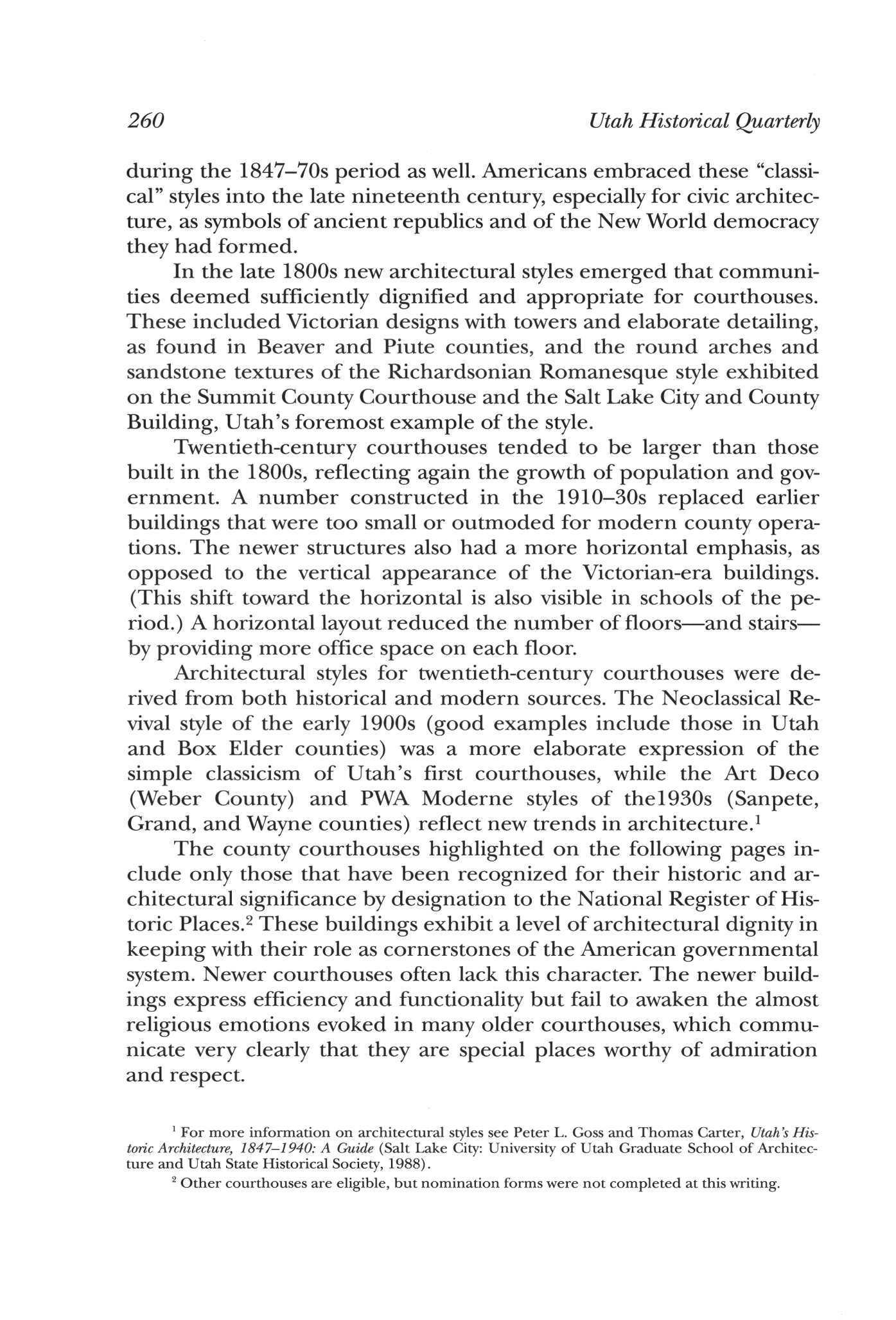
260 Utah Historical Quarterly
2 Other courthouses are eligible, but nomination forms were not completed at this writing
Beaver County Courthouse, Beaver: This picturesque
Queen Anne style building, photographed in 1968, was completed in its presentform in 1889 following afire in the upper story. The original was built in 1876—82 under the supervision of aformer Union soldier stationed at nearby Fort Cameron. The 1889 renovation, including the dominant clock tower, was designed by Richard K A. Kletting of Salt Lake City, whose distinguished career earned him the title of "dean of Utah architects." Later additions on the rearprovided vaults and a newjail to replace the original located in the right front basement room. The historic second-floor courtroom is the best preserved in Utah.

I
P |n,„„,,ji»
i • r 1
DUB*"
SB IB
• Ht
Box Elder County Courthouse, Brigham City: Though dominated by its 1910 Neoclassical front section, the building below includes the original 1857 structure, making it the oldest remaining courthouse in Utah. Above left: The original adobe building in a dignified Federal style was located at Main and Forest streets. Above center: It was updated in 1887 with an Italianate style cornice, window heads, and a clock/bell tower. Forest Street was eventually closed off, allowing more extensive landscaping. (Photo taken 1909. Courtesy Compton Collection, USU Special Collections.) Below: Local architects Funk and Wells designed the 1910 Neoclassical addition. The 1887 tower was removed and a larger tower centered on the new section. (Photo taken 1916. Courtesy Compton Collection, USU Special Collections.) Above right: The 1857 section is still visible on the rear of the current courthouse.

Cache County Courthouse, Logan: This courthouse, constructed in 1882—83, replaced a frame county building on the site. Salt Lake architect Truman O. Angell,Jr., drew the plans, and the contract was let to the United Order Manufacturing and Building Company of the Logan Second Ward (LDS). Workers used local materialsfor all but thefinishing touches. An addition to the rear ca. 1905 and two wings added to thefront in 1917 expanded the building to its current size. It has served continuously as the center of Cache County government. Photographs, taken in 1904 and ca. 1968, courtesy of Special Collections, Utah State University.
Juab County Courthouse, Eureka: This 1891 building was one of three courthouses in Juab County. The main courthouse, where official county records were kept, was in Nephi, the county seat. County officials apparently felt the need for precinct courthouses in Eureka and Silver City to accommodate the goings-on in the booming Tintic Mining District. The Silver City courthouse is gone, and only the rear wing of the Nephi building remains. The original Eureka structure, now entirely stuccoed, was stone with a brickjail on the rear. It also served as the Eureka City Hall until 1899, when the city built a facility.

Piute County Courthouse, Junction: An 1892 bond election tofinance a courthouse was defeated, but the 1902 effort succeeded. Completed in 1903 at a cost of $7,670, this Victorian Romanesque Revival structure was designed by Provo architect Richard C. Watkins. Though damaged byfire inJanuary 1944, the building retains a high degree of architectural integrity. It looms castlelike in this rural landscape, flanked by large trees and afenced expanse of lawn. Photograph was taken in the 1970s, prior to the building's rehabilitation.
Sanpete County Courthouse, Monti: This 1935—37 building, photographed as it neared completion, replaced the old courthouse on this site. Salt Lake architect Lorenzo S. Young designed the building, using local oolite limestone worked by skilled local stonemasons. The style has been termed PWA Moderne in recognition of the stripped-down classical/modern designs often v ;d on buildings constructed by the Public Works Administration; however, the $90,000 structure was actually financed by the Federal Emergency Relief Administration (FERA). 77^Manti Messenger observed on March 8, 1935, thatFERA regulations might lengthen the construction period, but that was "of little consequence. The important thing is thefact that Sanpete County is to have a building it needs. "

The City and County Building was sensitively rehabilitated in the late 1980s and currently houses only city offices. Aerial view (1972) looking south shows parklike setting of Washington Square. Elaborate east entrance has been the backdropfor many activities.
Salt Lake County Courthouse, Salt Lake City: The Salt Lake City and County Building is the largest and most recognizable of Utah s courthouses. Erected in 1891—94, this Richardsonian Romanesque style building was designed by local architect Henry Monheim and the Kansas City-basedfirm Bird & Proudfoot. Kyune sandstonefrom Summit County was used on the exterior. In addition to housing both city and county offices (north and south wings, respectively), it also quartered state government from 1896 until the Capitol was completed in 1915.

Summit County Courthouse, Coalville: At a special election in thefall of 1902 to decide whether the county seat should remain in Coalville or be relocated to the prosperous mining town ofPark City the economic hub of the county Coalville emerged victorious and immediately began to erect a new courthouse to secure the victory. County officials hired Ogden architect F. C. Woods to design the building. Locally quarried white sandstone was used to construct the striking Romanesque Revival structure. It was completed in 1904 at a cost of $20,000, and thefollowing year a matching jail was built behind it. In 1980-81 a large rear addition necessitated removal of thejail. Photograph was taken in 1964.
Tooele County Courthouse, Tooele: The symmetrical, rectangularform of this building is typical of civic and church buildings erected throughout Utah in the early decades of settlement. It was built in 1867, just afew years after Tooele City was designated the Tooele County seat. The Victorian style belfry was probably added in the 1880s. The courthouse was occasionally usedfor community dances and dramatic productions in its early years and also served as the Tooele City Hall until 1941. A new courthouse was built in 1899 (now demolished). The Daughters of Utah Pioneers have leased the building since 1942. The ca. 1960s photograph shows it prior to an addition on the right (east) side connecting it to the adjacent Carnegie Library.

Utah County Courthouse, Provo: This Neoclassical style building is perhaps the most elaborate and refined of Utah's courthouses. Itfeatures a raisedfoundation ofgranite, white oolite limestone walls, Alaskan marblefloors, and pink marble balustrades and staircases. A statue ofJustice is centered over the entrance, flanked by depictions of various arts and industries. Provo architectJoseph Nelson designed the building after a West Coast tour with city officials to get ideasfrom civic buildings there. Construction started in 1920 and was completed in 1926. Photograph was probably taken soon after. A new court and county complex was constructed behind this building in the late 1980s.
 This 1930s aerial view shows the location of the Utah County Courthouse in the heart of downtown Provo.
This 1930s aerial view shows the location of the Utah County Courthouse in the heart of downtown Provo.
Washington County Courthouse, St. George: Work commenced on this Federal style building in 1866, just five years after the community was settled. Financing proved difficult in the local barter economy; it took ten years to complete the project. The brick was made at the site, and stonefor thefoundation was obtained locally. The cube shape was commonfor civic buildings of the period. This building, as photographed in 1934, is the best preserved ofthe earliest generation of courthouses in Utah. It served as the county courthouse until 1960. Thejail built behind (now demolished) replaced the basement cells.
Weber County Courthouse, Ogden: This twelve-story building was erected in 1938-40 to housefacilities ofboth Ogden City and Weber County. It is the only high-rise county courthouse in Utah and also one of the best examples of the Art Deco style in the state. The local architecturalfirm of Hodgson & McClenahan designed it. The Public Works Administration (PWA) provided just over $400,000 of the $950,000 construction cost; the balance was shared by the city and county. The structure s verticalityforced new arrangements on the interior, such as the stacking ofjail facilities in four stories of the building. Photographed in 1941.

The Emancipation of the Juvenile Court, 1957-65
BY REGNAL W GARFF
TH E YEARS FROM 1957 TO 1965
WERE CRITICAL
FOR the juvenile court in Utah During those years the Public Welfare Commission's control of the court was seriously challenged. The challengers had the same concern as the commission for the best interest and welfare of children. However, both sides had differing concepts as to how that could best be accomplished within the legal system Some of the most significant antagonists served within the system itself: the juvenile court judges. The ensuing struggle embroiled those within the state child welfare organization along with child placement agencies, social workers, educators, legislators, the Utah State Bar Association, and the general public
In 1957 the Public Welfare Commission had "general control and supervision overjuvenile courts and probation officers [with] power to affix the salaries of the judges. . . ."1 The commission also had the power to appoint one judge for each of the sixjuvenile court districts and to remove them for cause. 2 Accordingly, onJuly 1, 1957, the commission, consisting of Clyde C. Edmonds (to be replaced in 1961 by Lamont B. Gundersen), Ward C. Holbrook, and L. Loraine Cook, reappointed the following judges for six-year terms: E F Ziegler, Ogden; Rulon W. Clark, Salt Lake City; Monroe Paxman, Provo; Burt L. Dart, Price; Merrill L. Hermansen, Ephraim; and Durham Morris, Cedar City. Judges Dart, Hermansen, and Morris served on a part-time basis. AttorneyJohn Farr Larson, director of the Bureau of Services for Children, was the power behind the welfare commission throne and the one who directly administered and supervised thejuvenile courts.
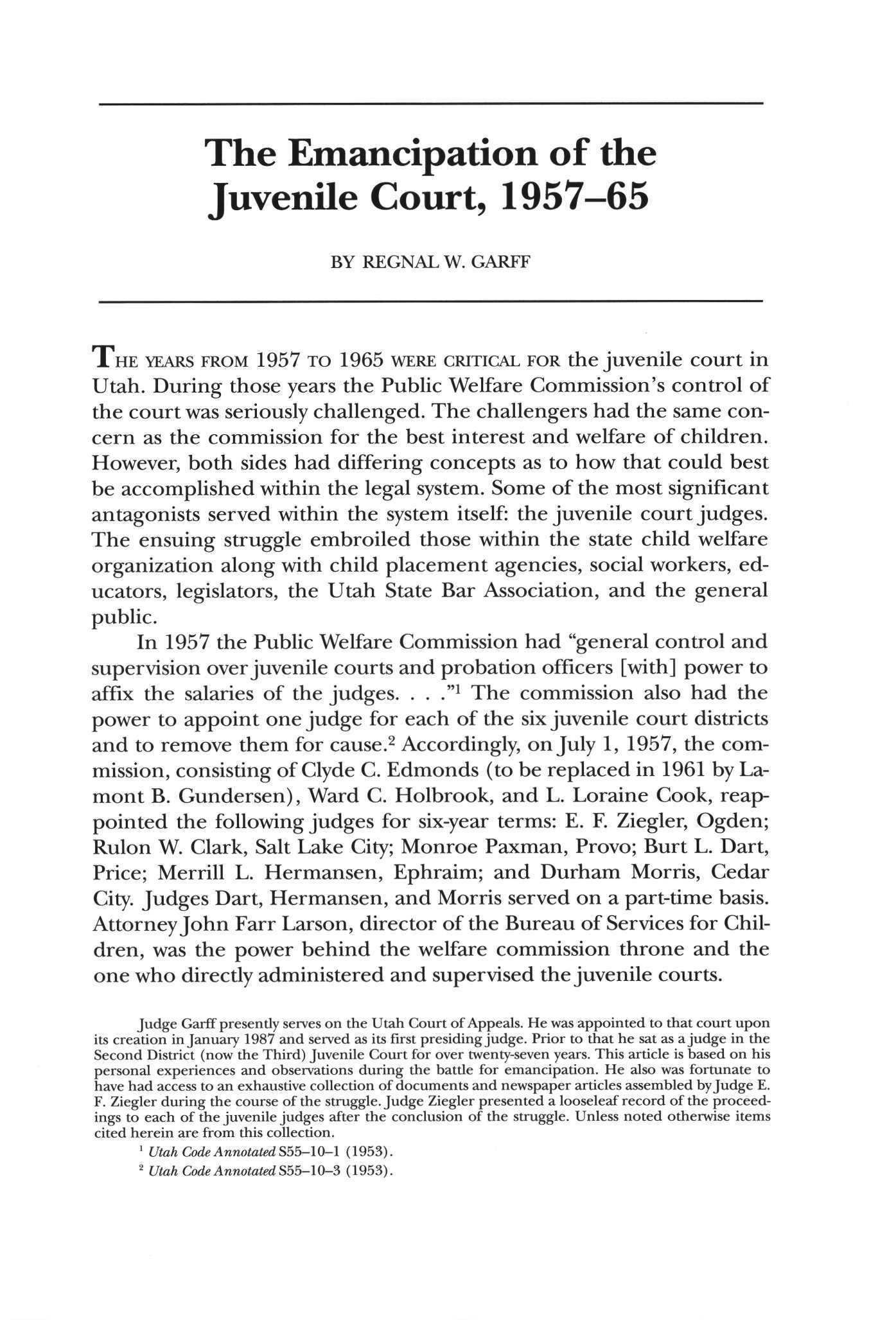
Judge Garff presently serves on the Utah Court of Appeals He was appointed to that court upon its creation in January 1987 and served as its first presiding judge Prior to that he sat as a judge in the Second District (now the Third) Juvenile Court for over twenty-seven years This article is based on his personal experiences and observations during the battle for emancipation He also was fortunate to have had access to an exhaustive collection of documents and newspaper articles assembled byJudge E F. Ziegler during the course of the struggle. Judge Ziegler presented a looseleaf record of the proceedings to each of the juvenile judges after the conclusion of the struggle Unless noted otherwise items cited herein are from this collection
1 Utah Code Annotated S55-10-1 (1953)
2 Utah Code Annotated S55-10-3 (1953)
Emboldened, perhaps by their recent appointment for six-year terms in April 1958, some of thejudges, presumably those who were full time, proposed the removal of thejuvenile courts from thejurisdiction of the commission They reasoned that the commission, part of the executive branch of state government, could not constitutionally administer thejuvenile court. They alsofelt that the commission wastoo controlling. Larson, however, believed thesejudges wanted the separation because it would likely enhance their status asjudges and increase their salaries. He chastised the activistjudges in a letter dated April 15, 1958: Status is more than salary—it comes not from money or legislation but from deeds The unfortunate thing about this particular phase of the problem is the misconception that the most important thing in the juvenile court is the salary of thejudge While this is important to give continuity to the position and security to the incumbent, it alone will not make a poor judge good, nor the lack of it make a good judge poor. 3
Larson's condescending response, apparently with commission approval, strengthened the resolve of some of thejudges to end commission control over the court. Thesejudges took particular umbrage when the commission, in its periodic administrative review, criticized their judicial performance. They felt the commission, as part of the executive branch, had neither the right nor the expertise to evaluate legal procedures and judicial performance. Thus, the drive for independence flared once again at the end of 1958. Unfortunately, thejudges lacked cohesiveness and common purpose among themselves. Many factors contributed to the judges' remaining loyal to the commission. A major one wasjob security. The judges had just been reappointed by the commission Other factors related to temperament and circumstances of the individual judge. Three were part-time judges in small rural communities, and two were older with outside interests. Judge Ziegler, a young firebrand, constantly agitated for emancipation In contrast, Judge Clark, on the bench for twenty-five years, was highly respected and had survived a variety of administrative and political changes during his tenure.4 He
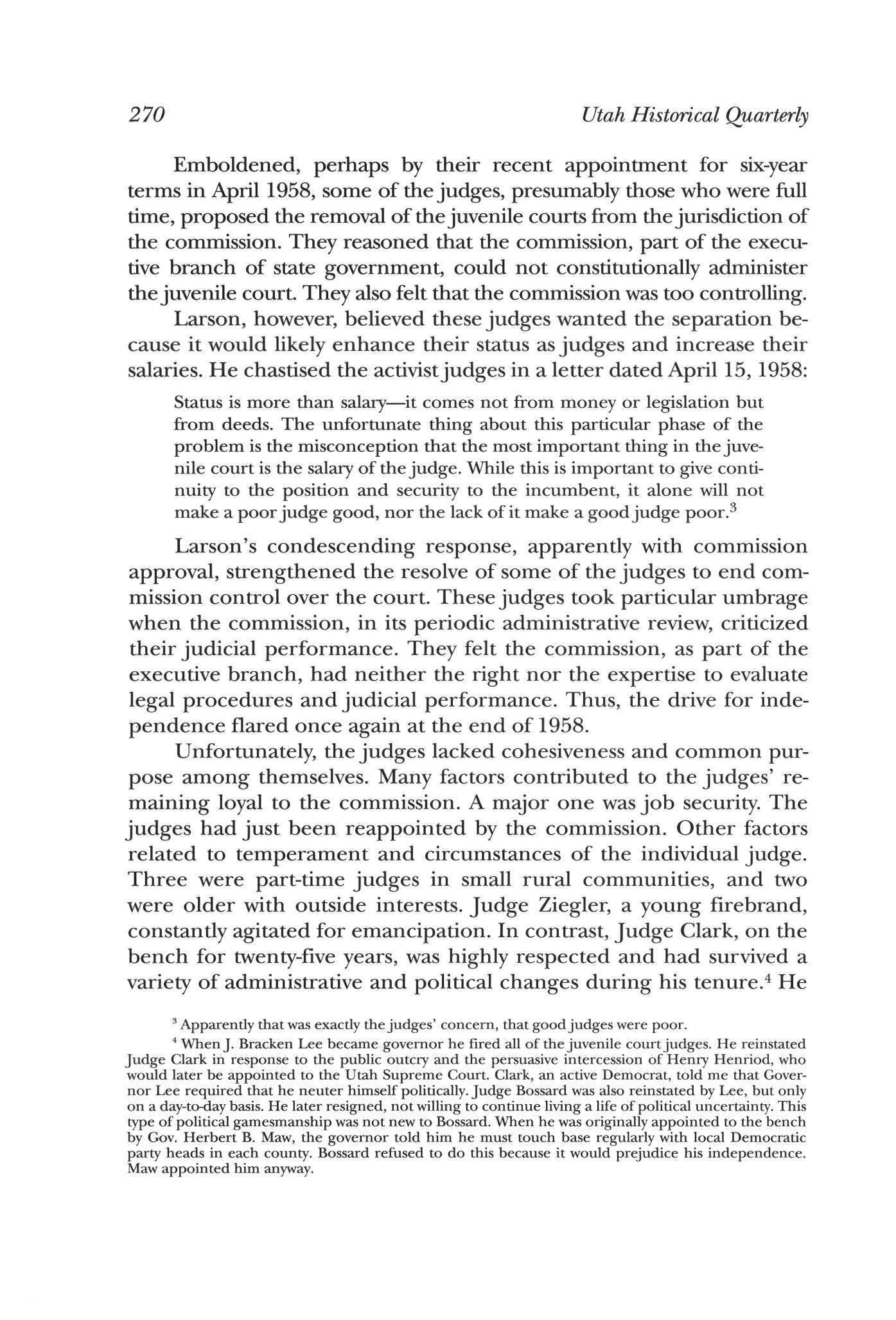
3 Apparently that was exactly the judges' concern, that good judges were poor
4 When J Bracken Lee became governor he fired all of the juvenile court judges He reinstated Judge Clark in response to the public outcry and the persuasive intercession of Henry Henriod, who would later be appointed to the Utah Supreme Court Clark, an active Democrat, told me that Governor Lee required that he neuter himself politically Judge Bossard was also reinstated by Lee, but only on a day-to-day basis. He later resigned, not willing to continue living a life of political uncertainty. This type of political gamesmanship was not new to Bossard When he was originally appointed to the bench by Gov Herbert B Maw, the governor told him he must touch base regularly with local Democratic party heads in each county. Bossard refused to do this because it would prejudice his independence. Maw appointed him anyway
270 Utah Historical Quarterly
Juvenile Court 271
had a thoughtfully deliberate temperament, considering all of the pros and cons before committing himself to a position He remained circumspect, yet supportive of the idea ofjudicial independence. No wonder there was no unanimity among the judges. And without judicial sup port no significant change could take place in the system. Nevertheless, the issues remained significant; cosmetic adjustments could notresolvedie underlying constitutional concerns posed by J o '
dering embers Ol the
controversy, fanned
by the Utah State Bar Association, burst into flame. As a result, the 1959 legislature requested the Legislative Council to study thejuvenile court system and make recommendations regarding the supervision and control of the court by the commission. The Legislative Council asked the State Bar Association to conduct the study.James E. Faust, president of the Bar at that time, and presently an apostle in the Church ofJesus Christ of Latter-day Saints, appointed a committee chaired by Brigitte Bodenheimer, professor of constitutional law at the University of Utah College of Law, now deceased. Other members included Judge Ziegler, now deceased, representing the juvenile court judges; Richard H. Moffat, a Bar commissioner and presentlyjudge in the Third District
 RetiredJuvenile CourtJudge Rulon W. Clark, left, received
scrollfrom Gov. George D. Clyde in honor of his service, Salt
Lake Tribune photograph.
RetiredJuvenile CourtJudge Rulon W. Clark, left, received
scrollfrom Gov. George D. Clyde in honor of his service, Salt
Lake Tribune photograph.
Court; and attorneys Virginia Roberts (deceased), David Watkiss, Henry Nygaard, and Bruce Coke.
Once again the salary issue became a catalyst for change Judge Clark, still dissatisfied with the inequities ofjudges' salaries, requested an increase from the $7,200 a year he was receiving, to $10,000, which would place him at parity with the district court judges. He reasoned with the commission that he deserved the increase because he was serving full time in the largest district in the state with the heaviest case load. He threatened to resign if the commission denied his request. When the commission denied his request, true to his word, at age sixty-six, Clark retired onJuly 1, 1959, after twenty-six years on the juvenile bench. 5 On August 1, 1959, the commission appointed me to fill Clark's unexpired term.
The committee began its work in earnest in mid-1960, and the Legislative Council in 1961 asked the group to continue its efforts. The committee interviewed professionals who worked with children and parents, members of the juvenile court staff, judges, attorneys, people who had been users of court services, and national authorities onjuvenile courts andjuvenilejustice The committee also conducted its own independent research. It met with Larson and members of the Welfare Commission In the fall of 1961 it received a comprehensive legal opinion from Reed L. Martineau, a member of the Bar and editor-in-chief of the Utah Law Review. The opinion drafted under the direction of the University of Utah College of Law, concluded:
The control and supervision of the Public Welfare Commission is in contravention of the fundamental principle of the separation of powers as expressed in the Utah Constitution; also that the Juvenile Court Law violates other provisions of the Utah Constitution In order to stay within the bounds of the separation of powers principle, Utah must have a juvenile court system that is truly independent of all executive departments and agencies and only accountable to a higher court.
Letters supporting this conclusion came from Dean Roscoe Pound, Harvard University Law School; Glen R. Winters, executive director, American Judicature Society; and William Sheridan, U.S Department of Health, Education, and Welfare.
Toward the end of 1961 the committee was moving in the direction of recommending an independent juvenile court with no admin-

272 Utah Historical Quarterly
5 Juvenile court judges were not included in the judicial retirement plan at that time. As a result, Clark retired at less than $200 a month
istrative ties to the Welfare Commission. Without support from the juvenile court judges themselves, however, the committee's actions would amount to an exercise in futility.
Knowing this, Judge Ziegler organized a dinner meeting with the juvenile court judges at the Heidelberg Restaurant in Farmington, Utah Four attended: Ziegler, Paxman, Hermansen, and me. The meeting served as a council of war, for as Ziegler explained it was now time for us tojoin the fray or surrender to the commission. We had to take a position. All of us were acutely aware that our terms would expireJune 30, 1963. We knew that if the committee's recommendations were not enacted into legislation, our biting the hand that feeds us could lead to that hand's withholding our reappointments. Yet, all of us, including those not in attendance at the dinner meeting, were convinced that the legal conflicts arising from this unconstitutional arrangement could not be ignored.
None of us could have anticipated the storm of controversy that would rage for the next three or four years nor the depth of personal animosity that would develop as wejoined the battle. It became a war, a civilwar over turf. Each side rationalized its position by professing to act in the best interests of children Both organizations purported to be better suited to serve the needs of children while complying with constitutional principles. On one side, Larson spoke for the Welfare Commission On the other side were the State Bar Association and the juvenile court judges. Each side attracted supporters from the

Juvenile Court 273
John Farr Larson, left, administered oath to new Juvenile CourtJudge Regnal W. Garffin August 1959. Salt Lake Tribune photograph, USHS collections.
community. The three major newspapers, the Salt Lake Tribune, the Deseret News, and the Ogden Standard-Examiner, aware of the importance of the struggle and its far-reaching implications, eagerly reported the arguments of both sides and expressed editorial opinions
The Bar committee submitted its report on July 25, 1962, with the following partial list of recommendations: (1) The governor should appoint specialized judges, drawing from candidates selected by a nominating committee. (2) The juvenile court should share the same status as the district court, while remaining independent and separate, with its own administrative structure and budget. (3) A board ofjudges should establish policies and procedures (4) The juvenile courts should be completely separated from the Welfare Commission. (5) The juvenile judges should appoint staff, including probation officers and clerks. (6) The legal rights of those using the system should be strengthened. 6
Responding to the report, the commission picked up the gauntlet, counterattacking with arguments to the Legislative Council inJuly and August of 1962. The commission's arguments against adoption of the Bar report included: (1) Judicial control of the juvenile court would result in its becoming overly legalistic, thus ignoring important concerns of treatment and rehabilitation. (2) The commission should retain responsibility for the juvenile court because the Welfare Department had responsibility for all problem children. (3) The commission never interfered with any specific case decisions because its role was strictly administrative. (4) The constitutional concerns were unfounded and "flimsy," given that no appeals raising the separation of powers issue had been brought to the Utah Supreme Court nor had there been "cries of trampled rights." (5) An outside agency needed to supervise the judges. Or as Larson put it, "The watchmen needed to be watched." Larson asked, "Who under the system proposed would seek the resignation of ajudge who performed his own physical examinations? Or who 'shamefully padded' his expense account? Or call to account a judge who had financed an automobile purchased with [public] funds?"

The juvenile court judges entered the fray with their own state-
b In light of the impending reorganization of the juvenile court, the committee had considered whether to go further and create a family court The committee saw "its present proposal as a first step toward the ultimate goal of a family court." Because it based most of its recommendations on the Model Standard Juvenile Court Act of 1959, only slight changes would be needed to transform the act into the Model Standard Family Court Act of 1959
274 Utah Historical Quarterly
ments unequivocally supporting the Bar proposals. The professional staff of the court likewise issued supporting statements.7
After all the posturing and arguments, the Legislative Council refused to adopt the Bar's recommendations. Undaunted, the Bar submitted its own legislation in 1963, H.B. 1., implementing its recommendations. The bill passed the House but failed in the Senate by one vote. The battle was lost but the war continued. 8 Now thejudges were exposed and extremely vulnerable with their terms expiring on June 30, 1963. Still, there had been no casualties.
Strategically, the commission seriously miscalculated. In a meeting with Judge Ziegler and his staff on April 25, 1963, commission chair Ward Holbrook warned that "unswerving loyalty to the Welfare Department would be expected in the future" from all thejudges He went on to say, "There will be no recriminations on past actions, but we must have loyalty in the future We want to know if ajudge is going to support our organization or still try to sever it." Turning to Ziegler he said, "and I expect an expression of loyalty from your lips before I ever cast my vote for reappointment." The demand for a loyalty oath created a firestorm of criticism for the commission. Nevertheless, the commission proceeded surreptitiously to implement the loyalty requirement. Just before the expiration of our terms at the end of June wejudges were individually called in before the commission for a loyalty interview.
During the interview the commission unveiled a complete reorganization plan for the juvenile court wherein Larson was to be appointed judge in the Second District (now the Third District). The plan further provided that Larson would be the presiding judge for the juvenile court statewide. The Welfare Department would have a separate division ofjuvenile courts. As presiding judge Larson would be directly responsible to the commission. When asked if I could work under this system I replied, "You call me in here for my reappointment
7 Earlier in 1962 the judges had formed the Council of Juvenile Court Judges in order to have greater autonomy and to provide a mechanism for organized response At this time Judge Hermansen had resigned to become an Orem City judge. Judge Dart had also resigned. Judge Paul C. Keller replaced Dart as a full-time judge, and Judge Sterling R Bossard replaced Hermansen The council elected me as its first president
8 The commission had repeatedly made the point that even though thousands and thousands of cases had come before the juvenile court not one had been appealed to the Utah Supreme Court on the issue of separation of powers What they did not realize was that in 1962 I had committed a young man to the State Industrial School After the hearing I invited his attorney, Robert C Cummings, into my chambers and suggested he appeal the case, attacking the constitutionality of the law giving the commission control over the court He agreed and the appeal was pending at the time H.B 1 failed See In Re Woodward, 384 P.2d 110 (Utah 1963).
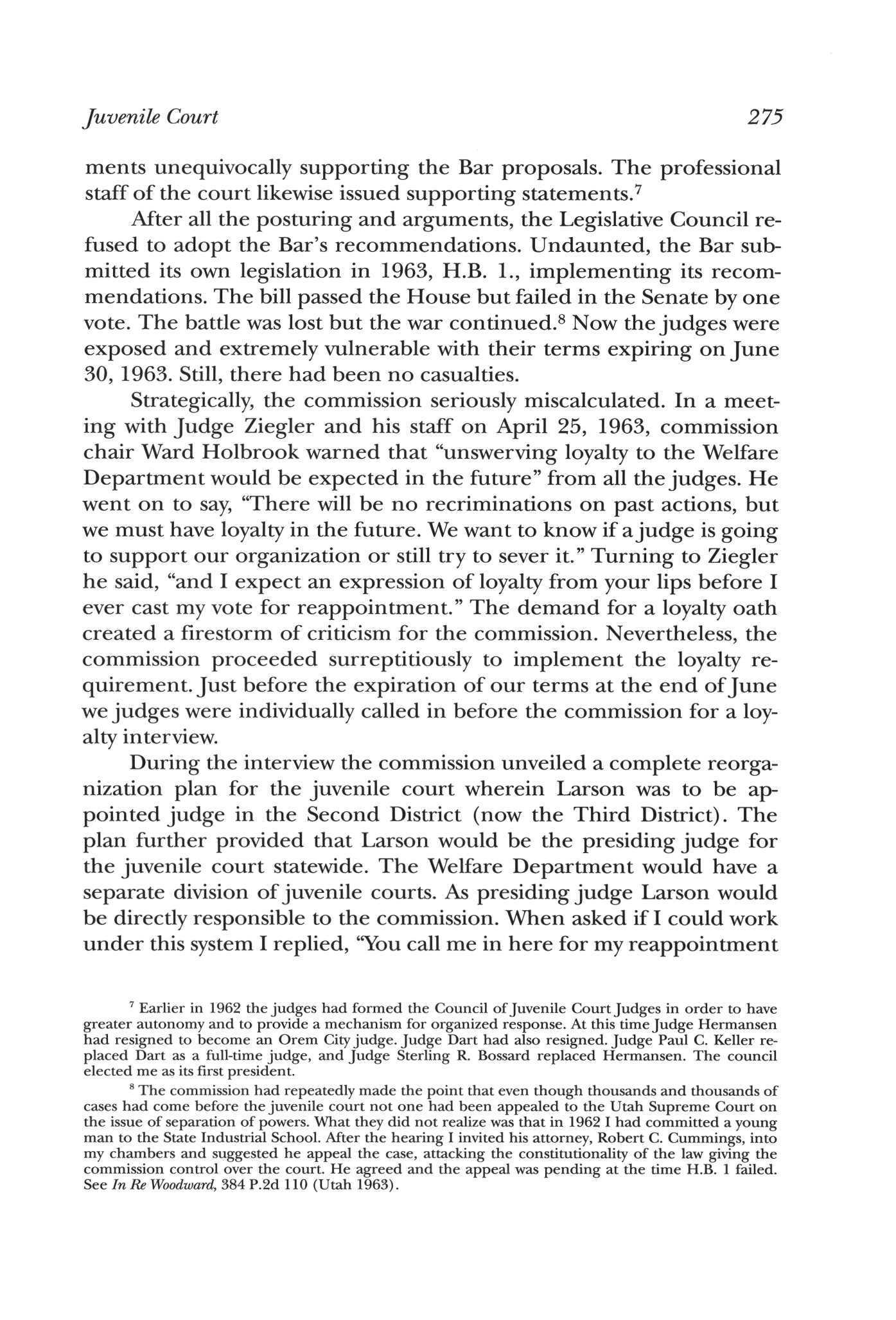
Juvenile Court 275
interview, lay out a complete reorganization plan, a plan I have never seen before nor have I had any input on it, and ask me if I can support it The implication is if my answer is 'no' I will not be reappointed. If my answer is 'yes' then I will be. Frankly, I don't know if I can live with it. However, if I find I cannot work within the system, I will resign." What I did not say was that I had no intention of resigning under any circumstances. To me, "working within the system" meant the whole system of government I hoped to work to improve the present system through whatever means available. Apparently, my answer was satisfactory because I was reappointed, as were the other judges. 9
The Bar saw the commission's plan as palliative window dressing. On July 1, 1963, committee members Richard Moffat and David Watkiss sought a writ to enjoin the commission from creating an administrative office, a second judgeship in the second district, and a presiding judgeship Meanwhile, on August 1, 1963, the Utah Supreme Court, by a three to two majority, found the statute that delegated control and supervision of the court to the commission and which granted the commission the power to remove judges for cause in violation of the Utah Constitution.10
The Utah Supreme Court opinion provided the coup de grace The mandate was now clear: There had to be legislative changes in 1965. As a result, the commission revised its reorganization plan. A Tribune editorial, dated September 10, 1963, reported:
The department voided the confusing situation of twojudges with uncertain divided authority in the Second District It also abolished the office of presiding judge, supplanting it with an Administrative Office of Juvenile Courts Judge John Farr Larson, former presiding judge, was made the "acting director" of that office—and bar spokesmen rightly say this dualjudicial-executive role is unsatisfactory

Thus the Supreme Court forced an uneasy truce between the antagonists pending legislative action. The Woodward decision seemingly ended the war and cleared the way for cooperative action to devise the best possibleJuvenile Court Act.
A fourteen-member committee was appointed by the Legislative Council onJanuary 11, 1964, with RexJ. Hanson, president of the Bar
10
276 Utah Historical Quarterly
9 Because Judge Morris did not seek reappointment, Bossard also took over his duties and became a full-time judge
In Re Woodward, 384 P.2d 110 (Utah 1963).
Association, as chair.11 Most of the original Bar committee were reappointed to this new committee. The committee eventually recommended legislation similar to H.B. 1, which included much of the Model Juvenile Court Act, with some improvements There was sporadic dispirited resistance to parts of the proposed legislation similar to that received in 1963,but most of the bill's detractors were silenced by Woodward. The Council ofJuvenile Court Judges provided strong, vocal supporters for the legislation with one exception,Judge Larson He objected that the bill threatened the balance between diagnostic and treatment functions and the jurisdictional and legal functions; that the bill placed all phases of the court in the hands of law-trained judges; and that legal rights of children should receive greater protection.12
This time, however, the Legislative Council adopted the recommendations of its committee As a result, State Senators Charles Welch and Merrill Jenkins introduced S.B. 1 in the 1965 legislature. S.B. 1 passed both houses without dissent. It created an independent juvenile court with its own administrative structure, with a Board of Juvenile Court Judges setting policy and rules of practice and procedure The bill placed the juvenile courts on the same level as district courts. It established a balance between protection of the public and protection of the rights of children and parents and it emphasized treatment and rehabilitation. Money was appropriated to provide for professional staff and mental health resources Utah's unique Juvenile Court Act was one of the most effective in the country. The war was over. After eight years, the court had finally achieved emancipation!

POSTSCRIPT
As in any battle there are heroes and heroines. It is always difficult to single out a few when so many played key roles. However, two stand out who gave total commitment to the effort: Judge E. F. Ziegler and Professor Brigitte Bodenheimer, both deceased Also, the juvenile court judges showed great courage injeopardizing their professional
11 The Salt Lake Tribune ofJanuary 1, 1964, listed the members of the committee as follows: Judge E F Ziegler, Mrs J Arthur Wood, William M Dale (chief probation officer, Second District), Marvin L. Pugh, Mrs. Brigham E. Roberts, Professor Brigitte Bodenheimer, Richard H. Moffat, Professor Milton G Thackeray, Dr Lowell L Bennion, Mrs Robert G Snow, Mrs Stanley Marcus, Mrs Howard B Summerhays, and Lamont Gundersen
12 Several years later Judge Larson acknowledged his fears had not been realized because the Juvenile Court Act was in the best interest of all concerned
Juvenile Court 277
careers as they maintained their commitment to principle. 1 3 To them the state of Utah owes a debt of deep gratitude. It must also be said that Judge Larson maintained his indefatigable commitment to children and the concept of treatment and rehabilitation
At the first meeting of the Board of Juvenile Court Judges under the 1965 act Judge Larson nominated me for the position of the court's first presiding judge. 1 4 Richard P. Lindsey was selected as the firstjuvenile court administrator. Fortunately, the worst fears of those who had resisted the change were never realized—quite the contrary. The Utah Juvenile Court was to become nationally recognized as a leader injuvenile justice, implementing the best of both worlds: protection of rights, concern for treatment and rehabilitation, and protection of the community.
15
If there is a lesson to be learned it is that change is inevitable; nothing ever remains the same. The entire court system of the state
13Judges Ziegler and Paxman were not reappointed in 1969 by Gov Calvin L Rampton Strident voices in their respective districts strongly opposed their reappointment Also, Ziegler may have contributed to his not being reappointed He fired the First District's chief probation officer three or four months before reappointments were to be made The chief probation officer was the governor's brother-in-law Later, Ziegler would return to the judiciary as an Ogden City judge and later as ajudge in the Circuit Court. Paxman returned to private life. Judge L. Roland Anderson succeeded Ziegler; Judge Merrill L. Hermansen returned to the juvenile court bench replacing Paxman.
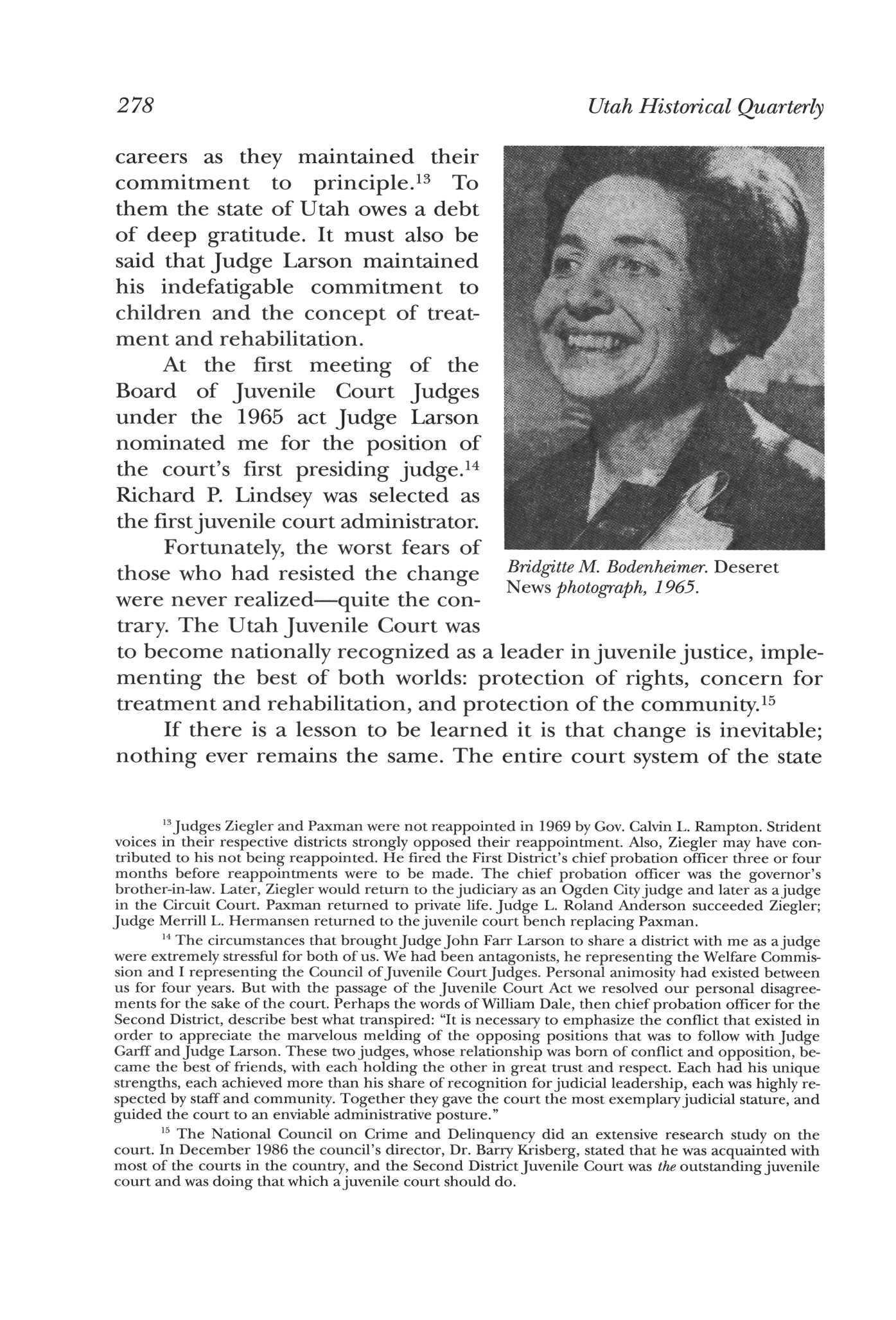
14 The circumstances that brought Judge John Farr Larson to share a district with me as ajudge were extremely stressful for both of us. We had been antagonists, he representing the Welfare Commission and I representing the Council of Juvenile Court Judges. Personal animosity had existed between us for four years. But with the passage of the Juvenile Court Act we resolved our personal disagreements for the sake of the court. Perhaps the words of William Dale, then chief probation officer for the Second District, describe best what transpired: "It is necessary to emphasize the conflict that existed in order to appreciate the marvelous melding of the opposing positions that was to follow with Judge Garff and Judge Larson These two judges, whose relationship was born of conflict and opposition, became the best of friends, with each holding the other in great trust and respect Each had his unique strengths, each achieved more than his share of recognition for judicial leadership, each was highly respected by staff and community Together they gave the court the most exemplary judicial stature, and guided the court to an enviable administrative posture."
lo The National Council on Crime and Delinquency did an extensive research study on the court In December 1986 the council's director, Dr Barry Krisberg, stated that he was acquainted with most of the courts in the country, and the Second District Juvenile Court was the outstanding juvenile court and was doing that which a juvenile court should do
278 Utah Historical Quarterly
Bridgitte M. Bodenheimer. Deseret News photograph, 1965.
has made tremendous progress in the past few years and is presently in the process of reorganizing and consolidating the courts to improve the delivery of service to the community The validity of the Juvenile Court Committee's comment that "this should be considered a first step toward the ultimate goal of a family court" remains to be seen. In the words of the Bar committee's initial report:
This is not to say that the juvenile courts should be separate courts for all time to come. The committee is aware of the general trend toward unification of courts all over the country and it believes that in time there can be one integrated court of general trialjurisdiction, perhaps with a family court division which would includejuvenile court, divorce and other domestic relations jurisdiction
It is something to consider.

Juvenile Court 279
An Affair with a Flag
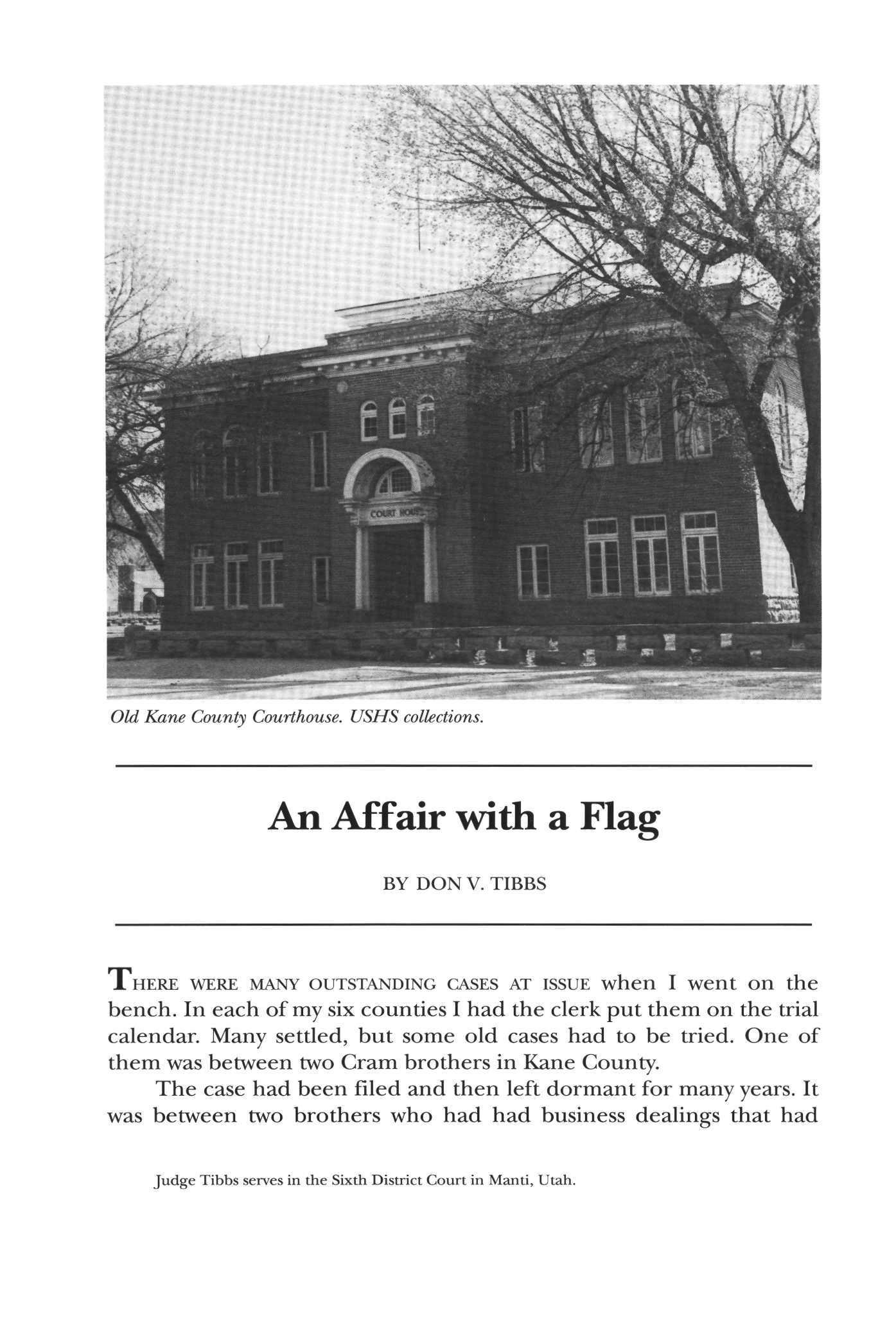 BY DON V. TIBBS
BY DON V. TIBBS
THER E WERE MANY OUTSTANDING CASES AT ISSUE when I went on the bench In each of mysixcounties I had the clerk put them on the trial calendar Many settled, but some old cases had to be tried One of them wasbetween two Cram brothers in Kane County
The case had been filed and then left dormant for many years. It was between two brothers who had had business dealings that had
Old Kane County Courthouse. USHS collections.
Judge Tibbs serves in the Sixth District Court in Manti, Utah
gone sour A sued B, and B countersued for hundreds of thousands of dollars. The complaint was amended so there were now astronomical figures involved. Both parties, though still angry, had let the case sit without action. When it finally came up for trial each brother was represented by competent counsel, one a prominent Salt Lake woman lawyer and the other a local young whiz. Each side was out for blood.

The setting was the old Kane County Courthouse that had been constructed many years ago. The courtroom, up a long flight of wooden stairs, occupied nearly the entire top floor The frames of the windows had weathered until there were cracks you could see through on all four sides of the frames. This was okay because there was no air conditioning and the breezes were welcome in the courtroom, especially in the summer when the temperature would rise to well over one hundred degrees. The courtroom still had wooden floors, wooden benches for the audience, and a square box for the judge, about the size of the desk in my office. A United States flag and a state of Utah flag stood behind the judge's chair. Counsel tables and chairs looked beat up and had been there since the
beginning They were definitely rickety and on their last legs
We started the case early at 8 A.M. because of the expected summer heat.Just before convening, the sheriff's bailiff notified me that about thirty German tourists who had been out on Lake Powell for a vacation wanted to watch the proceeding while they took a day's rest He asked if they could sit in the courtroom in shorts and vacation attire. I agreed it was all right.
The case had been going only about a hour, with the two brothers at each other's throat, when I began to realize that the case was baloney and I should throw it out. Then I thought that maybe if I required conferences I could get the brothers to at least talk to each other and hopefully resolve their differences. After each conference and recess the case seemed to get worse The Germans were enthralled with what appeared to be American West disputes and alleged justice.
An Affair with a Flag 281
Judge Don V. Tibbs. Courtesy of Ida O. Donaldson.
The case continued and the disputes became louder and more discouraging. Finally, all the evidence was in. I knew what my decision would be after the attorneys completed their arguments. I was going to dismiss each side's claims, each side to bear its own costs.
In final arguments both attorneys became wound up and performed for their clients' benefit. The lady lawyer, in making her final point, pounded her fist down on counsel table. Its legs came apart and the long table, with its books and papers, in slow motion collapsed, and all slid to the floor. Counsel, to say the least, was upset. We took a recess to gather the books up and to get our bearings. The custodian repaired the table with a hammer and nails. Counsel later met with the county commissioners and was instrumental in getting new furniture, carpet, and a remodeled bench
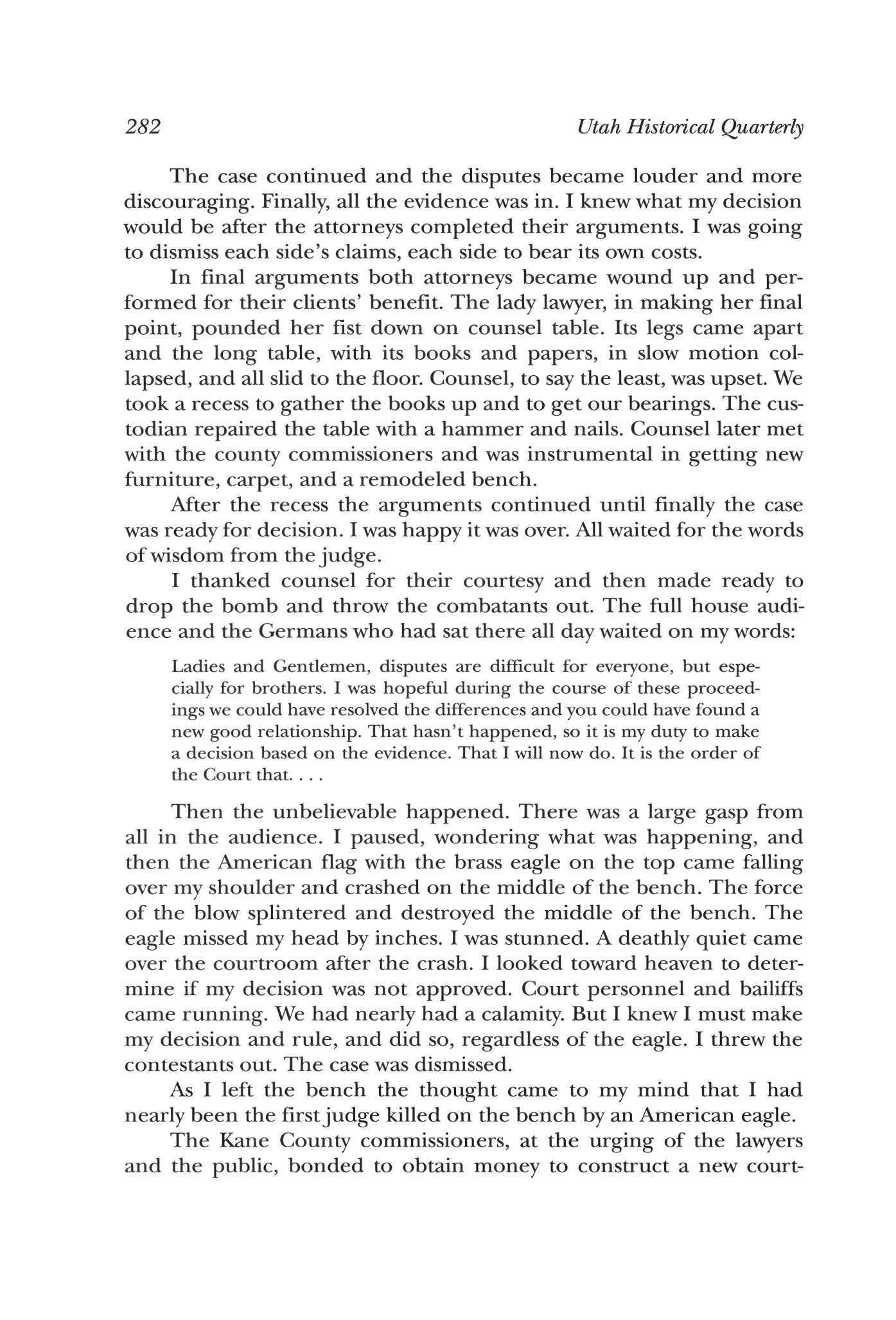
After the recess the arguments continued until finally the case was ready for decision. Iwas happy itwas over. Allwaited for the words of wisdom from the judge.
I thanked counsel for their courtesy and then made ready to drop the bomb and throw the combatants out The full house audience and the Germans who had sat there all day waited on my words:
Ladies and Gentlemen, disputes are difficult for everyone, but especially for brothers. I was hopeful during the course of these proceedings we could have resolved the differences and you could have found a new good relationship That hasn't happened, so it is my duty to make a decision based on the evidence. That I will now do. It is the order of the Court that
Then the unbelievable happened. There was a large gasp from all in the audience. I paused, wondering what was happening, and then the American flag with the brass eagle on the top came falling over my shoulder and crashed on the middle of the bench The force of the blow splintered and destroyed the middle of the bench The eagle missed my head by inches I was stunned A deathly quiet came over the courtroom after the crash I looked toward heaven to determine if my decision was not approved Court personnel and bailiffs came running We had nearly had a calamity But I knew I must make my decision and rule, and did so, regardless of the eagle I threw the contestants out The case was dismissed
As I left the bench the thought came to my mind that I had nearly been the firstjudge killed on the bench by an American eagle. The Kane County commissioners, at the urging of the lawyers and the public, bonded to obtain money to construct a new court-
282 Utah Historical Quarterly
An Affair with a Flag 283
house with a beautiful courtroom. We now have an impressive bench and air conditioning. There is plush carpet on the floor and the attorneys and audience sit on upholstered chairs The attorney tables are made of beautiful polished wood that is always kept dusted. A beautiful American flag is posted in the courtroom, and we still hear dramatic cases. The bailiff still causes the audience to stand when the judge enters the room, and we still have tourists that come to observe. However, as I sit on the bench in my black robes, my mind often remembers that case Cram v. Cram. The brothers are now deceased and the attorneys are gone, probably retired. The eagle looks down at me and smiles. He knows how I nearly became the firstjudge killed by an American eagle while sitting on the bench Oh, the power of a gust of wind coming through windows on a hot summer afternoon.

In July 1921 twenty-four-year-old Elwyn BlakeJr took a root beer break from his printing job at the San Juan Record in Monticello, Utah At a local drugstore he ran into a friend, the fifty-two-year-old miner Bert Loper The older man was heading to Bluff where he was to be the head boatman for a USGS survey of the San Juan River. The crew needed one more rodman, and Loper's subsequent recommendation with chief engineer Kelly Trimble landed the job for Blake. This serendipitous beginning led to three eventful and exciting summers with the USGS for young Blake as he became an accomplished boatman, participating in some historic and far-reaching surveys of the Colorado River Basin
Author Richard Westwood, Blake's nephew, has reconstructed those three trips—the San Juan in 1921, the upper Green in 1922, and the Grand Canyon in 1923—using Blake's and other participants' field notes, Blake's autobiography, and other primary and secondary sources (In a short chapter he also summarizes the 1921 Chenoweth survey of Cataract Canyon)

Westwood's account thoroughly recreates those trips, detailing the survey work accomplished, the problems each trip encountered and the day-today social dynamics. In doing so he
actually tells two stories While he focuses on Blake and his contributions to the surveys, he also is narrating the story of the USGS's efforts to map "the last deep canyons of the Colorado River system and to find possible dam sites." No one before Westwood has told us so much about these important surveys whose work has had so much impact on the Colorado River system
Besides the well-known Loper, other important figures from Colorado River history who walk in and out of this story are Hugh D Miser, Kelly Trimble, Claude Birdseye, Raymond Moore, Eugene C LaRue, Emery and Ellsworth Kolb, Lewis Freeman, and Frank Dodge Some like Emery Kolb added to their fame with these trips; some went on to greater work; some became famous just for these trips. Blake himself never did much more river work after 1923. The pressures of supporting a young family forced him to seek steadier employment in the newspaper printing business. Yet clearly those three summers were the formative adventures of his life, as he spent much time later writing about them in an autobiography and in poems he composed
Westwood does an excellent job of conveying just what it was like to head down the river in the early 1920s His
Rough-water Man: Elwyn Blake's Colorado River Expeditions. By RICHARD E WESTWOOD (Reno: University of Nevada Press, 1922 xxii + 259 pp $27.95.)
details often contain some real gems, like the account of the BirdseyeEmery Kolb argument over filming the trip through the Grand Canyon Occasionally, though, the details get a bit repetitive. Also, Westwood sometimes narrates very specific information about Blake's private thoughts and impressions without citing the source This can be confusing
Nevertheless, this is a valuable contribution to Colorado River history. River runners, western water historians and those with a general interest in the Colorado River will find this a good, often exciting read.
JIM ATON Southern Utah University
Beneath These Red Cliffs: An Ethnohistory of the Utah Paiutes. By RONALD L. HOLT (Albuquerque: University of New Mexico Press, 1992. xvi + 197 pp. $29.95.)
Beneath These Red Cliffs is a history of the Southern Paiute Indians of Utah. It is a book about the century and a half of suffering endured by a proud people at the hands of Europeans who immigrated into Paiute country, usurped traditional Paiute lands, forever disrupted their lives, and denied them their most fundamental right, self-determination The book was written by someone who knows the twentieth-century Paiutes: Ronald Holt taught at Southern Utah University in Cedar City for several years and worked closely with the Paiutes as he formulated his ideas for this book
The Paiutes are a people with a poorly known history At the time of European arrival they lived in southern Utah, southern Nevada, and northwestern Arizona. Chapter 1 sketches the contact period lives of Utah Paiutes and attempts some definition of traditional homelands utilizing the available ethnographic literature. Early, often ethnocentric, descriptions of the Paiutes typically characterized their traditional lives as struggles for existence in what was perceived as a barren landscape
Chapters 2 through 6 document the Paiutes' struggle for survival in a very different landscape—one filled
with amorphous government agencies, changing political climates and laws, extreme paternalism, ideological agendas, and Western European economics Holt's first four chapter headings: "Occupation and Dependency," "From Neglect to Lethargy: The Trust Betrayed," "The Agony of Termination," "The Forgotten Tribe," which take the reader from the 1850s up to the 1970s, reflect the numerous difficulties endured by the Paiutes over more than a century of Indian-white interaction
Chapters 5 and 6 are more positive as they narrate die successful, although incredibly drawn out, process of restoration from the 1960s into the 1980s, culminating in the securing of limited reservation lands. As Holt points out, restoration provided the Paiutes with some semblance of dignity and increased opportunity; however, their struggle for self-reliance continues as unemployment and economic insecurities still plague tribal members. Hope, in the form of greater political visibility and intercultural understanding (to which uiis book contributes), hovers on die horizon for Paiutes as this difficult century ends.
Minor criticisms can be made of the characterizations of Paiute homelands

Book Reviews and Notices 285
and lifeways in chapters 1 and 2 which are a bit glib in their treatment For example, the failure to mention the importance of Panguitch Lake struck me as an important oversight given the key role it played for die Panguitch band (Kelly 1964)—a role comparable to that of Fish Lake, which is mentioned several times by Holt as playing an important economic role for the Paiutes during the historic period. Fish Lake, however, is considered by most (Steward 1938, Stewart 1942, Kelly 1964) to have been in Ute country at the time of contact I also wondered why Holt never referred to the Pahvant as Utes The vagaries and dynamic nature of cultural boundaries during the historic period make these issues difficult to deal with, however, and do not detract from the primary contribution of the book. On the other hand, I agree completely with Holt's resistance to Stoffle and Dobyns's (1982) suggestion that the precontact Southern Paiutes had developed a political system that included "theocratic chiefs" (Stoffle and Dobyns 1982:47, cited in Holt 1992:12)

In general, the book is well written and well researched. A few instances of what might be called oblique logic exist in chapter 2 wherein Holt discusses "Mormon Prejudice and Neglect" (lack of tolerance, paternalism, failure to develop organized efforts) and illustrates these with examples that seem somewhat off the mark Again, these are minor distractions in what is otherwise an absorbing work
Professor Holt has made an important contribution to the literature on Utah's diverse cultural legacy with this text As noted at the onset, he writes from personal experience and with exceptional sensitivity The issues raised (prejudice, paternalism, neglect, among others) are complex and elusive, as are their long-term consequences on a people who have had few opportunities to wield political power. Scholars interested in the histories of ethnic peoples can find much to build on here.
JOE L CJANETSKI Brigham Young University
Solemn Covenant: The Mormon Polygamous Passage is a fascinating culmination of decades of intensive research and thought by B. Carmon Hardy. Given his earlier work, it is no surprise that this book is the most comprehensive and insightful look at post-Manifesto plural marriage yet to be published, but it is more than that Solemn Covenant closely examines and provides fresh information and new insights into the practice of plural marriage throughout the nineteenth cen-
tury and into the twentieth and should quickly be recognized as the standard not only for the difficult, troubled official end of polygamy but as one of the standards for understanding the practice throughout its history.
The book is generally organized chronologically. The first chapters summarize the beginnings of plural marriage and present support for a continuing theme in the book—that polygamy was of central importance
286 Utah Historical Quarterly
Solemn Covenant: The Mormon Polygamous Passage. By B. CARMON HARDY. (Urbana: University of Illinois Press, 1992 xxiv + 445 pp $34.95.)
in the nineteenth-century church. With the move west the practice "acquired momentum," but pressure to control the "twin relic of barbarism" and the church that sanctioned the practice grew significantly as well Hardy draws intriguing parallels between the treatment of the South following the Civil War and of polygamous Utah He adds his voice to the running debate among historians of nineteenth-century Mormonism on the question of whether Mormon polygamy or political hegemony contributed more to the persistent efforts of federal officials and others to impose control over Utah. Hardy cogently concludes that it is difficult to separate the two—that the public objection was "polygamic theocracy," but he clearly believes that plural marriage was the more important cause
A captivating chapter discusses the various curses, medical and otherwise, attributed to polygamous households by opponents and the blessings attributed by Latter-day Saints to the "Abrahamic household." Interestingly, Hardy finds that Mormons and non-Mormons did not necessarily have differing views of such wonderfully Victorian concepts as "spermatic depletion" and its supposed ill effects Under Hardy's analysis Mormon leaders such as George Q. Cannon seem as much a part of their time as, for example, Sylvester Graham, father of the graham cracker and cracker-barrel theories about the debilitating effects of sapping such "life-giving fluids" as semen.

Although Hardy's chapters on the beginnings, early strifes, and medical interpretations of polygamy make for fascinating reading, the grist of Solemn Covenant is in the chapters leading up to and following 1890. He makes a convincing case that Mormon leaders, either wittingly or not, began the
transition to the abandonment of polygamy in the 1880s as they began distinguishing between "celestial" and plural marriage His description of the issuance and difficulties surrounding the Manifesto is noteworthy for its grasp of the issues and its documentation of the troubles the matter created. Taking issue with some other historians, Hardy asserts that the Manifesto must be viewed in the context of intense millennial fervor, which he traces from the crusade against polygamy through Lorenzo Snow's presidency. In this light the Manifesto was simply a means of "buying time," and the sub rosa practice of polygamy that continued through the next years with the sanction of church leaders was simply an attempt to preserve the practice for the contemplated short period of time before the second coming of Christ
Enlarging on his and Victor Jorgensen's earlier study published in the Utah Historical Quarterly in 1980, Hardy traces the difficult period of transition as church leaders, who often had differing views of the continuation of polygamy, brought the church into the twentieth century He focuses on the views and actions of Wilford Woodruff, Lorenzo Snow, and Joseph F. Smith with respect to continued polygamy as they successively presided over the Mormon church during this period of transition. He chronicles the secrecy and deception employed by certain church leaders, even with other leaders
The continuation of polygamy in Canada and Mexico are described at length, as are the involvement of church leaders in the continued practice in both these foreign lands, on vessels off the coast of the country, and in the United States A lengthy and thoroughly researched appendix lists in substantial detail the marriages of 220 post-Manifesto polygamists.
Book Reviews and Notices 287
Professor Hardy also treats at length the Smoot hearings and the effects they had on church leaders' opinions of continued polygamy. The views of the Quorum of Twelve Apostles changed as new members were appointed in others' places through death or resignation and as older members, polygamists themselves, sought to rid the church of new polygamy Hardy makes a strong, though entirely circumstantial, case for the proposition that Joseph F Smith secretly continued to authorize a carefully chosen few to continue the practice of plural marriage well beyond the time of his 1904 "Second Manifesto."
The closing essay in Solemn Covenant addresses the intricacies and implications of "lying for the Lord." He discusses openly, although quite sympathetically, the questions raised by church leaders' and members' ability to lie to the world and even to each
other as they attempted to preserve the principle of plural marriage
Hardy's work is well written and at times even brilliant I was required to resort to my dictionary at times and to diagram a few complex sentences to understand them, but his use of language only occasionally got in the way He sometimes provides more than ample support for a point; other times he places too much reliance on questionable sources. One is left with little doubt that Hardy feels comfortable addressing controversial issues and discussing them without trepidation; indeed, editorial commentary is provided perhaps too much. These slight failings notwithstanding, Solemn Covenant should rightfully take its place as a work that any student of nineteenth-century Mormonism and polygamy must read and study carefully
Prisoner for Polygamy: The Memoirs and Letters of Rudger Clawson at the Utah Territorial Penitentiary, 1884-87. Edited by STAN LARSON (Urbana: University of Illinois Press, 1993 xii + 256 pp $29.95.)
Clawson's memoirs have been available (in several forms and readings) for decades to serious scholars and to casual readers alike. Why now prepare and publish what amounts to a critical edition? Until now Clawson's "Memoir," its genesis, its several revisions, and its autobiographical and historical relevance have not been united into a single bound source Larson has now accomplished that task, and the result is a highly readable and technically elegant volume And it's fun to read, too Larson's exhaustive research draws freely from published and manuscript sources; he makes use of previously

unavailable diaries and letters. He treats his prime document respectfully and his supportive materials with discretion and respect. His introductory essay is masterful Indeed, the approach taken in the essay and the straightforward, explicatory style in which it is written reassure the reader and lend gravity to Larson's conclusions
This volume has much to recommend it: It is neither faith promoting nor politically correct. Best of all, Larson does not deify his subject. These absences elevate the work beyond much recent biographical writing in Utah.
288 Utah Historical Quarterly
KENNETH L CANNON II Salt Lake City
A few mechanical problems mar the book's presentation, e.g., four endnotes were dropped from the introductory essay; in a couple of instances emendations appear to have been edited too severely But these matters are more irritating than serious.
Larson's volume commends itself
to novice and veteran historians, to lay and professional readers. One hopes it will enjoy the wide readership it deserves.
WILLIAM C SEIFRIT
Ute Tales. Collected by ANNE M. SMITH, assisted by ALDEN HAYES (Salt Lake City: University of Utah Press, 1992 xxx + 175 pp $24.95.)
In 1936 and 1937 Yale University graduate student Anne Smith traveled to the Uintah and Ouray Reservation in northeastern Utah to collect ethnographic information on Northern Ute culture. Of particular concern to her was recording myths and other tales. Smith collected several hundred tales through interviews with her Ute hosts—some told in English but many told in the Ute language and translated for her. These tales formed the data base for Smith's dissertation, entitled "An Analysis of Basin Mythology," which compared and contrasted Ute myths to those of other cultural groups in other culture areas. The Northern Ute tales compiled by Smith were presented in her 1939 dissertation but have not been published until now Students of Ute culture and Native American mythology at last have easy access to 102 tales, representing the three bands (Uinta, Uncompahgre, and White River) comprising the Northern Ute
A lengthy foreword to Ute Tales by Joseph G Jorgensen provides a valuable introduction to the work It includes a brief biographical sketch of Smith that will be welcomed by those scholars who have relied upon her previously published Ethnology of the Northern Utes. The short discussion of anthropological theory will also be of

interest to those working in that field. The foreword also discusses the rather bleak social and political situation on the reservation in the 1930s and the sorry state of white/Native American relations, which underscores Smith's achievement in gaining the trust of her Ute informants.
The tales follow, organized by band, without further introduction or comment. Historic photographs of Northern Utes, some of whom worked with Smith, are interspersed Most of the tales are brief and rely on plot and action rather than characterization or imagery. Description of a single event may comprise one tale; another tale may incorporate the same tale and others to constitute a composite tale Many are violent, some are humorous, and some contain scatological or sexual references. A few are "just-so" stories, explaining why things are the way they are, and few contain clearly stated, moral instructions The tales appear to have been told more for entertainment than for instilling certain cultural behaviors. Traditional animal characters, such as Coyote, Porcupine, and Bear, who also possess human characteristics, predominate
Ute Tales is both entertaining and educational It presents an oral storytelling tradition rather unlike that of the Euro-American tradition and
Book Reviews and Notices 289
Salt Lake City
provides insight into a substantially different culture. Some readers may wish to refer to Anne Smith's Ethnography of the Northern Utes for her short analysis of Northern Ute tales Although this earlier work does not present tales, it summarizes some of the key findings of her doctoral disserta-
tion, and delves into the subject a little deeper than does Jorgensen in the foreword to Ute Tales. The publication of Ute Tales has filled an obvious void in Ute ethnographic literature
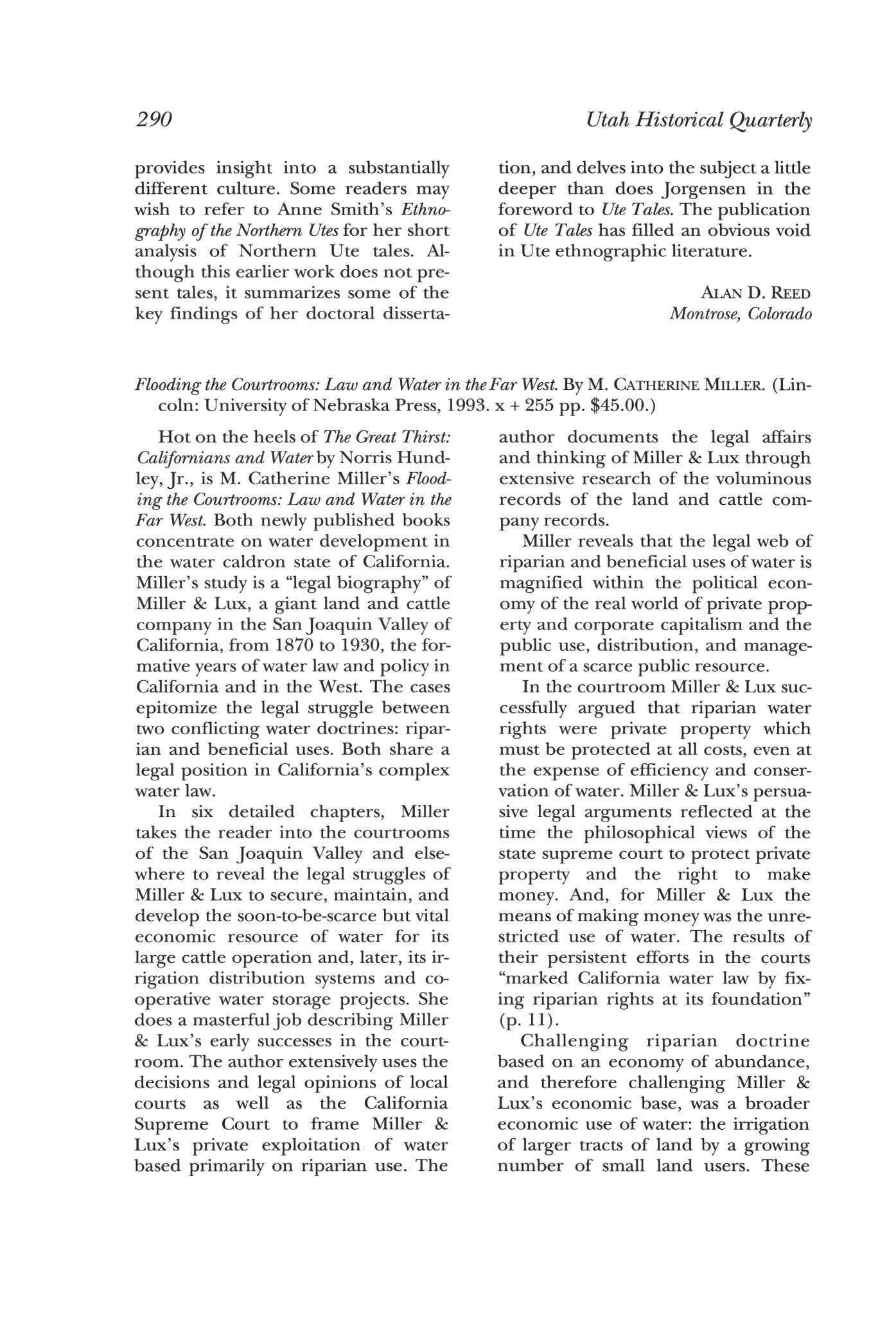 ALAN D. REED Montrose, Colorado
ALAN D. REED Montrose, Colorado
Flooding the Courtrooms: Law and Water in theFar West. By M CATHERINE MILLER (Lincoln: University of Nebraska Press, 1993 x + 255 pp $45.00.)
Hot on the heels of The Great Thirst: Californians and Water by Norris Hundley,Jr., is M. Catherine Miller's Flooding the Courtrooms: Law and Water in the Far West. Both newly published books concentrate on water development in the water caldron state of California Miller's study is a "legal biography" of Miller & Lux, a giant land and cattle company in the San Joaquin Valley of California, from 1870 to 1930, the formative years of water law and policy in California and in the West. The cases epitomize the legal struggle between two conflicting water doctrines: riparian and beneficial uses Both share a legal position in California's complex water law.
In six detailed chapters, Miller takes the reader into the courtrooms of the San Joaquin Valley and elsewhere to reveal the legal struggles of Miller 8c Lux to secure, maintain, and develop the soon-to-be-scarce but vital economic resource of water for its large cattle operation and, later, its irrigation distribution systems and cooperative water storage projects. She does a masterful job describing Miller 8c Lux's early successes in the courtroom. The author extensively uses the decisions and legal opinions of local courts as well as the California Supreme Court to frame Miller 8c Lux's private exploitation of water based primarily on riparian use The
author documents the legal affairs and thinking of Miller 8c Lux through extensive research of the voluminous records of the land and cattle company records
Miller reveals that the legal web of riparian and beneficial uses of water is magnified within the political economy of the real world of private property and corporate capitalism and the public use, distribution, and management of a scarce public resource
In the courtroom Miller 8c Lux successfully argued that riparian water rights were private property which must be protected at all costs, even at the expense of efficiency and conservation of water Miller 8c Lux's persuasive legal arguments reflected at the time the philosophical views of the state supreme court to protect private property and the right to make money. And, for Miller 8c Lux the means of making money was the unrestricted use of water The results of their persistent efforts in the courts "marked California water law by fixing riparian rights at its foundation" (p 11)
Challenging riparian doctrine based on an economy of abundance, and therefore challenging Miller & Lux's economic base, was a broader economic use of water: the irrigation of larger tracts of land by a growing number of small land users. These
290 Utah Historical Quarterly
new agricultural water users were consumptive, reducing the availability of water to riparian users and others. To add political, economic, and legal muscle to these smaller beneficial users, the California State Legislature passed the Wright bill in 1887 which permitted groups of water users to form irrigation and water districts These districts enabled individual water users to unite politically and economically to fund, build, control, and manage huge water deliver systems which by legal definition are public utilities.
Urban public electric companies such as Southern California Edison also demanded a use of the water for hydroelectric generation Irrigators and public electric companies alike legally fought for the doctrine of beneficial use which "took on a more democratic cast, allowing new entrepreneurs and small landowners to irrigate and retain claims of water" (p 93) The results were lengthy and costly legal cases for Miller 8c Lux The outcome of these new legal challenges to riparian use was the broader use of water vital to a growing economy, based on the reality of an increasing scarcity of water.
Miller points out that these legal, philosophical, and economic conflicts over the use and value of water intensified in California during the Progressive Era. Miller 8c Lux faced a national concern which in part called
for reform and careful management of scarce natural resources in the West The mismanagement of Miller & Lux following World War I and its failure to understand the direction of water policy added to the company's legal and financial problems. The Great Depression figured in the company's decline as well.
California legislators in the 1930s viewed water as the economic panacea for the depressed economy of the San Joaquin Valley. The passage of the Central Valley Project Act was yet another legal and economic challenge that Miller & Lux could not match The proposed water project was even bigger than California could afford The federal government and its Bureau of Reclamation were called upon to rescue the project in 1935
Flooding the Courtrooms is more than the legal wars of a huge land and cattle company. It is an excellent study of the philosophical and economic ramifications of a scarce resource, a resource that must be carefully managed legally and economically if California and the West are to survive and prosper. Flooding the Courtrooms is an important study for anyone interested in the legal developments of conflicting philosophies of riparian and beneficial uses of the scarce water resource found in the arid West
CRAIG FULLER Utah State Historical Society
The Proper Edge of the Sky: The High Plateau Country of Utah. By EDWARD A GEARY (Salt Lake City: University of Utah Press, 1992. 282 pp. Paper, $14.95.)

Edward Geary's book is a delightful look into the geography, the people, and even the literature of the Colorado Plateau region Though not a
definitive study of anyone of these topics, it is a vivid montage that touches all of them The author knows firsthand his "Proper Edge of the Sky,"
Book Reviews and Notices 291
seen from Huntington, Utah, by him when looking west toward the mountains of Manti-LaSal National Forest.
In his preface, Dr Geary states: "The pages that follow are neither guidebook, nor travel narrative, nor natural history, nor social history, nor literary history, nor personal essay, though they incorporate elements from all these genres They represent an effort to see and know a richly varied land through my own experience and the overlaid impressions of others who have dwelt in or visited or written of the High Plateau region." (p. 3)

The author uses numerous historic documents, including the reports of Clarence Dutton, John Wesley Powell, John C. Fremont, and other official government explorers He taps the memoirs and writing about Mormon settlers, quoting Elizabeth Wood Kane, Henry W Bigler, Solomon Carvalho, and scores more His scholarship reaches the likes of Wallace Stegner, Dale Morgan, Juanita Brooks, LeRoy Hafen, and current historians of the area: Kent Powell, Phil Notarianni, and Helen Papanikolas. From them he gleans a wealth of information and stories.
His "tour" for readers proceeds along historic trails and current highways, through mountain passes, and down streams into the valley. He describes the area's high mountain plateaus, its inner valleys and colorful canyons, its desert regions, and volcanic intrusions, which create the isolated settings for the "oases" and "worlds" where the people lived.
Much of Geary's writing is anecdotal. He regularly introduces a chapter's theme with a familiar saying or story Examples include such phrases as "Stop and Tell Me Red Man," "Streams Ever Copious," "For the Strength of the Hills," and "The Mormon Corridor." His "A Strange and
Beautiful Country" chapter begins with the story of a backhoe operator uncovering bones of a prehistoric mammoth, from which the author then discusses the landforms, flora and fauna "Back Houses of Escalante" alludes to that community's historic resources, and "A Woman and Some Cows" is more than merely Emma Lee at Lee's Ferry on the Colorado River.
"A Wife from Sanpete" humorously depicts the trials of those devout settlers—Scandinavians and English. Why marry a wife from Sanpete? Because no matter how difficult conditions might get, she had already seen it worse. His book also discusses settlements, Indian-Mormon problems and practices (less than enlightened at times), ranching (sheep and cattle), the Forest Service, education, and Coops They are all there
Chapter eleven discusses "The Camps," not cow or sheep camps but the coal camps, wherein the author contrasts their coal-based economy with the Mormon agrarian economy, and tells about the ethnically diverse peoples of Carbon County. It was a different world (almost), with coal mines, coal miners, labor leaders, and labor problems Here the Greeks, Italians, Slavic peoples, Finns, and other minorities settled, labored, and left their imprints on the region Here also were the Winter Quarters/Scofield and Castle Gate mine disasters.
The author knows the High Plateau Country of Utah thoroughly. Readers of his book are advised to have a current Utah road map in hand while reading it. The book is a delightful tour de force, as informative as it is fun to read
292 Utah Historical Quarterly
MELVIN T. SMITH Mount Pleasant
Mormon Odyssey: The Story of Ida Hunt Udall, Plural Wife. Edited by MARIA S
ELLSWORTH
(Urbana: University of Illinois Press, 1992 xiv + 296 pp $29.95)
Maria S Ellsworth has chosen an interesting method to present Ida Hunt Udall's story She starts with Ida's memories of her childhood, then turns to a "birthday book." Ida recorded the events of her birthday each year from age 14 to 48. Ellsworth next selects entries from Ida's journal of her marriage and the hardships she endured while hiding from government officials who wanted her to testify against her polygamist husband, David K. Udall. The last of the book is a reflection of those who knew and loved Ida
Traveling to Arizona in company with Jesse N. Smith and his two wives, Emma and Augusta, Ida Hunt Udall wrote that she became aware of "a distinct spiritual quality" in the relationship of the wives and an "unselfish devotion between these wives." Imbued with a Don Quixote idealism regarding polygamy, Ida determined to cancel her engagement and enter the polygamist order Her journal entries depict the reality of the life she chose and a yearning for that ideal unity of family she felt was possible
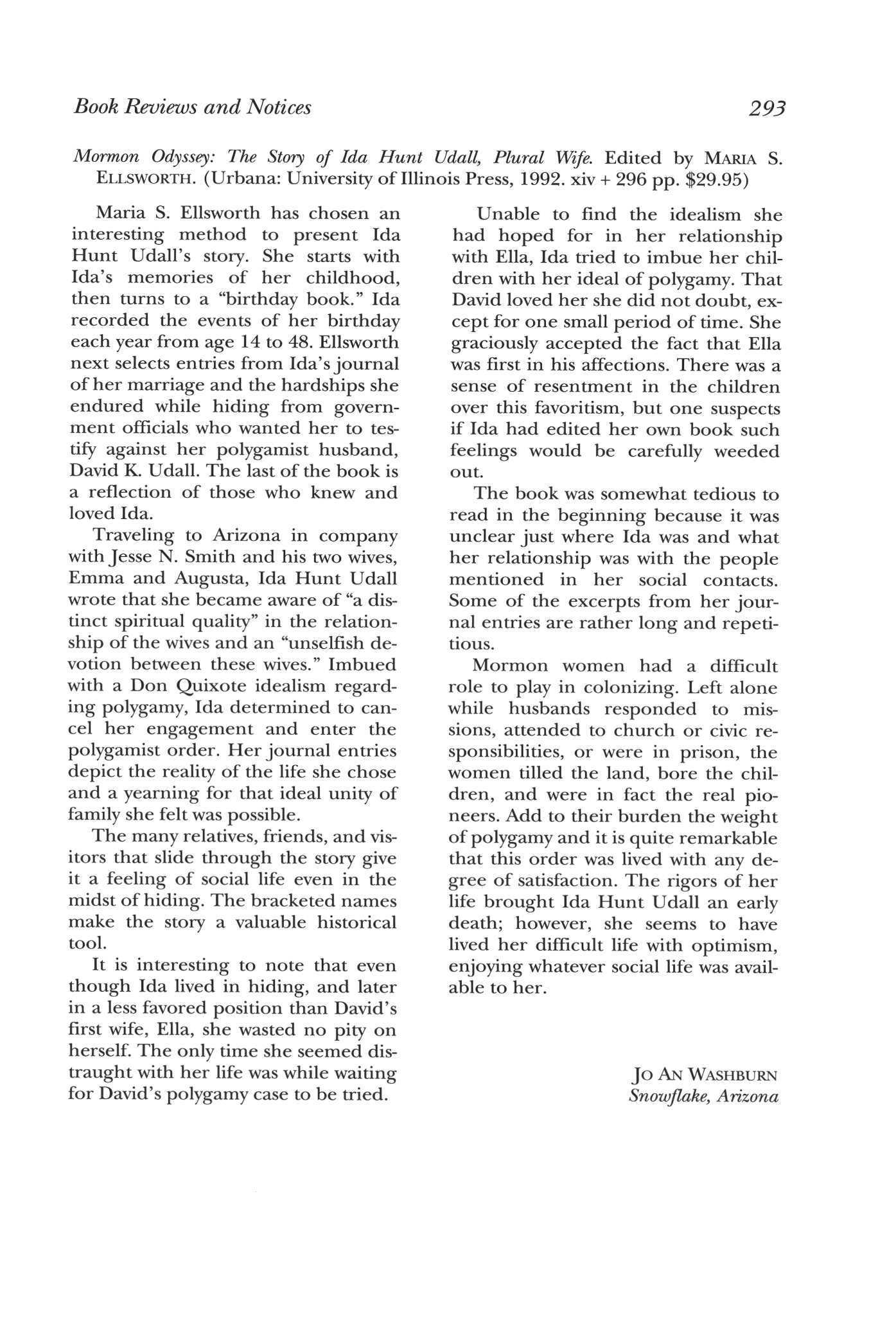
The many relatives, friends, and visitors that slide through the story give it a feeling of social life even in the midst of hiding. The bracketed names make the story a valuable historical tool.
It is interesting to note that even though Ida lived in hiding, and later in a less favored position than David's first wife, Ella, she wasted no pity on herself The only time she seemed distraught with her life was while waiting for David's polygamy case to be tried
Unable to find the idealism she had hoped for in her relationship with Ella, Ida tried to imbue her children with her ideal of polygamy. That David loved her she did not doubt, except for one small period of time. She graciously accepted the fact that Ella was first in his affections. There was a sense of resentment in the children over this favoritism, but one suspects if Ida had edited her own book such feelings would be carefully weeded out
The book was somewhat tedious to read in the beginning because it was unclear just where Ida was and what her relationship was with the people mentioned in her social contacts Some of the excerpts from her journal entries are rather long and repetitious.
Mormon women had a difficult role to play in colonizing. Left alone while husbands responded to missions, attended to church or civic responsibilities, or were in prison, the women tilled the land, bore the children, and were in fact the real pioneers. Add to their burden the weight of polygamy and it is quite remarkable that this order was lived with any degree of satisfaction The rigors of her life brought Ida Hunt Udall an early death; however, she seems to have lived her difficult life with optimism, enjoying whatever social life was available to her
J o A N WASHBURN Snowflake, Arizona
Book Reviews and Notices 293
Book Notices
Presbyterian Missions and Cultural Interaction in the Far Southwest, 1850-1950. By MARK T. BANKER (Urbana: University of Illinois Press, 1993.xiv+225pp. $36.95.)
Starting in the late 1860s the Presbyterian church became increasingly interested in establishing missions among "exceptional people" in the United States Targeted as appropriate candidates for this helping hand were the Pueblo and Navajo peoples of New Mexico and Arizona, the Hispanics of New Mexico and southern Colorado, and the Mormons of Utah. By the late 1800s and early 1900s activity and enthusiasm peaked with twenty-eight missions spread throughout Utah and southern Idaho alone The author examines the effectiveness of these and other sites, emphasizing the problems of cultural interaction and adaptation.
Of particular interest to readers of Utah history are the sections of the book that discuss Presbyterian views of Mormonism, which became particularly pronounced during the years before polygamy ended With a twist of irony it is also instructive to note that while Mormon missionaries pressed forward into surrounding territories and foreign lands, their own home sanctuary was considered an important objective by other denominations Another important theme that runs throughout is the role that women played in supporting both the

organization at headquarters and the teaching in the field
This doctoral thesis turned book is a well-documented account recommended for scholars of religious history, women studies, and Mormon history.
Changing Military Patterns of the Great Plains Indians (17th Century through Early 19th Century). By FRANK SECOY (1953; Bison Book Edition, Lincoln: University of Nebraska Press, 1992. xviii + 112pp.Paper, $7.95.)
This revised doctoral dissertation is an intriguing study of the evolution of Plains Indian warfare between 1630 and 1830.Secoy looks at the advance of the horse frontier from the Hispanic Southwest and the gun frontier from French and English Canada as these material elements moved out onto the plains and eventually combined Changing tactics and equipment forged innovative forms of warfare and shifting alliances that in turn gave rise to a newset of values andaccompanying dynamics associated with nineteenth-century Plains Indian culture. This book, with an excellent introduction byJohn C Ewer, is recommended for students of Native American history and those interested in the mechanics of cultural change.
Book Reviews and Notices 295
The Dispossession of the American Indian, 1887-1934. By JANET A MCDONNELL
(Bloomington: Indiana University Press, 1991.xii+ 163 pp. $20.00.)
The Dawes Allotment Act of 1887 created a process that the federal government hoped would destroy Native Americans' tribal identity, remove the collective reservation land base, and encourage individual farming and stockraising practices. To the white population this act meant opportunities for more land to purchase or lease from Indian property owners The net result of this half-century policy was a "shriveling [Native American] landbase and an economically deprived people" (p. 121).
The topic of this book is important. Written in a scholarly manner, it argues that the effects of the DawesAct have continued, and white ownership of tribal lands prevents Indians from pooling their resources to lift themselves from poverty By studying the ramifications of past government policy, the reader better understands why reservations are still considered a viable lifestyle for Native Americans today
carefully crafted; and some are haunting in their appeal.
Shoshone Tales. Edited by ANNE M. SMITH, assisted by ALDEN HAYES (Salt Lake City: University of Utah Press, 1993. xxxvi + 188 pp. $24.95.)
A companion volume to Ute Tales reviewed on pp 289-90 of this issue, Shoshone Tales features a foreword by Catherine S Fowler and an afterword by Beverly Crum. It contains thirtyfour Gosiute and seventy-nine Western Shoshone selections.
The Old Spanish Trail: Santa Fe to Los Angeles. By LEROY R HAFEN and ANN W. HAFEN. (Lincoln: University of Nebraska Press, 1993.375 pp Paper, $12.95.)
Saanii Dahataa/The Women Are Singing: Poems and Stories. By Luci TAAHONSO. (Tucson: University of Arizona Press, 1993 xiv + 94 pp Cloth, $1995; paper, $9.95.)
This collection of songs and poetry elucidates the thoughts of a modern Navajo woman and her experiences in today's society. Introspective and revealing, these works capture the author's longing for a simpler life centered around family, friends, and tradition. Many of these pieces have been published elsewhere Most are

Thanks to the Hafens the Old Spanish Trail that was once nearly forgotten hasbeen ensured ofits rightful niche in borderlands history Originally published in 1954, this classic study of the "longest, crookedest, most arduous pack mule route in the history ofAmerica" isnowavailable as a Bison Book
Mother's Letters. By ELIZABETH HAMPSTEN. (Tucson: University of Arizona Press, 1993 xiii + 185 pp Cloth, $26.95; paper, $14.95.)
Following the death of her mother in 1970, the author, a professor of English attheUniversity ofNorth Dakota, Grand Forks, received a box of letters her mother had written from various world cities during her husband's
years of diplomatic service The letters gave Hampsten new insights into her mother's life "separate from children." She uses the letters as a reference point to reflect on her own life in a series of autobiographical essays that focus on family relationships. The book expands the range of possibilities for those writing family and personal histories by providing an alternative to the usual chronological format. Moreover, Hampsten reflects on her life experiences in an engaging manner.
Dictionary of the American West. By WINFRED BLEVINS. (New York: Facts on File, Inc., 1993 xiv + 400 pp $35.00.)
Marmalade and Whiskey: British Remittance Men in the West. By LEE OLSON (Golden, Colo.: Fulcrum Publishing, 1993 xix + 234 pp Paper, $16.95.)
The younger sons of British aristocrats were often sent abroad to seek their fortunes with promises of remittances of money from home. Hundreds of these young men—precluded from inheriting the family estate by the rule of primogeniture— migrated to the American West Clement Bengough, for example, was reared and e ucated in luxury by his wealthy English family. Then as a younger son he migrated to America and by 1887 had become a rancher near Laramie, Wyoming. A lonely eccentric, he depended on regular remittances from his family to survive. Though remittance men sometimes became "wild" in the West—plagued by alcoholism, gambling, and scandalous love affairs—the author concludes that they gave the frontier an infusion of money and set lofty standards of dress, culture, and manners in fledgling communities from El Paso to Calgary.
Containing more than 5,000 terms and expressions, this dictionary not only defines words associated with the West but also includes the stories, lore, and history behind them The author perused the vocabularies of people typically left out of the lone cowboy western myth, and thus words borrowed from and created or in common use by Native Americans, African Americans, Hispanics, women, Mormons, French Canadians, immigrants, and missionaries will be found in this volume Blevins, a novelist, spent years poring over journals, biographies, memoirs, old newspapers, and reference works to compile his dictionary. He also consulted many authors and historians
The result of Blevins's diligence is a book many aficionados of the West will want as a bedside companion as well as a reference work It invites browsing, and reading and pondering a few entries may take just enough time to fill the gap between sundown and sleep These examples will give the flavor of the work:

Corduroy (1) Logs (often split logs) laid across soft or wet spots in a road to make them passable for wagons. (2) A road that's been corduroyed It's also known as a hicketycrickety or hunker-chunker. Roads in yellowstone National Park were being corduroyed as late as the turn of the century
Piloncillo In the Southwest, a cone of unrefined brown sugar. This treat was popular with Hispanics and pioneer Anglos. Borrowed from Spanish (where pilon means "sugarloaf'), it's pronounced pee-lohn-SEE-yoh
296 Utah Historical Quarterly
It is all wheat A Utah expression meaning "it's on the square, it's OK."
Brushwork Diary: Watercolors of Early Nevada. By WALTER S LONG
, MICHAEL J BRODHEAD, and JAMES C MCCORMICK (Reno:
University of Nevada Press, 1991 xv + 118 pp $24.95.)
Born in Baltimore in 1842, Long served in the Union army and ultimately came to Nevada where, during 1878-80, he made 64 postcard-size watercolor sketches of remote Nevada scenes. The paintings depict mines, street scenes, ajoss house, scenery, and interior views of offices, mines, cabins, and workshops He intended the sketches to depict his life in Nevada for Elizabeth Parker of Boston, the woman he loved but never married Because of his training as a civil engineer, Long produced sketches that—though not treasures of high art—do represent a unique visual documentation of Nevada Brodhead and McCormick have performed a service to history with this attractive presentation.
women's roles, missionary work and the growth of the church, relationships within the congregation, and individual testimonies
The book began as part of a larger project of the Elkton Ward in the industrial town of Elkton, Maryland. Richard L. Bushman, the ward's bishop and also a professor of history at the University of Delaware, along with his wife Claudia, a historian and executive director of the Delaware Heritage Commission, wanted to collect materials pertinent to life in a typical LDS ward for the use of future researchers Thus the Elkton Ward Record Year Committee was formed and many aspects of ward life recorded Taber worked on the oral history part of the project
Mormon Lives: A Year in the Elkton Ward. By SUSAN BUHLER TABER (Urbana: University of Illinois Press, 1993. vii + 376 pp. $27.50.)
This unique cultural study presents a candid picture of what it is like to be a Mormon. Using oral histories collected from more than a hundred church members from diverse congregations in Maryland and Delaware, the author places them within narratives of church activities during a typical year These ordinary ward members reflect on agreements and disagreements with church practices,
The collected materials were archived at Brigham Young University, but Bushman believed they had publication potential as well. At his suggestion Taber used the data to produce a portrait of life in the Elkton Ward, a microcosm of the LDS church outside Utah and a more typical Mormon way of life—far from church headquarters—than is commonly depicted The cumulative effect of each individual interviewee relating his or her spiritual quest within the Mormon framework might be compared to a musical composition full of idiosyncrasies and dissonances that somehow create an amazing whole.
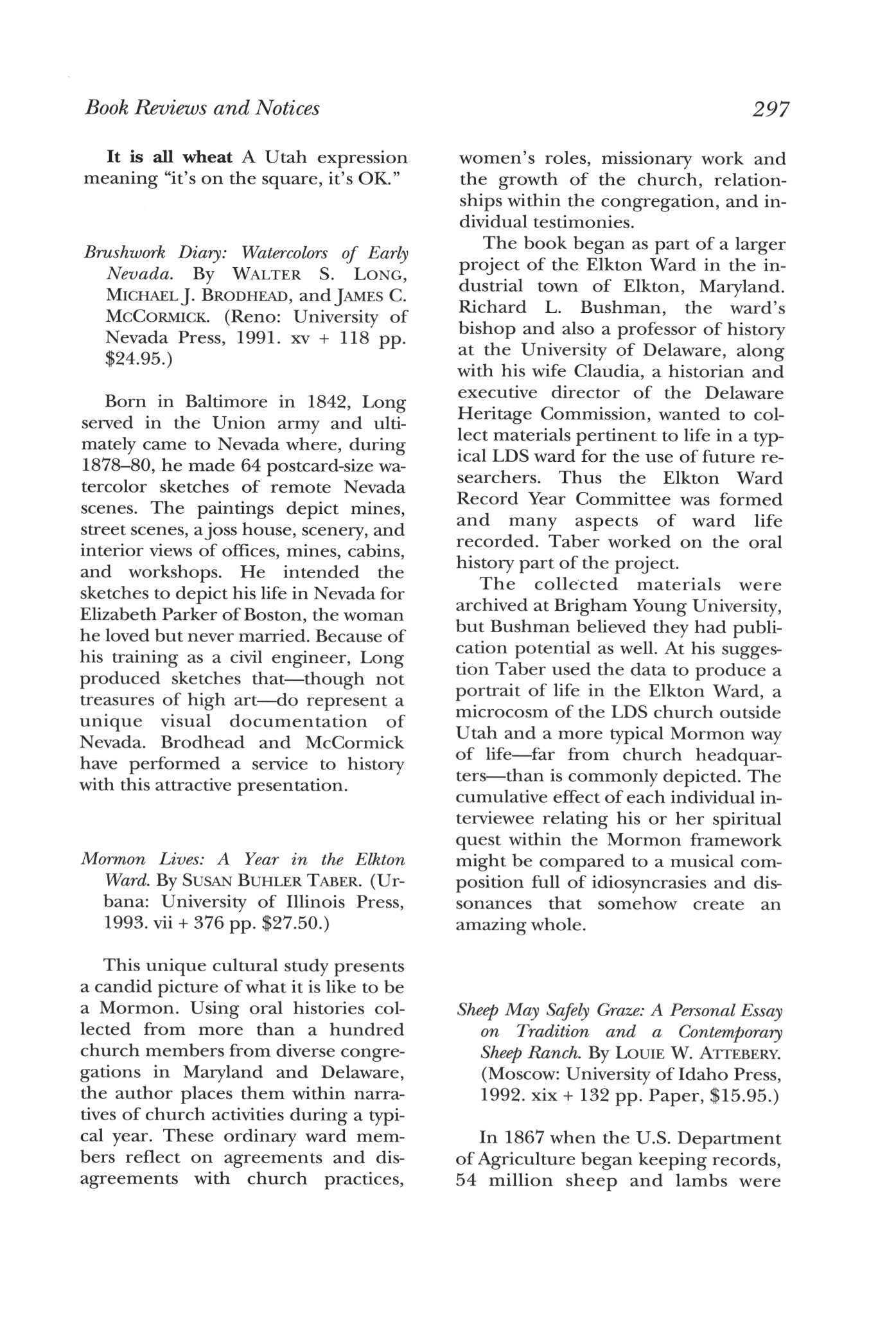
Sheep May Safely Graze: A Personal Essay on Tradition and a Contemporary Sheep Ranch. By LOUIE W ATTEBERY (Moscow: University of Idaho Press, 1992 xix + 132 pp Paper, $15.95.)
In 1867 when the U.S Department of Agriculture began keeping records, 54 million sheep and lambs were
Book Reviews and Notices 297
tallied. In 1986 the tally was 10.5 million With fewer and fewer examples of sheep ranching to be found, folklorist Louie W. Attebery examined the context of a contemporary Idaho sheep ranch and the traditions of three generations in an American livestock family named Soulen.
In following the season-to-season flow of a sheep ranching operation and the day-to-day tasks involved, Attebery noted the variability that occurs within tradition and demonstrates the dynamic nature of tradition. The movement of sheep from summer to winter ranges; shearing, lambing, marking, and associated activities; the life of a sheepherder; and the sheep and cattle "wars" are among the subjects deftly dealt with Numerous photographs document aspects of sheep raising and help the lay person gain a clearer idea of what is involved. This is a highly readable work on a subject of great significance in western history
The Wealth of Nature: Environmental History and the Ecological Imagination. By DONALD WORSTER (New York: Oxford University Press, 1993 xi + 255 pp $25.00.)
Winner of the prestigious Bancroft Prize in American History for his landmark study Dust Bowl: The Southern Plains in the 1930s, Donald Worster brings together in his latest work a group of reflective essays on the mutual dependence of humans and the environment. He argues persuasively for a comprehensive approach to understanding the past as well as the future in environmental terms.
Chapter/essay titles include, for example, "History as Natural History," "Arranging a Marriage: Ecology and Agriculture," "The Kingdom, the Power, and the Water" (with kudos
for Leonard J. Arlington's Great Basin Kingdom), "The Shaky Ground of Sustainable Development," and 'John Muir and the Roots of American Environmentalism"—representing about a third of the topics.

Using Aldo Leopold's approach— which stressed the importance of nature in determining human history— as a point of departure, Worster views history as a dialogue between humanity and nature He also reminds historians that environmental history is not limited in scope to rural and wilderness areas. Cities clearly have had a tremendous impact on the land
Playing Cowboys: Low Culture and High Art in the Western. By ROBERT MURRAY DAVIS (Norman: University of Oklahoma Press, 1992 xxiv + 168 pp $19.95.)
Davis begins by focusing on The Virginian and the origins of the western hero He then moves to a discussion of how novelists and filmmakers in the post-World War II era have used the western to discuss issues of ethics and aesthetics and how their works have affected popular cultural values Davis believes that the western is not primarily about escape or violence but, at its best, is about the courage of the hero to go beyond the established boundaries—to "reimagine" himself Although women appear in westerns, often as proponents of "civilization," the genre typically portrays a man's world and thus offers an important view of the American masculine mystique.
Frederic Remington's Southwest. ByJAMES K BALLINGER (Phoenix: Phoenix Art Museum, 1992 vi +94 pp.)
This is a handsome catalog that accompanied an exhibit of Remington's
298 Utah Historical Quarterly
Southwest drawings and paintings in Phoenix and two other locations in 1992 Ballinger provides an insightful narrative to complement the visual images.
Owning Western History: A Guide to Collecting Rare Documents, Historical Letters, and Valuable Autographs from the Old West. By WARREN R. ANDERSON. (Missoula: Mountain Press Publishing Co., 1993 vii + 118 pp Paper, $15.00.)

Warren Anderson, a professional collector/dealer and the proprietor of American West Archives in Cedar City, has used his years of experience to produce a guide for the uninitiated in the fast-growing field of collecting western American paper: stock certificates, bonds, mining claims, letters, bank drafts, deeds, receipts, and so on The guide provides step-by-step instructions in what to look for when examining old documents, whether they are from one's own family collection or offered for sale by others, and how to care for them properly Auction tips, ownership transferral options, and stories of fakes, forgeries, and theft add to the guide's usefulness as do the appendices, glossary, and photographs
Lee's Ferry: Desert River Crossing. By W L RUSHO and C GREGORY CRAMPTON. (Salt Lake City: Cricket Productions, 1992. xii + 168 pp. Paper, $14.95.)
Founded byJohn D Lee in the early 1870s, Lee's Ferry served as the Colorado River's most famous crossing for over a half-century. Its colorful career affected thousands of lives and left an indelible mark on the literature, lore, and history of Canyon Country Re-
vised and expanded over its initial 1975 printing, this attractive paperback is replete with photos and maps. It brings the history of the site to the present, includes a tour guide to historic sites of the area, tempts the reader with a nicely annotated bibliography, and in every respect reflects admirably on the reputation of the authors as two of the very best red-rock historians.
Fremont: Pathmarker of the West. By ALLAN NEVINS (Lincoln: University of Nebraska Press, 1939, 1955, 1992. xiv + 689 pp. Paper, $19.95.)
Published in 1928 under the title of Fremont, the West's Greatest Adventurer, this study was the first worthy biography of John C Fremont Revised twice, it has stood the test of time and is now available as a Bison Book.
Students of the nineteenth-century American West will readily subscribe to the author's studied understatement that Fremont touched history at many points. Utahns will take special delight in reading of the fifth expedition, 1853-54, and the role played by settlers of Parowan in its ultimate success But of course it will always be the fourth expedition, 1848-49, with its incredible saga in the Southern Rockies, that dominates any account of Fremont the pathmarker The accomplished Nevins, who describes Fremont as "a personality brilliant, versatile, and adventurous [whose] career abounded in almost melodramatic alterations of good and bad fortunes," certainly does itjustice
Annie Oakley. By SHIRL KASPER (Norman: University of Oklahoma Press, 1992 xvi + 288 pp $22.95.)
As a legendary figure Annie Oakley has had a popular image at odds with
Book Reviews and Notices 299
reality, largely because of the popular Broadway musical Annie Get Your Gun. Ethel Merman enjoyed great success as Annie on stage, belting out hit songs like "You Can't Get a Man with a Gun" and "There's No Business Like Show Business." But brash Ethel Merman bears no resemblance to the historic Annie Oakley.
Although Annie was not a female version of that western male stereotype, the swaggering stranger in town who is handy with a revolver, neither was she a sweet young thing The historic Annie, reared in poverty and eager to leave it behind, was competitive and determined to succeed, and she did; but she was prim and proper, conservative, hard working, frugal, and proud of being accepted by the society of her time as a "lady."
A world-famous sharpshooter, she also radiated a natural charm that endeared her to audiences Her husband Frank Butler, a sharpshooter who initially shared a billing with Annie, realized her greater talents and devoted himself to her career at the expense of his own. Theirs was a love match that lasted forty-five years with Frank dying just eighteen days after Annie in November 1926.
Oakley starred in Buffalo Bill's Wild West show for seventeen years, capturing the fancy of countless ordinary folks as well as Sitting Bull and European royalty When she was not on stage she hunted, shot trap, and entered many shooting matches. During World War I she performed for U.S. troops, and in her retirement years taught many women how to use a gun. She simply loved to shoot.
George Wingfield: Owner and Operator of Nevada. By C ELIZABETH RAYMOND (Reno: University of Nevada Press, 1992. x +350 pp. $31.95.)
George Wingfield made his fortune in the gold fields of central Nevada Unlike the Comstock millionaires who chose to live in California, he preferred to remain in his adopted state where he dominated politics so thoroughly in the 1920s that both the Republican and Democratic parties marched to his tune
Fiscally conservative but socially liberal, he turned down a chance to become a U.S senator and instead devoted his energies to charting the course of Nevada's economic and social development He recognized that mining and agriculture could not sustain the state and worked to develop a tourist-oriented economy by promoting good roads, luxury hotels, horse racing, legalized gambling, and lenient divorce laws Naturally such a man was controversial
Elizabeth Raymond, associate professor of history at the University of Nevada, Reno, spent years organizing the Wingfield papers at the Nevada Historical Society Her highly readable biography presents a balanced account of the man revered as "Nevada's benevolent friend" and condemned as a "Sagebrush Caesar." Sixty-three pages of endnotes demonstrate the extent and depth of her research

300 Utah Historical Quarterly
UTAH HISTORICAL QUARTERLY
Department of Community and Economic Development Division of State History
BOARD OF STATE HISTORY
MARILYN CONOVER BARKER, Salt Lake City, 1997 Chair
PETER L Goss, Salt Lake City, 1995 Vice-Chair
MAX J EVANS, Salt Lake City Secretary
DALE L BERGE, Provo, 1995
BOYD A BLACKNER, Salt Lake City, 1997
DAVID D HANSEN, Sandy, 1997
CAROL CORNWALL MADSEN, Salt Lake City, 1997
DEAN L MAY, Salt Lake City, 1995
CHRISTIE SMITH NEEDHAM, Logan, 1997
PENNY SAMPINOS, Price, 1995
THOMAS E SAWYER, Orem , 1997
JERRY WYLIE, Ogden , 1997
ADMINISTRATION
MAX J EVANS, Director
WILSON G MARTIN, Associate Director
PATRICIA SMITH-MANSFIELD, Assistant Director
STANFORD J LAYTON, Managing Editor
DAVID B MADSEN, State Archaeologist
Th e Utah State Historical Society was organized in 1897 by public-spirited Utahn s to collect, preserve, an d publish Uta h an d related history. Today, unde r state sponsorship, th e Society fulfills its obligations by publishing th e Utah Historical Quarterly an d othe r historical materials: collecting historic Uta h artifacts; locating, documenting , an d preserving historic an d prehistoric buildings an d sites; an d maintainin g a specialized research library Donation s an d gifts to the Society's programs , museum , or its library ar e encouraged, for only throug h such mean s ca n it live u p to its responsibility of preserving th e recor d of Utah' s past
This publication has been funded with the assistance of a matching grant-in-aid from the Department of the Interior, National Park Service, under provisions of the National Historic Preservation Act of 1966 as amended
This program receives financial assistance for identification and preservation of historic properties under Tide VI of the Civil Rights Act of 1964 and Section 504 of the Rehabilitation Act of 1973 The U.S Department of the Interior prohibits discrimination on the basis of race, color, national origin, or handicap in its federally assisted programs If you believe you have been discriminated against in any program, activity, or facility as described above, or if you desire further information, please write to: Office of Equal Opportunity, U.S Department of the Interior, Washington, D.C 20240

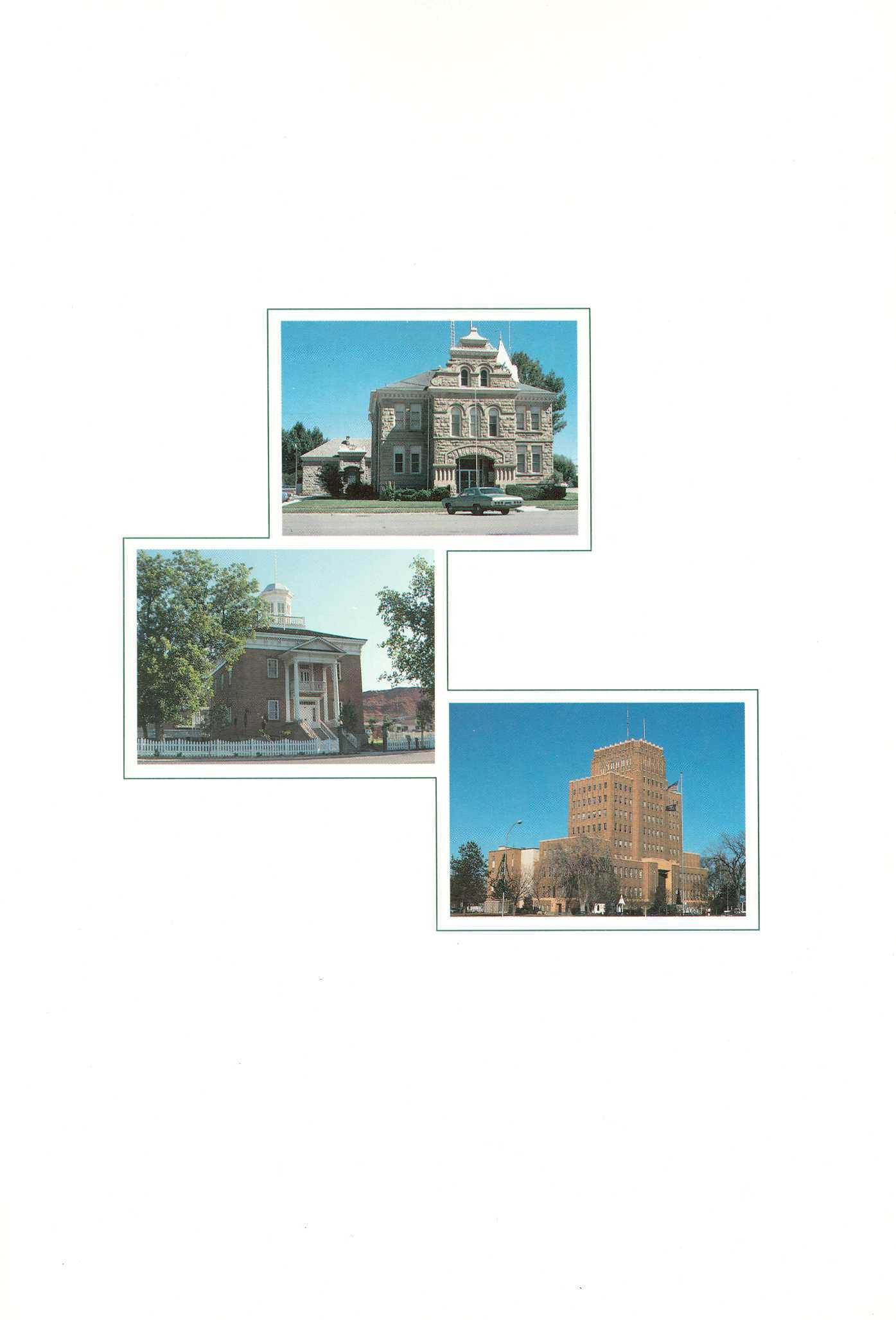




 Utah Bar Foundation standing: Carman E. Kipp, Kipp & Christian; Richard C. Cahoon, Marsden, Orion & Cahoon; James B. Lee, Parsons Behle & Latimer; Stephen B. Nebeker, Ray, Quinney & Nebeker; seated: Ellen M. Maycock, Kruse, Landa & Maycock; Hon. Norman H. Jackson, Utah Court of Appeals; Jane A. Marquardt, Marquardt, Hasenyager & Custen.
Photograph by Robert L. Schmid.
Utah Bar Foundation standing: Carman E. Kipp, Kipp & Christian; Richard C. Cahoon, Marsden, Orion & Cahoon; James B. Lee, Parsons Behle & Latimer; Stephen B. Nebeker, Ray, Quinney & Nebeker; seated: Ellen M. Maycock, Kruse, Landa & Maycock; Hon. Norman H. Jackson, Utah Court of Appeals; Jane A. Marquardt, Marquardt, Hasenyager & Custen.
Photograph by Robert L. Schmid.

 BY CAROL CORNWALL MADSEN
BY CAROL CORNWALL MADSEN
























 Samuel R. Thurman. USHS collections.
Dr Alley is editor of Utah State University Press
Samuel R. Thurman. USHS collections.
Dr Alley is editor of Utah State University Press















 BY J ALLAN CROCKETT
BY J ALLAN CROCKETT

















 This 1930s aerial view shows the location of the Utah County Courthouse in the heart of downtown Provo.
This 1930s aerial view shows the location of the Utah County Courthouse in the heart of downtown Provo.



 RetiredJuvenile CourtJudge Rulon W. Clark, left, received
scrollfrom Gov. George D. Clyde in honor of his service, Salt
Lake Tribune photograph.
RetiredJuvenile CourtJudge Rulon W. Clark, left, received
scrollfrom Gov. George D. Clyde in honor of his service, Salt
Lake Tribune photograph.








 BY DON V. TIBBS
BY DON V. TIBBS









 ALAN D. REED Montrose, Colorado
ALAN D. REED Montrose, Colorado




















